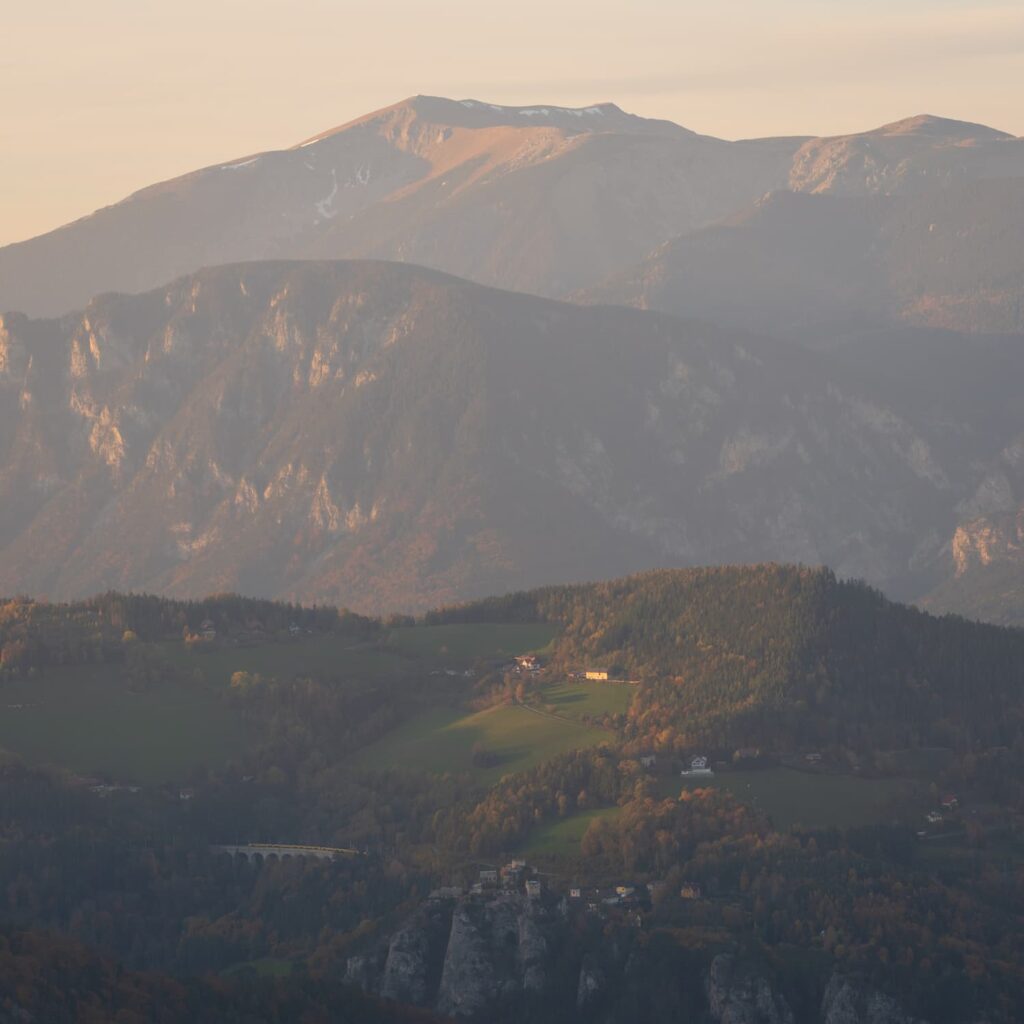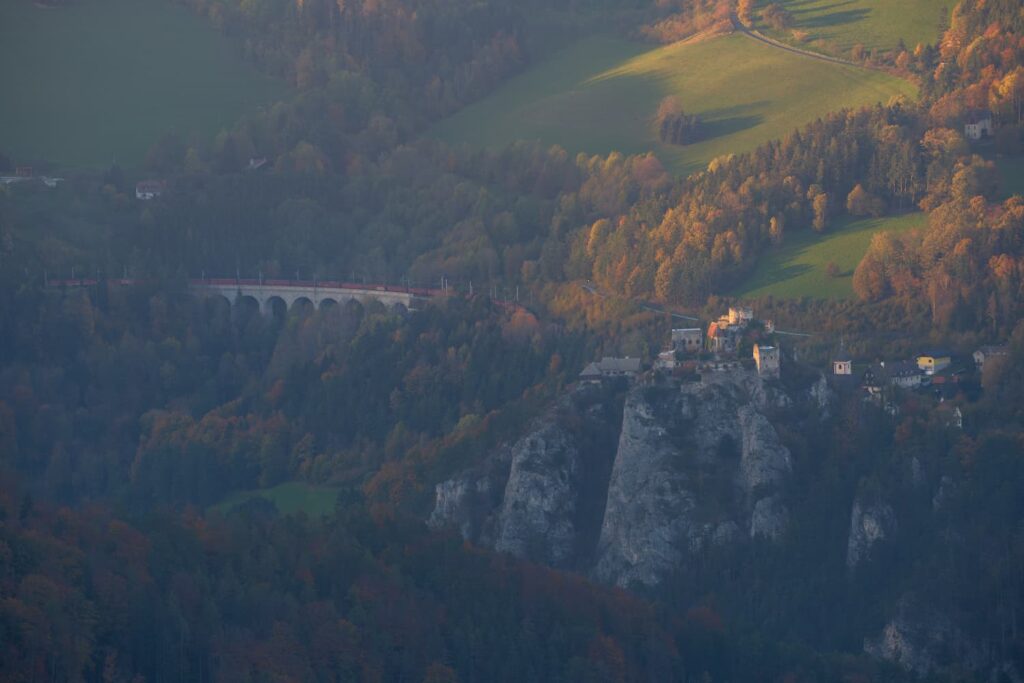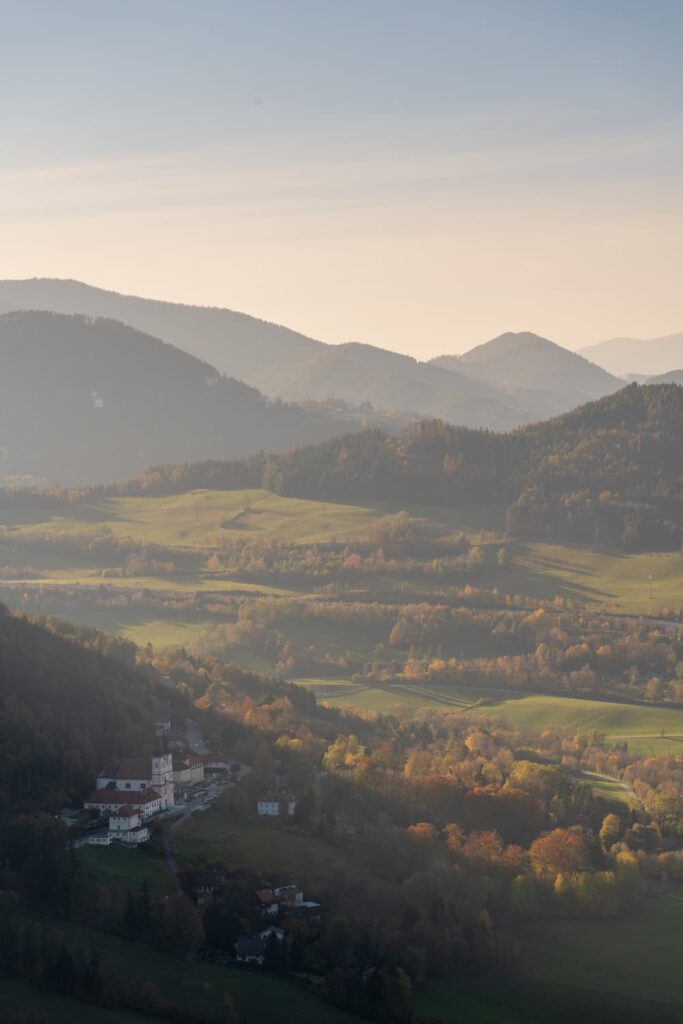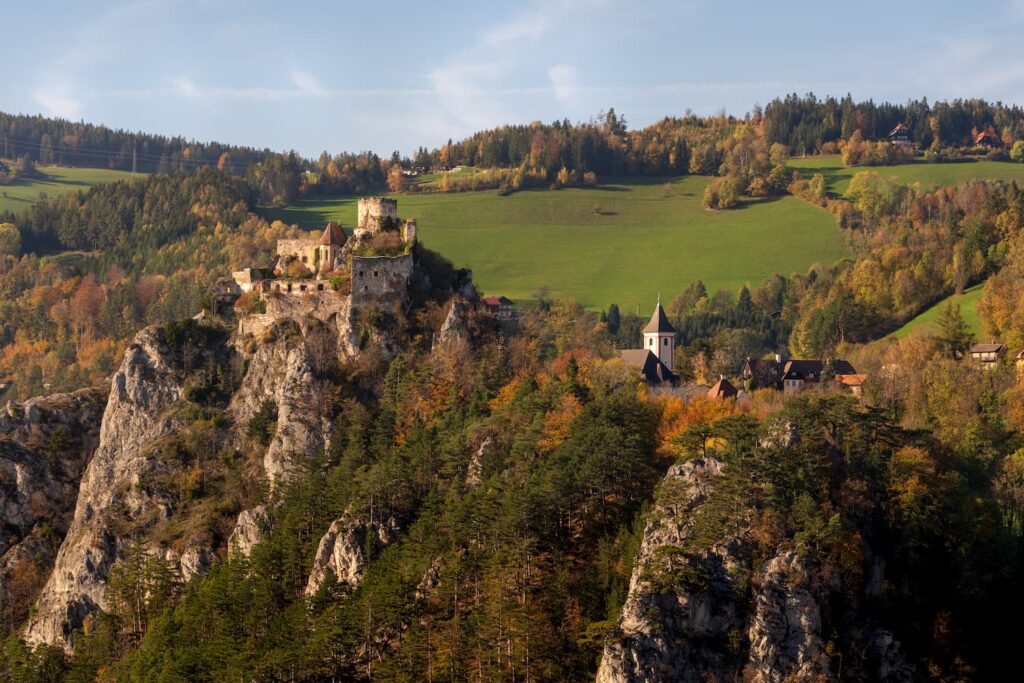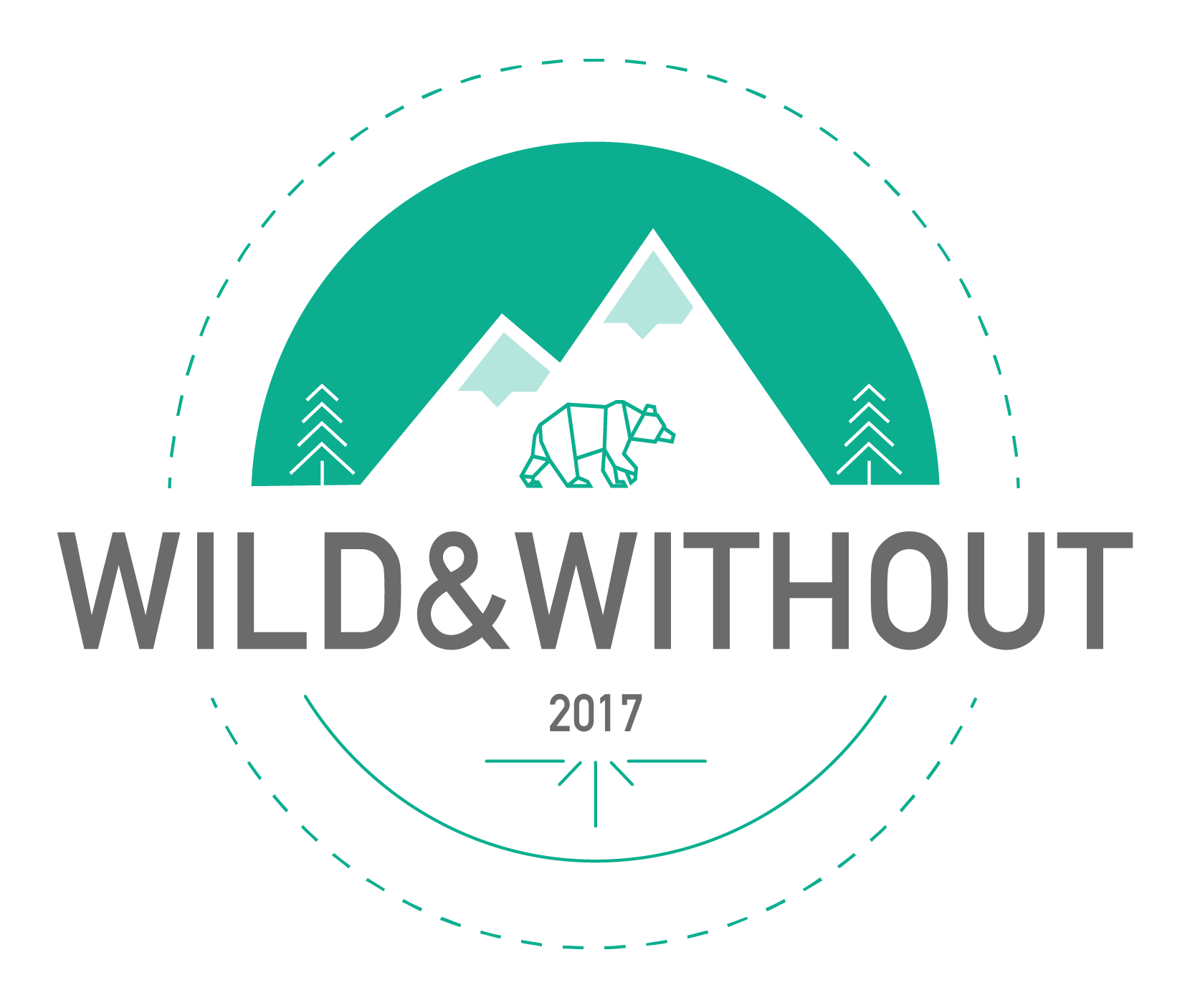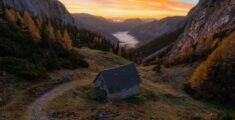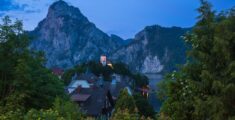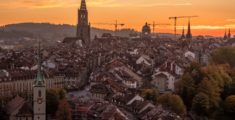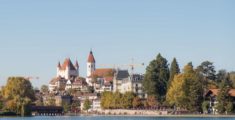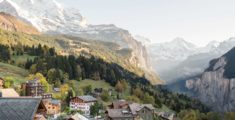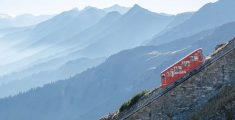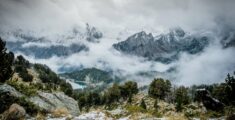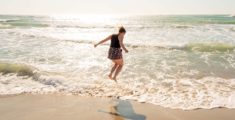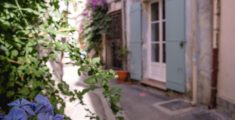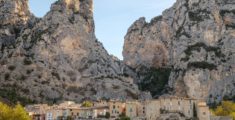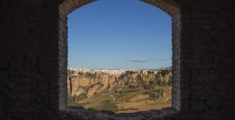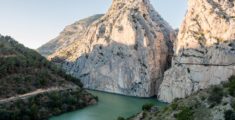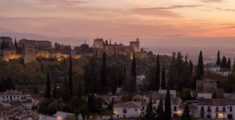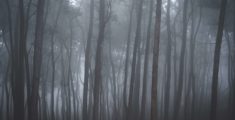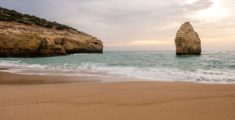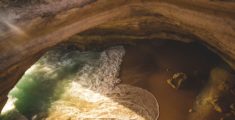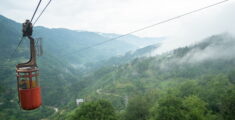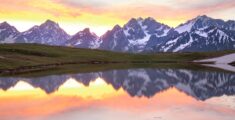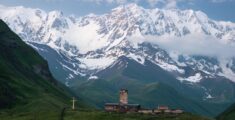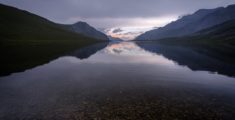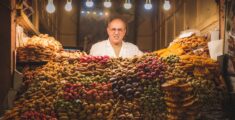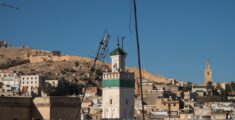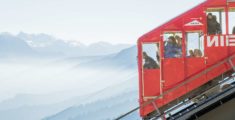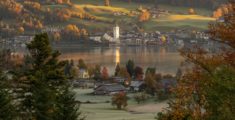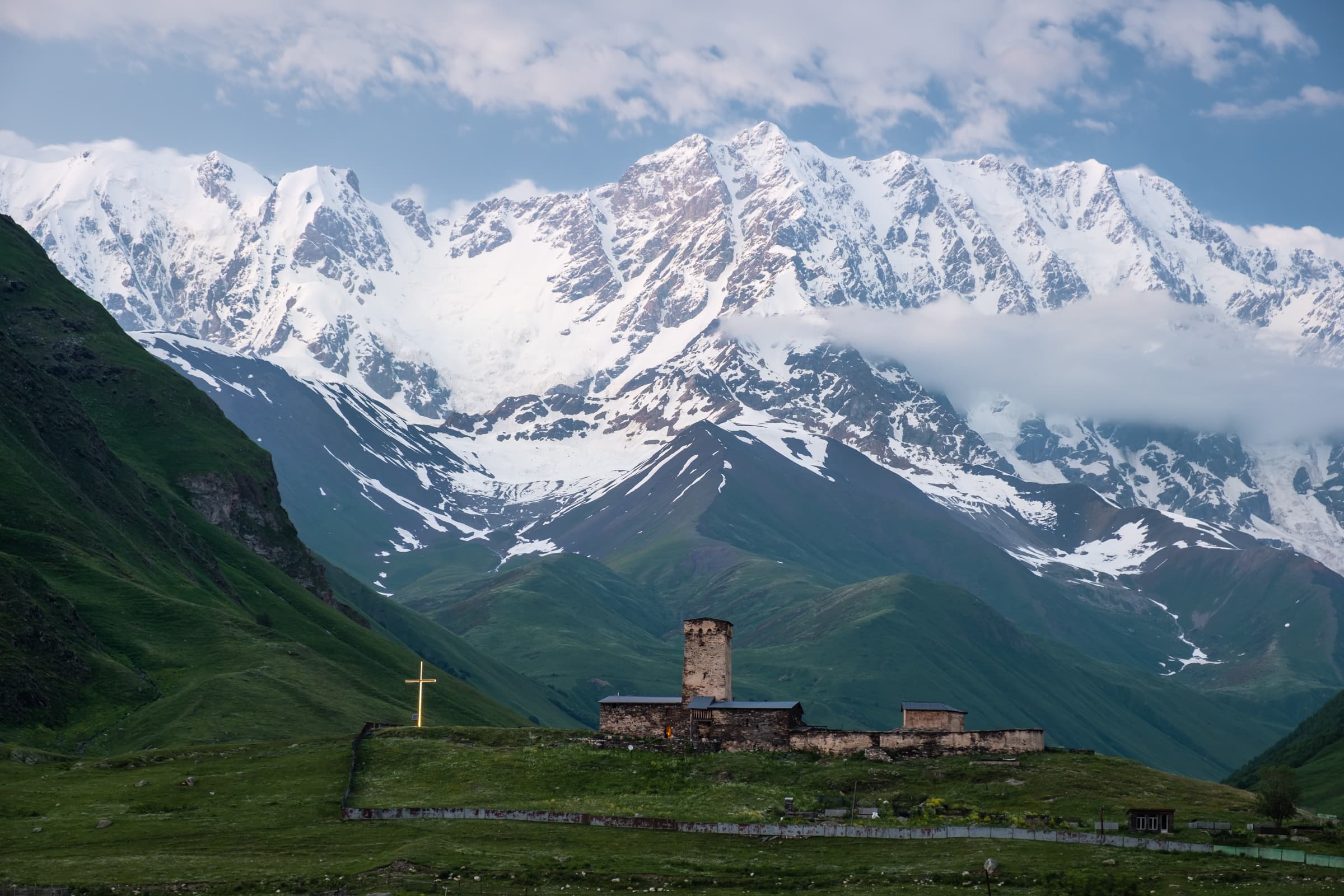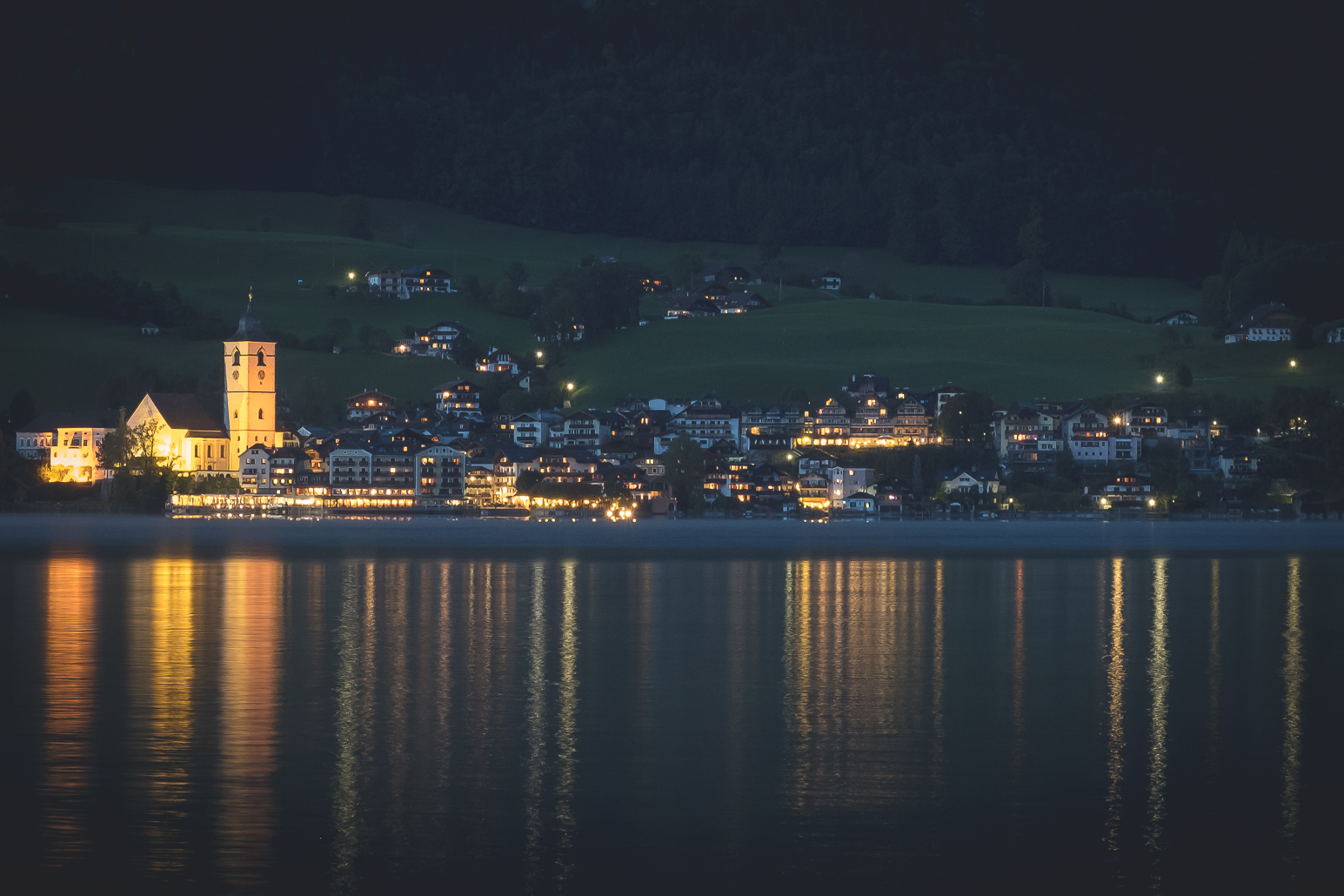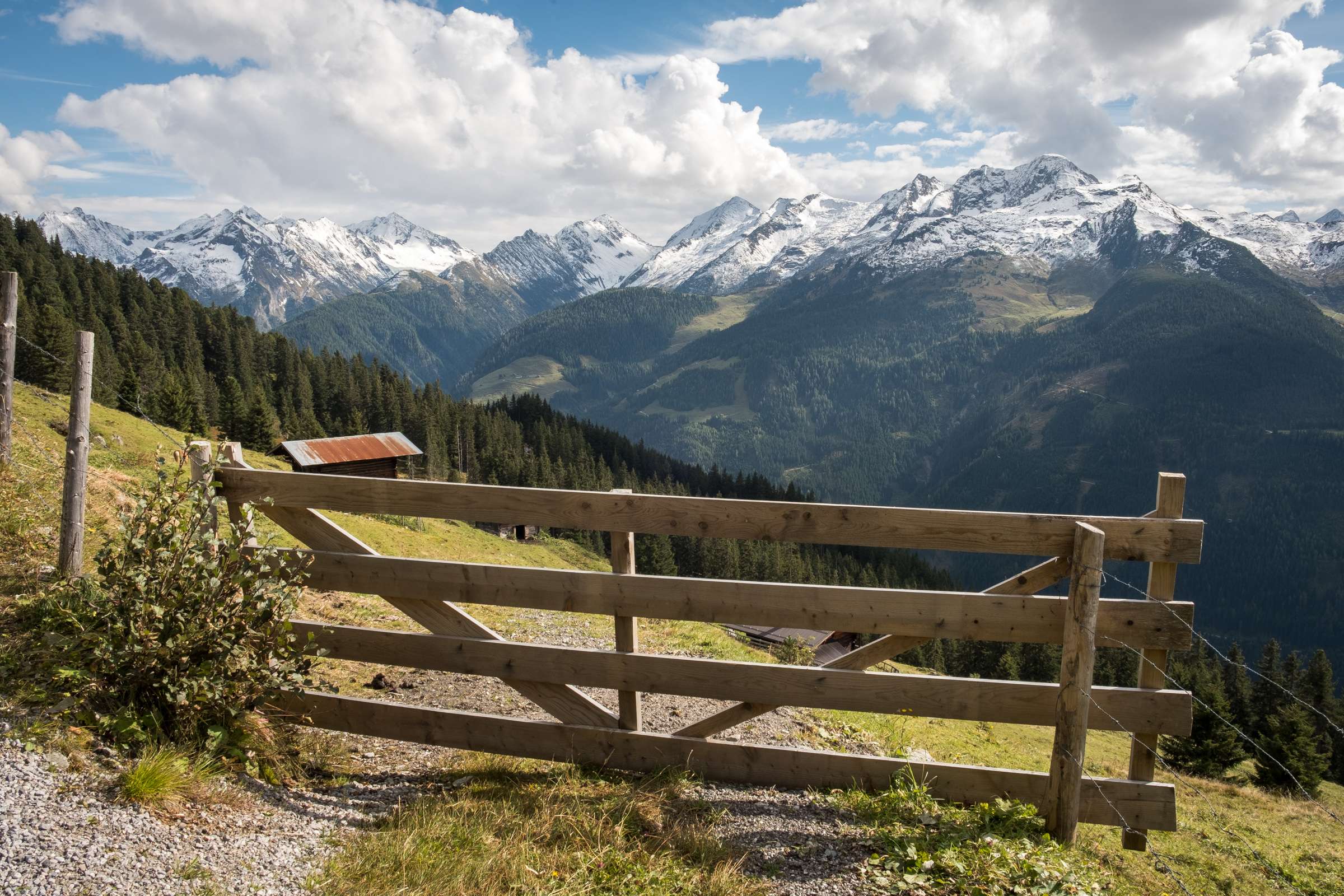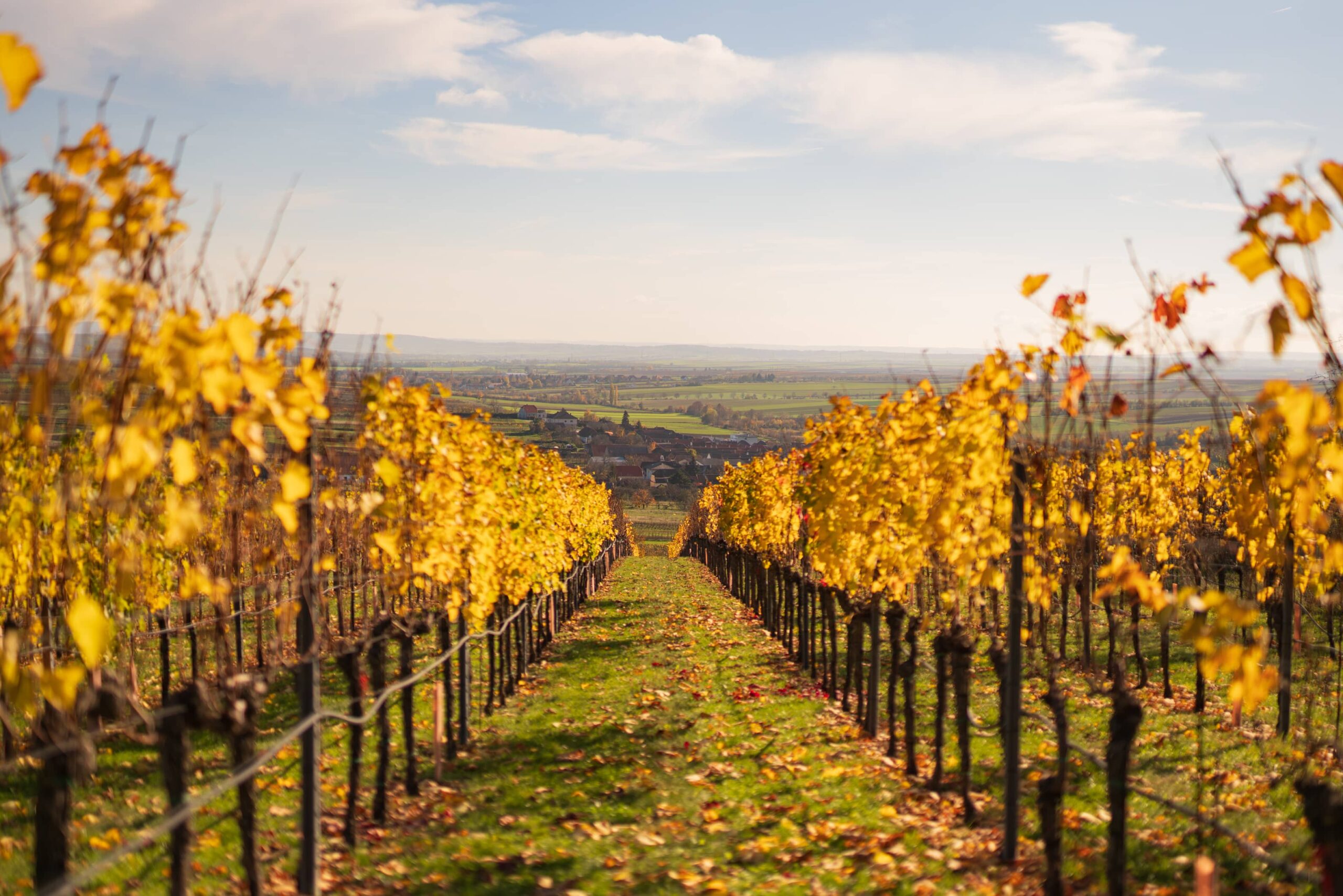120 photos showcasing the beauty of Autumn in Austria
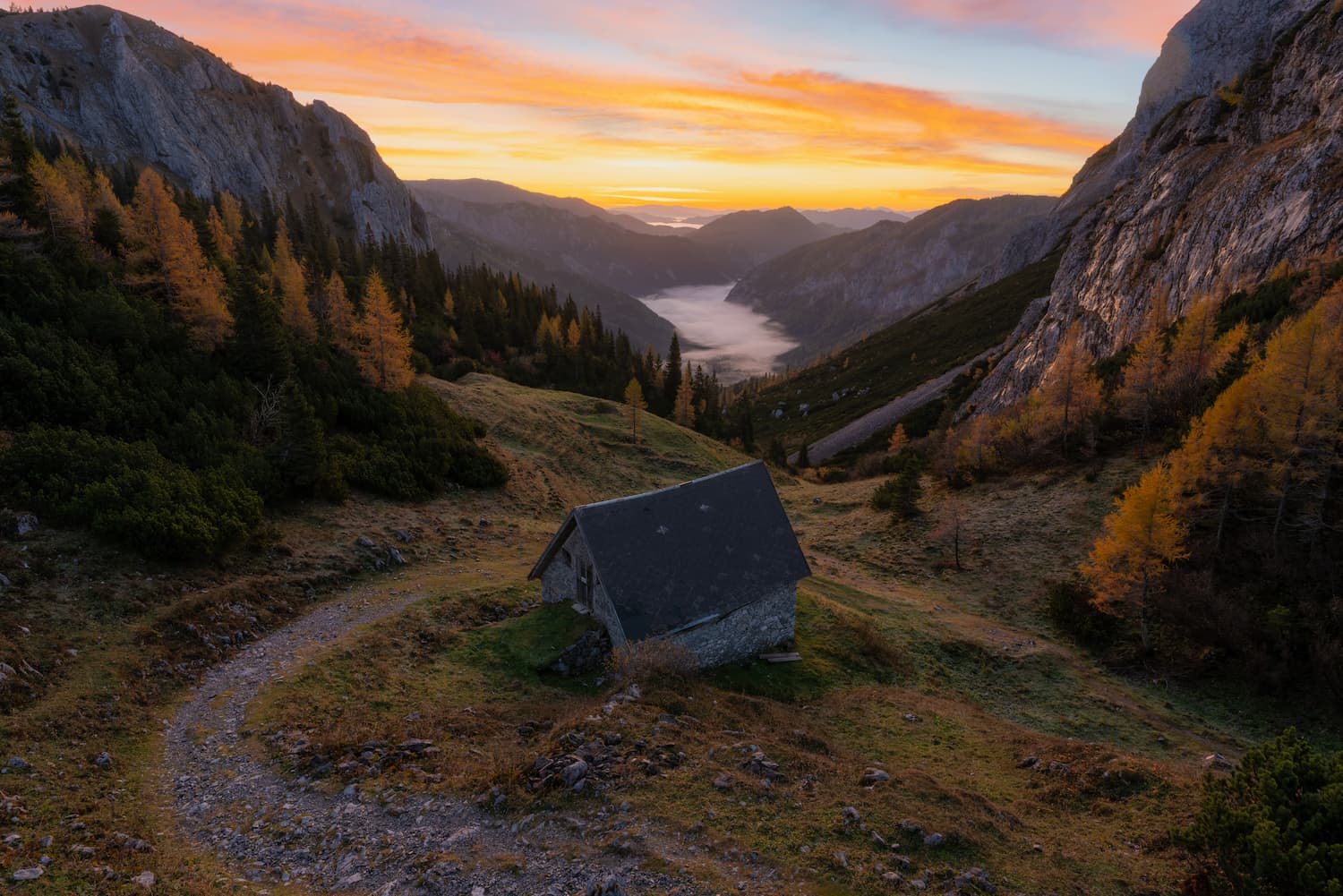
Autumn is the best season of the year, period. Yeah it’s a bold statement, but if we were to just finish here with the rambling and leave you to enjoy the photos, we think you’d agree – scroll on through this post and see for yourself.
Of course, we want to be a little more informative so you we won’t really finish here – but you know, pictures paint a thousand words and all that.
For those that don’t know: Austria is a small alpine country in the middle of Europe, famed for its mountains, lakes, skiing, music, high quality of living, the Habsburg empire and finally a few other events. Austria is our home, and since we’ve gotten around a fair bit, we’d love to show you some of our favourite places, especially during autumn.
We’ve got a bit of everything: Vienna and its surroundings, national parks, mountains, lakes, long distance hikes, cute villages, wine walks, cycling adventures, castles, getaways and more. So let’s dive in!
Table of contents
- Lake Wolfgangsee
- Salzkammergut – The Austrian lake district
- The Wachau – UNESCO World Heritage Site
- Lunz am See
- Kremstal
- Kellergassen – Wine traditions
- Schneeberg – The largest mountain in Lower Austria
- The Karwendel Alps
- The city of Vienna
- Autumn around Vienna
- Luchs trail (Lynx trail) – Long distance hiking
- Gesäuse National Park
- Hochschwab Mountains
- Innsbruck
- Südsteiermark – Wine Country
- Middle Carinthia (Mittelkärnten)
- Puster Valley
- Semmering – Historic mountain resort
Lake Wolfgangsee
Wolfgangsee is in the Salzkammergut region of Austria: It’s famous for its many lakes and towering peaks, Hallstatt and the Sound of Music, eurgh. Our first foray into Salzkammergut was in 2016 when we visited Hallstatt in November, the heart of autumn. Then we visited Wolfgangsee in 2017 while hitchhiking through Europe. Back then Hallstatt was not so busy in November. November is a bit of a sweet spot, end of autumn and just before the winter season starts. It was almost completely devoid of people but the scenery and conditions were out of this world, especially in the glacier garden. Anyway, Hallstatt is very busy all year around now. We wrote a post about alternative villages in Austria to rival Hallstatt, check it out if you’re looking for that idyllic lake side alpine charm but want to avoid the crowds!
Anyway, one of our alternatives is Sankt Wolfgang, the village, and pretty much the whole of lake Wolfgangsee, with all its villages and attractions.
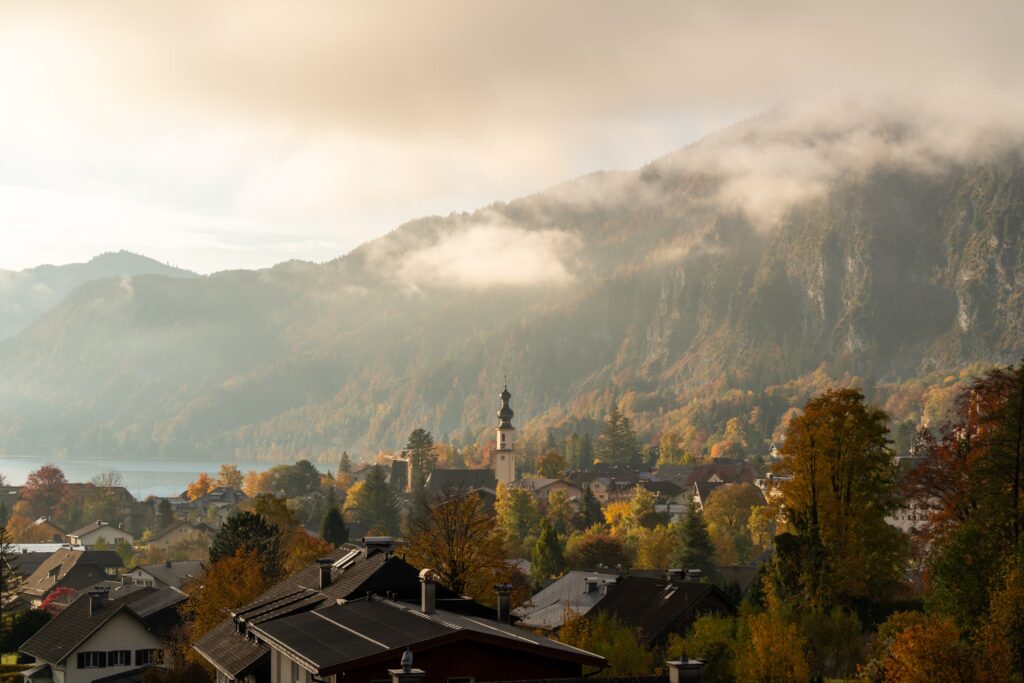
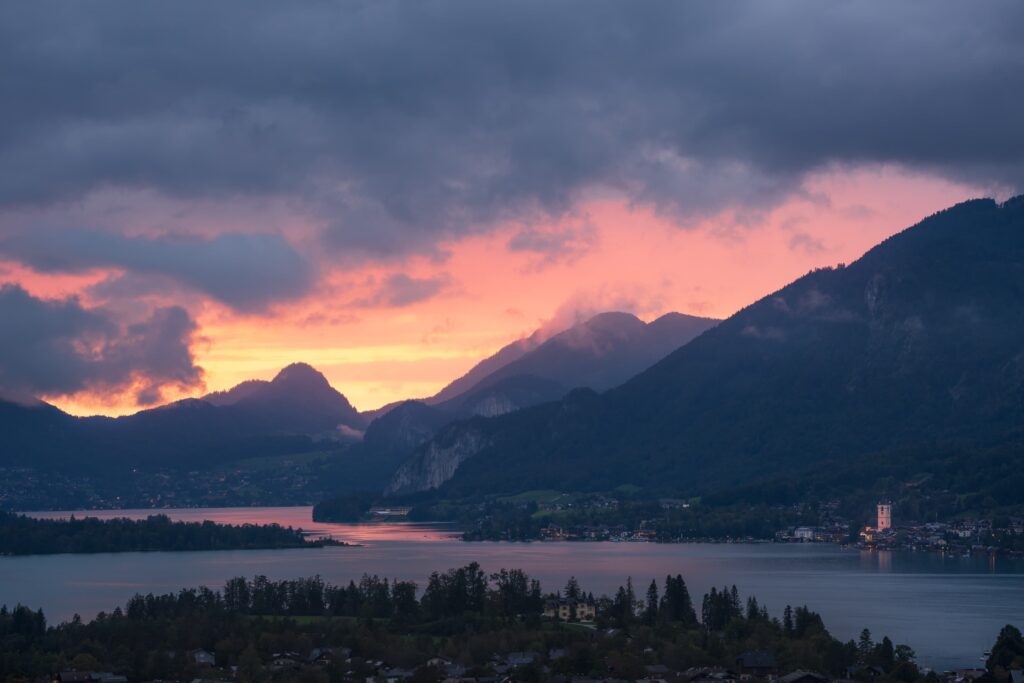
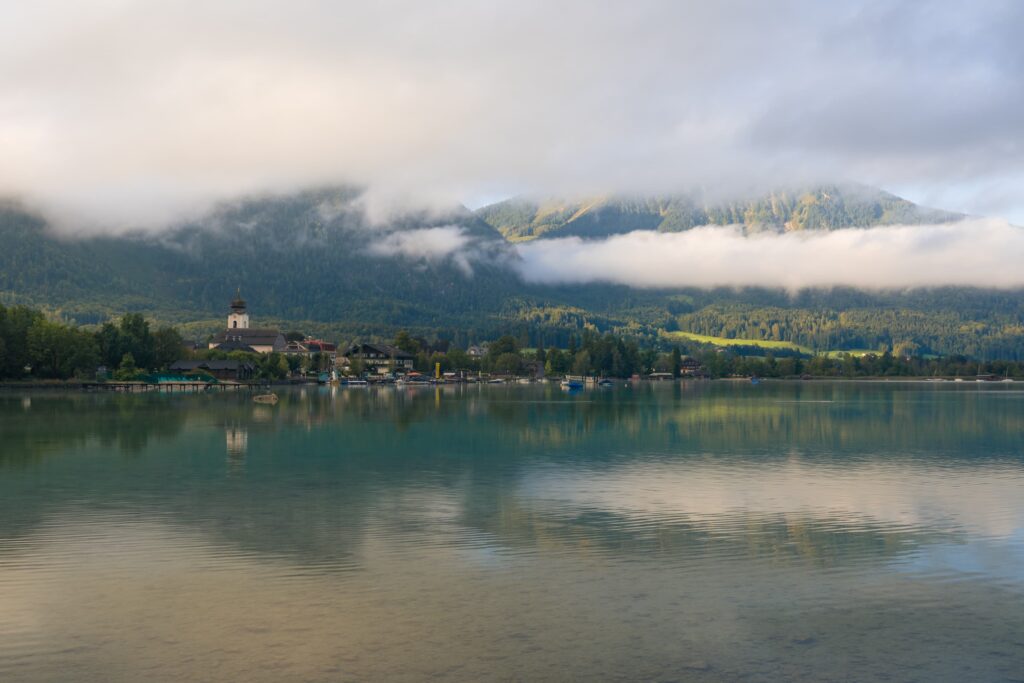

What to do around Wolfgangsee
- Schafbergbahn – A narrow gauge cog railway travelling all the way to the top of Schafberg with views over the whole Salzkammergut. Visit our post about Wolfgangsee for more details.
- A chapel in the rock – Close to St Gilgen you can hike to a chapel built directly into the rock face. There are also some nice views points in the area. Check out this hike or this one which is a bit easier.
- Strobl board walk round – A romantic walk around the small Bürgl mountain on wooden boardwalks with pebble beaches.
- Zwölferhorn cable car – It’s open all year round and there are hiking trails for all seasons. Check the website for more details.
- Secret beach – We found this while walking from Strobl. Maybe it’s not a secret but we visited twice and there was no one there on either occasion.
- Plenty of other hiking trails. Some that we enjoyed:
Salzkammergut – The Austrian lake district
Now we move on to the general area of Salzkammergut, because there is so much more to see than Hallstatt and Wolfgangsee. You could spend a lifetime exploring the region. Driving, hiking, bike riding, swimming (maybe not in autumn), lazing, you name it. The weather can be incredible still in October, with temperatures frequently rising up to the mid 20’s. In the mountains, however, it can get colder, and there might be snowfall, as can be seen later in the post in the Innsbruck section.
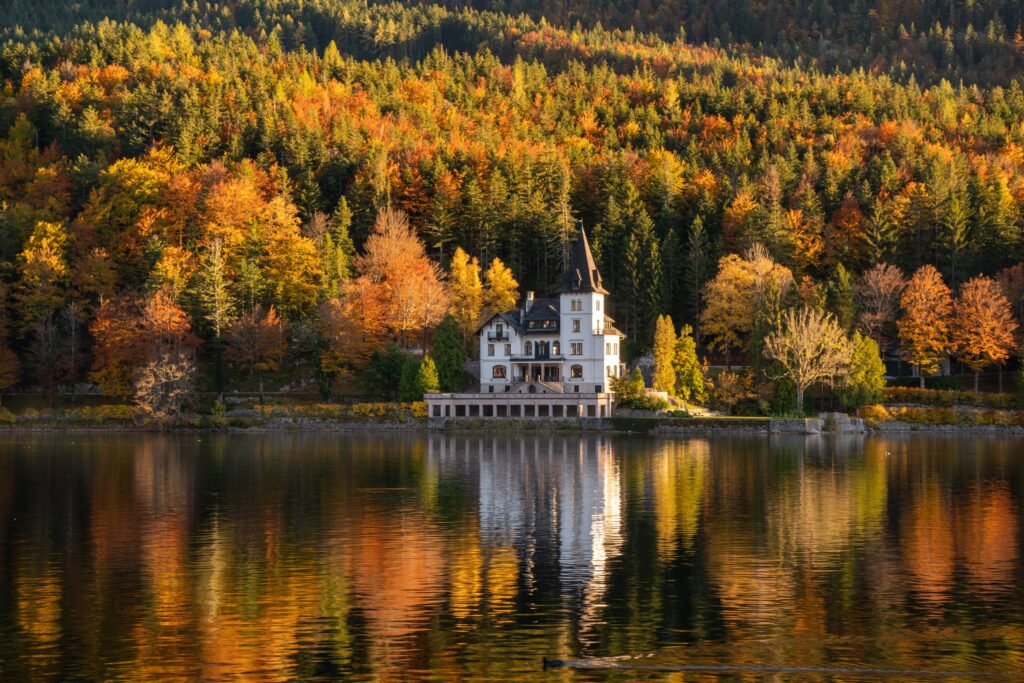
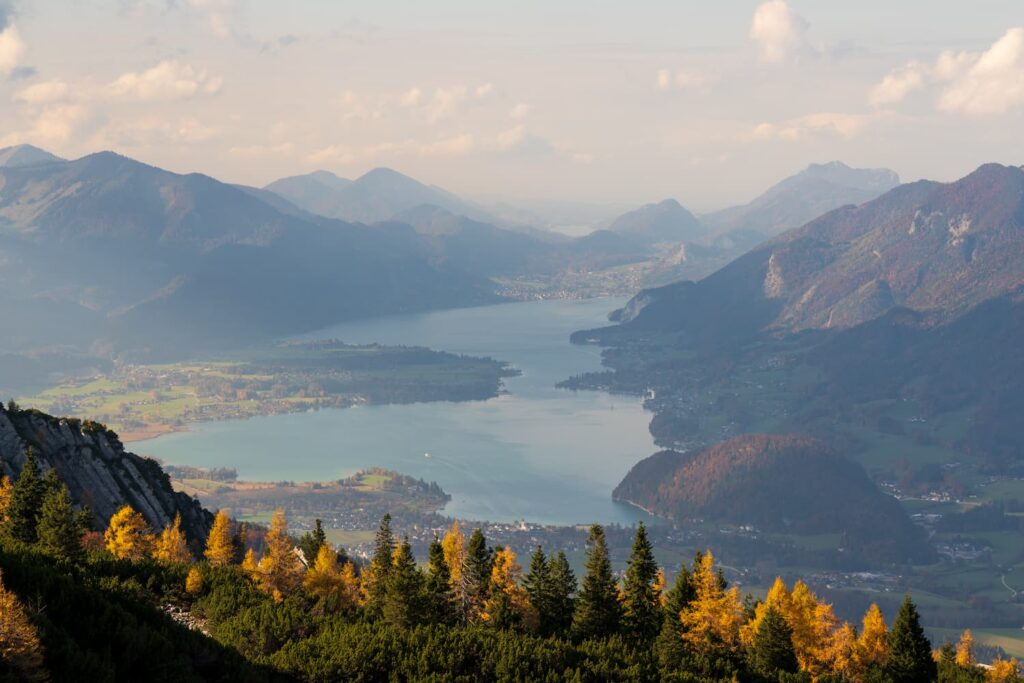
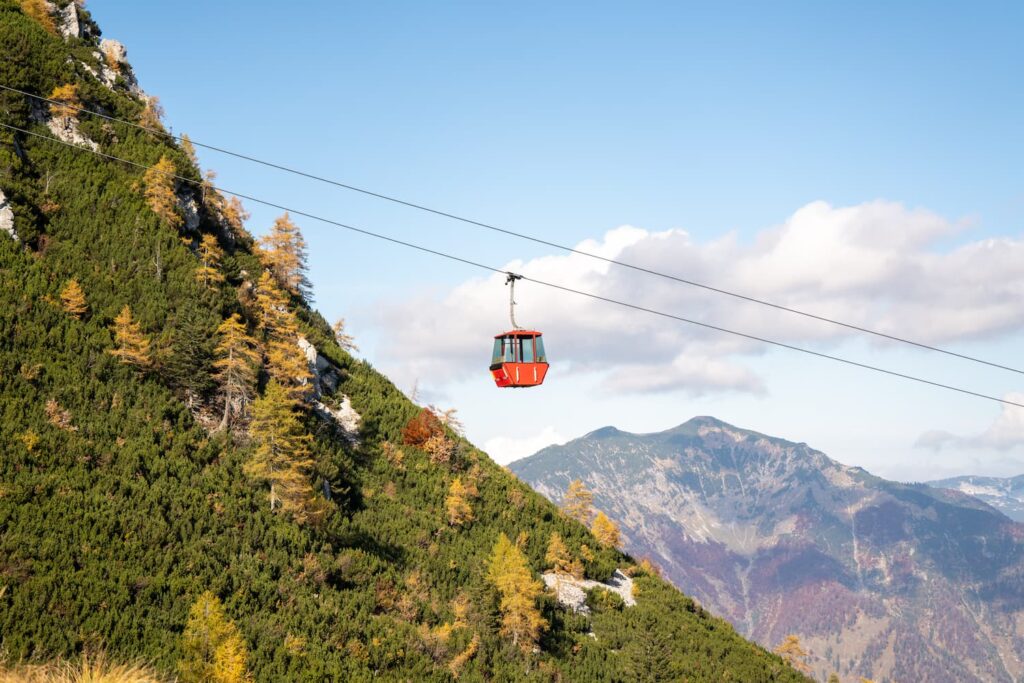
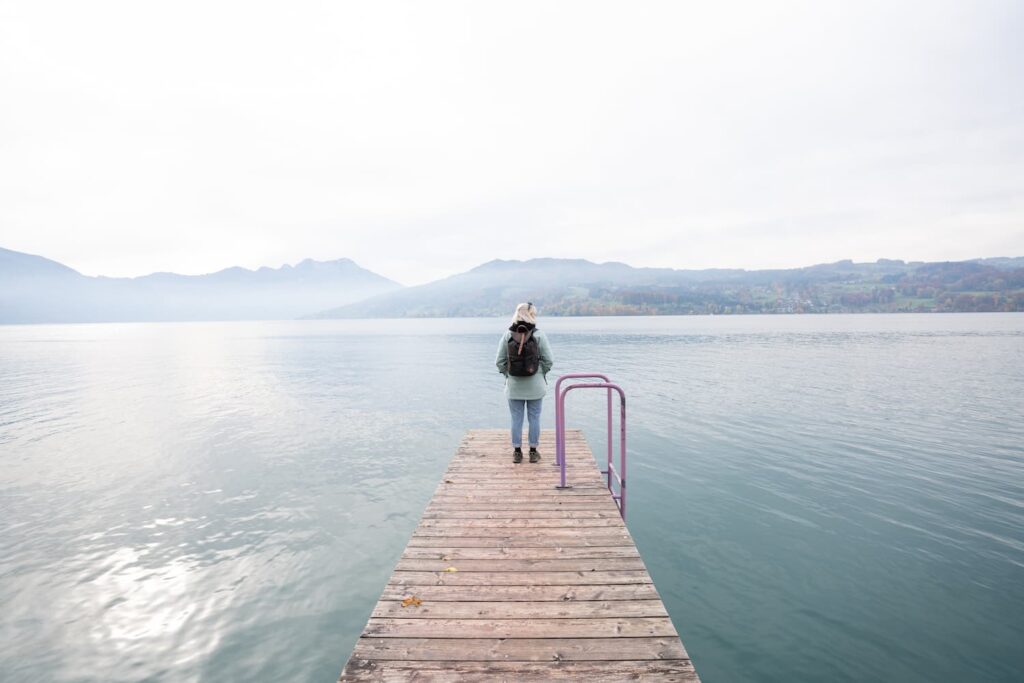
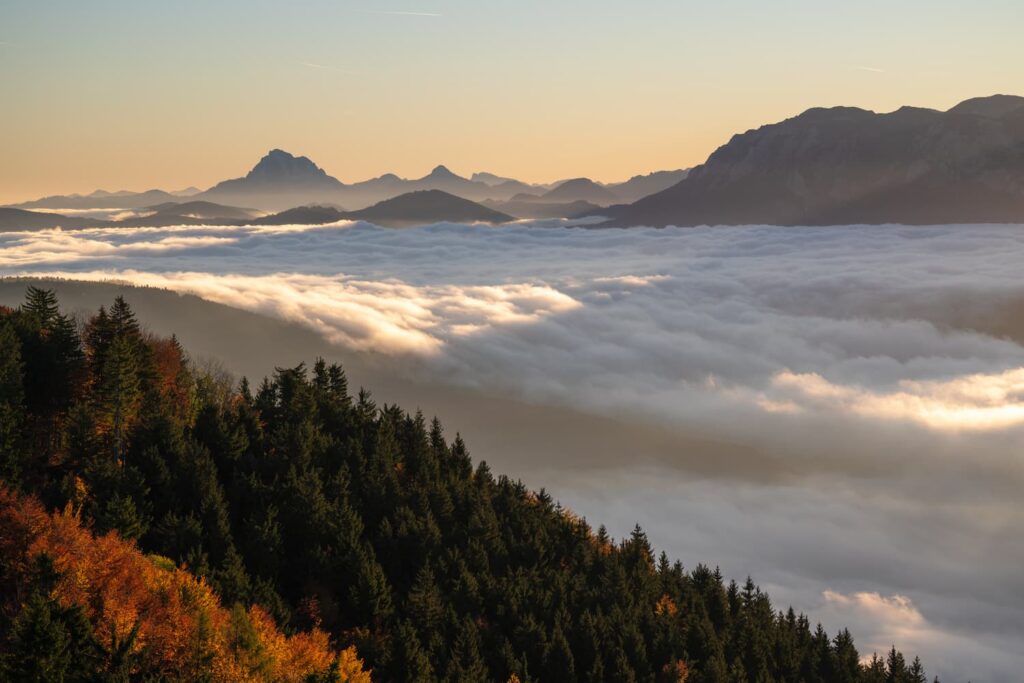
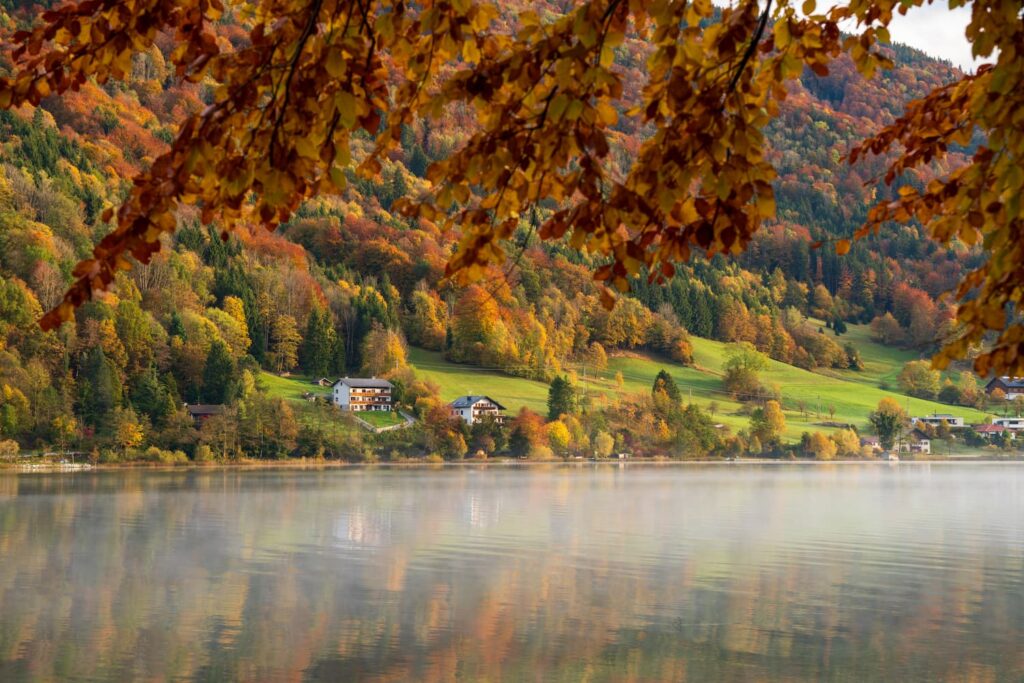
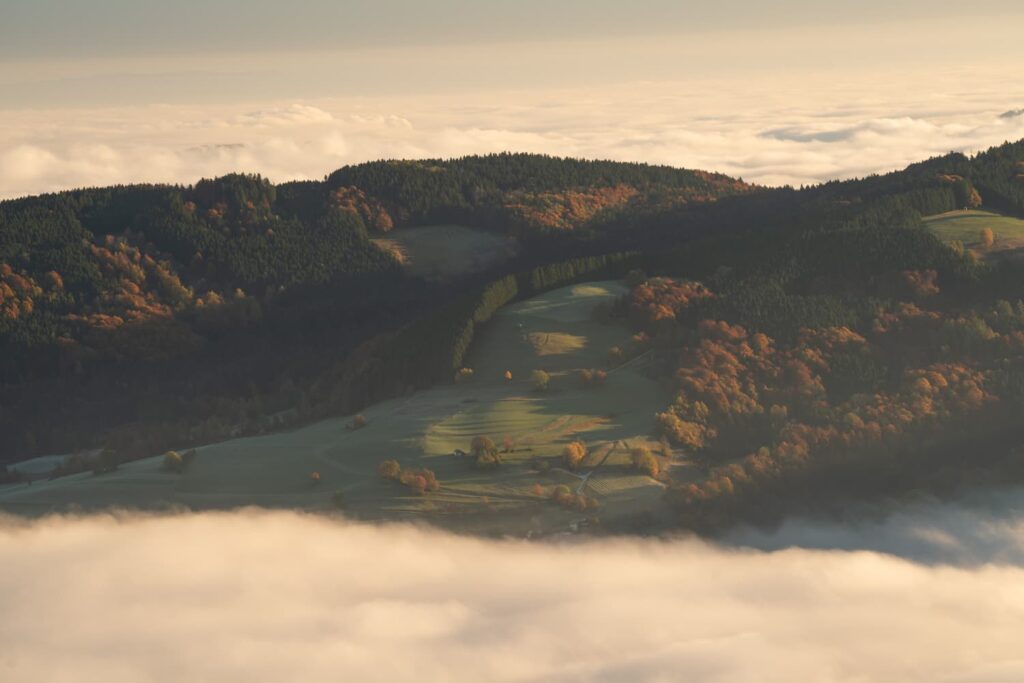

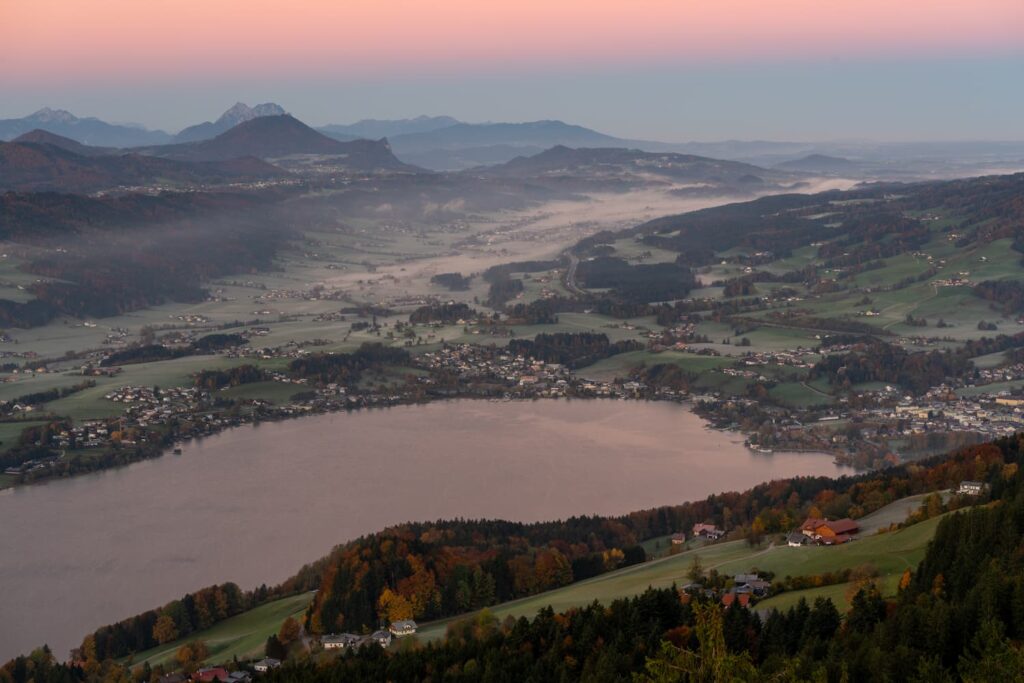
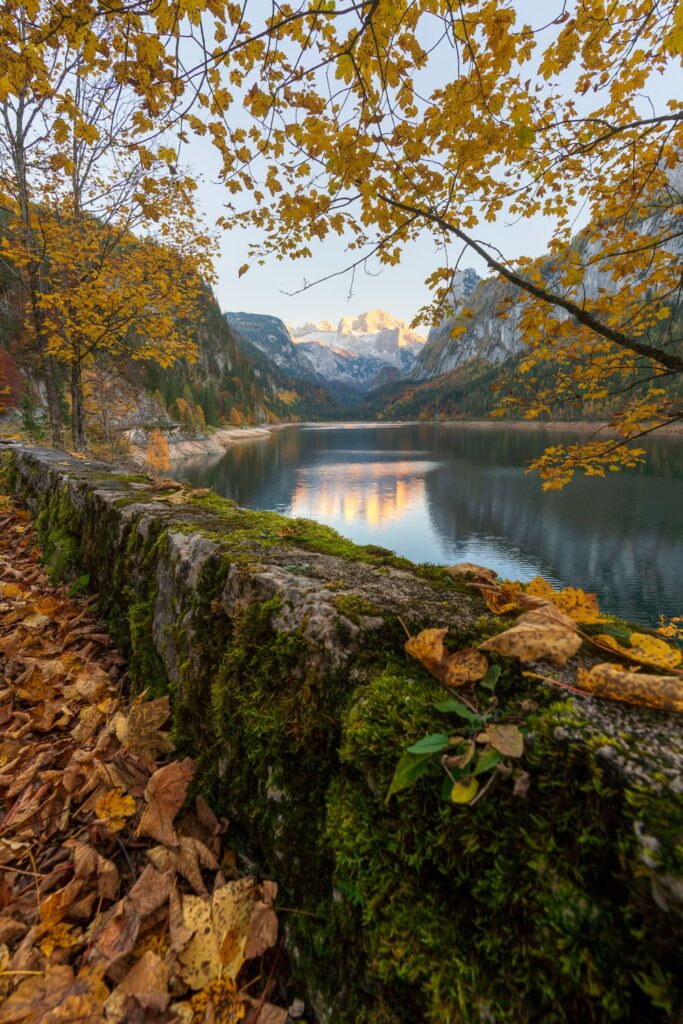
What to do around Salzkammergut
- Hike Traunstein for incredible views over the landscape – this is not an easy hike so please do your research before attempting.
- Cycle around the lakes: Attersee, Traunsee, Hallstatt, Grundlsee, etc.
- Katrin cable car – Probably the cutest cable car in all of Austria with great views of the surrounding lakes and nice hiking opportunities.
- Visit some smaller alpine lakes such as Langbathsee, Laudachsee, Offensee, Gosauseen, etc.
The Wachau – UNESCO World Heritage Site
Dürnstein in the Wachau region might already be familiar to you, but compared to Hallstatt, the town remains relatively unknown. With the Danube in the foreground, vineyards and steep rock walls behind, Dürnstein is the highlight of an already impressive landscape. Strolling through the narrow streets or enjoying a glass of wine, you can feel the weight of history, surrounded by medieval buildings, an important abbey and looming castle ruins. In the castle ruins above town, which you can hike up to, Richard the Lionheart was held captive in the 12th century. While that’s not as long ago as the salt mining in Hallstatt, which began around 5000 BC, the ransom for the captured king was so high that the entire city of Wiener Neustadt was built with it.
There are some breathtaking hikes around Dürnstein, including one of our favourites to Vogelbergstein – although not for the faint-hearted! There are some steep drops but the views are magical – and the final descent down into the castle ruins through gigantic rocks are perfect for climbing and make for great exploring.
Naturally there are also lots of cycling routes, you really can’t go wrong in the area. Which leads us to the conclusion that the whole of the Wachau, the UNESCO world heritage wine growing region, and to be honest, the whole Danube region, at least as far as Linz and possibly further, is rather spectacular. There are countless other gorgeous villages, castle ruins, churches, lookout towers, fascinating natural rock formations, vineyards and more.
And just look at those autumn colours: with so many vineyards the landscape is transformed, and even as late as November the mesmerising rows of golden vine leaves flutter still in the sunshine.
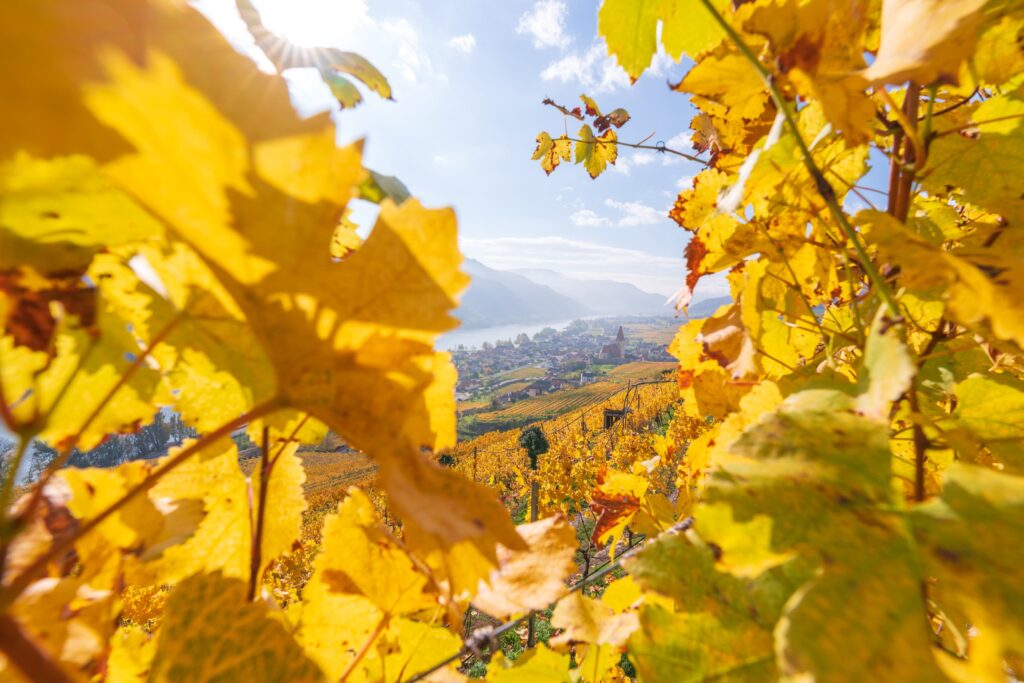
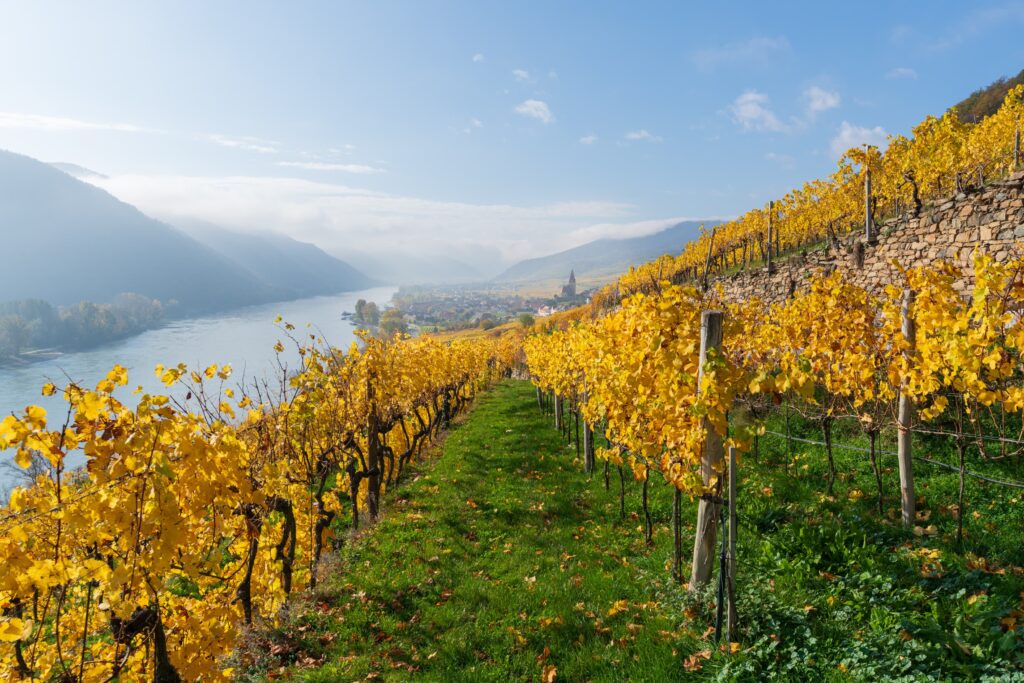
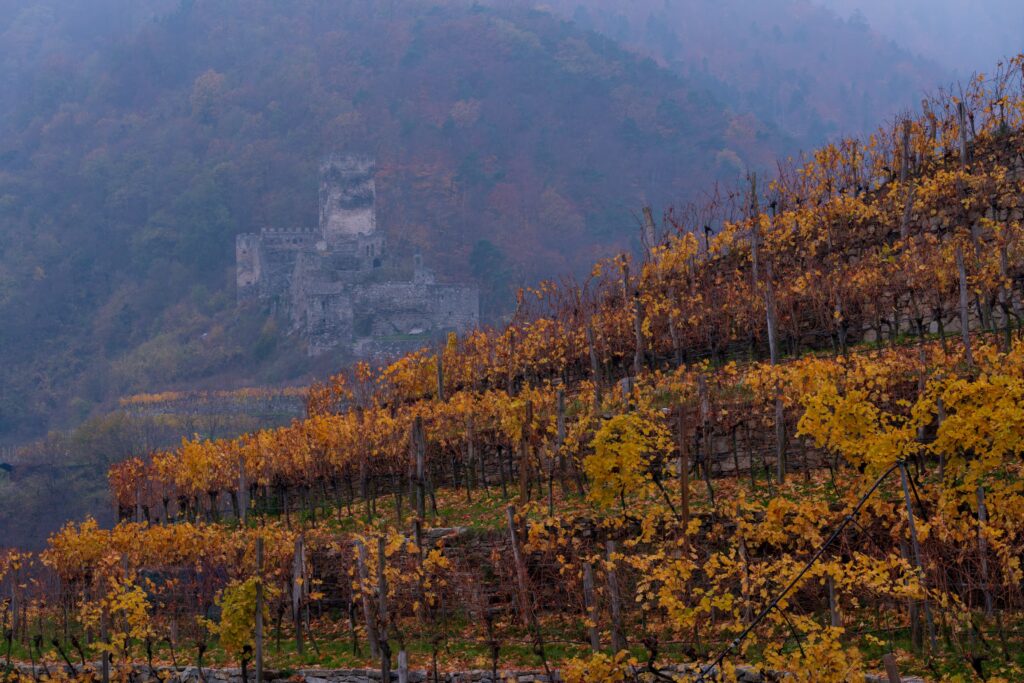
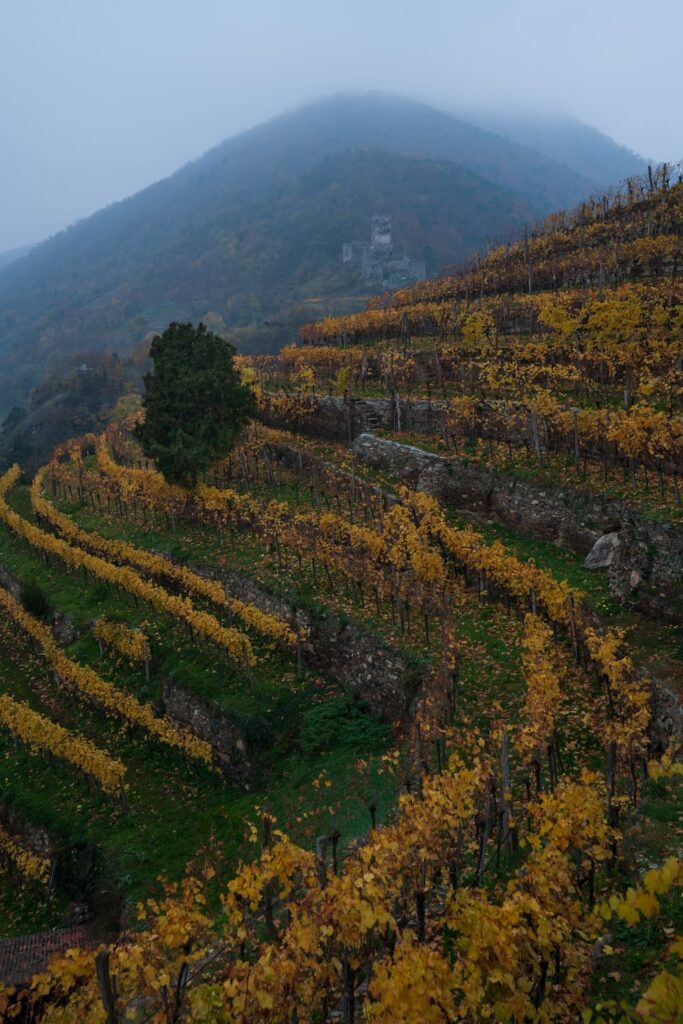
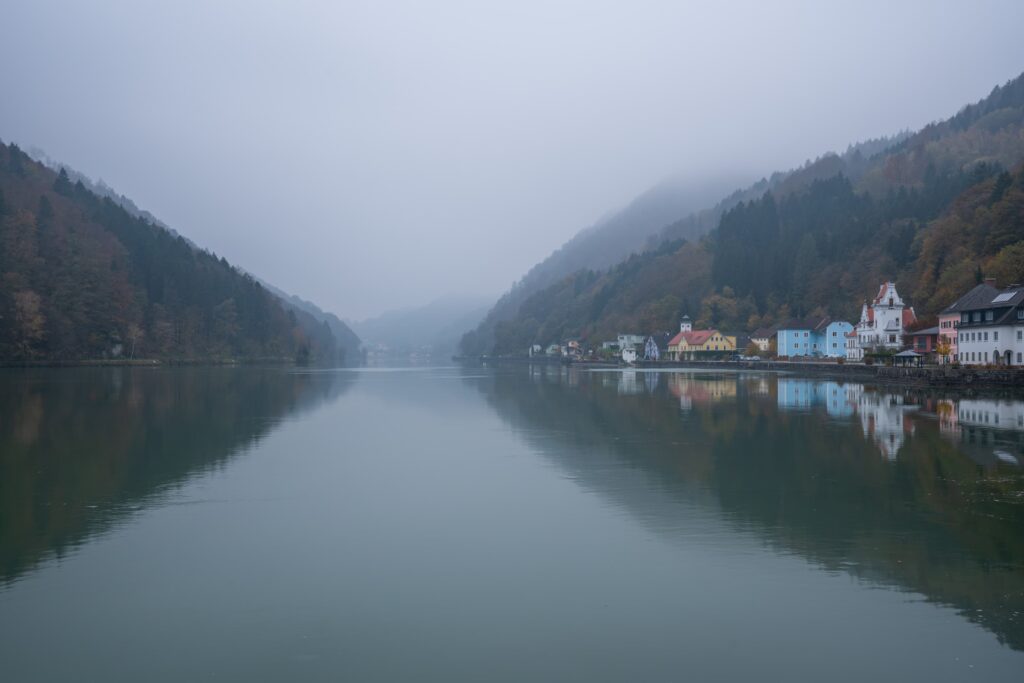
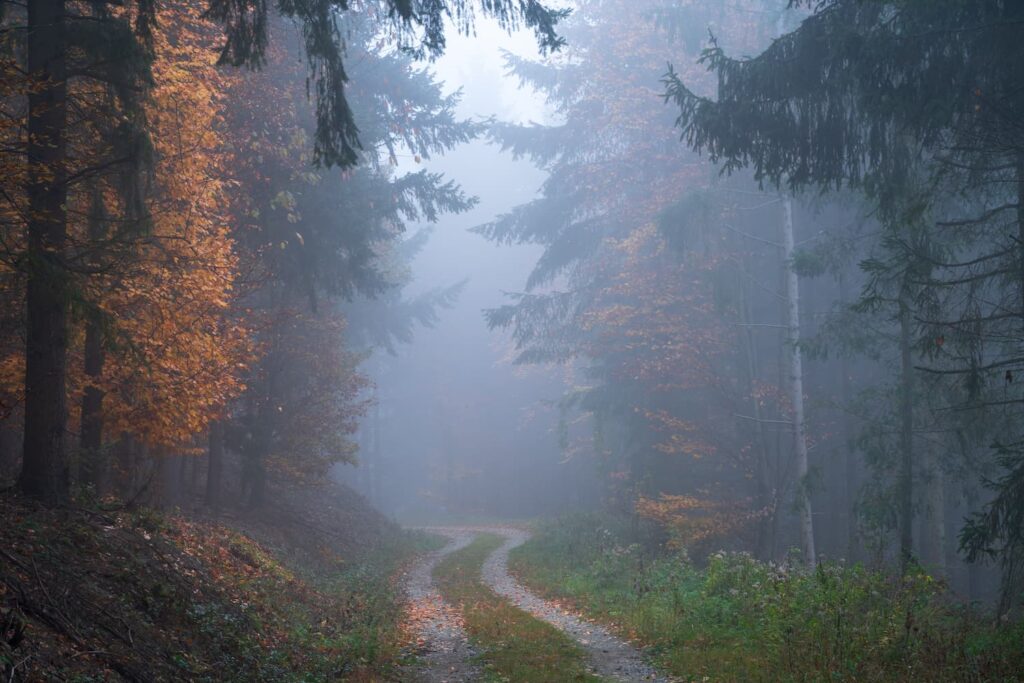
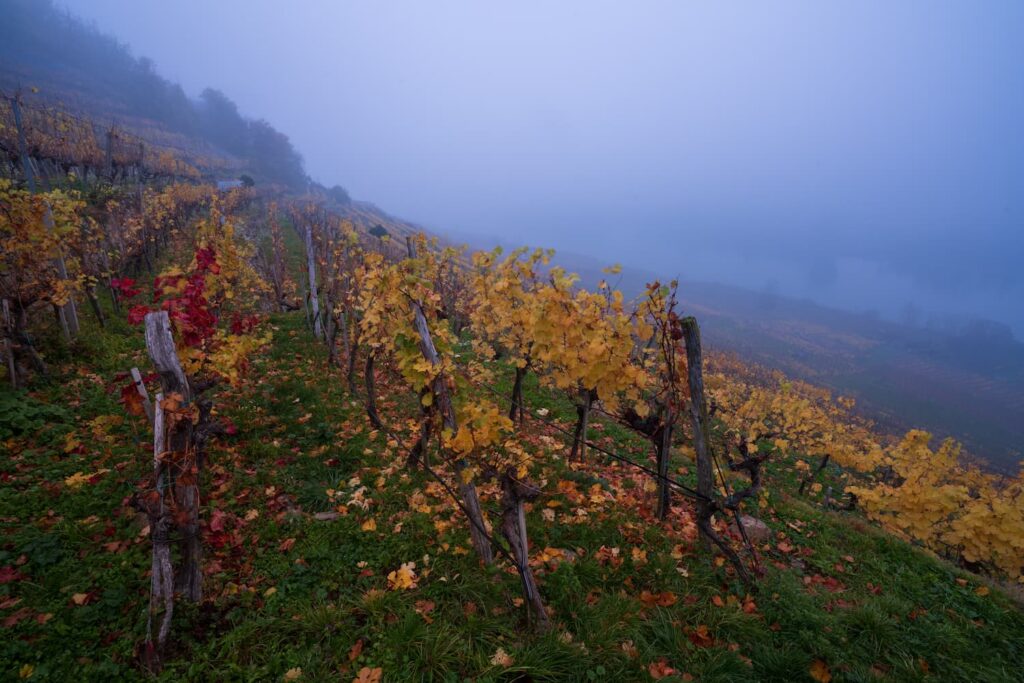
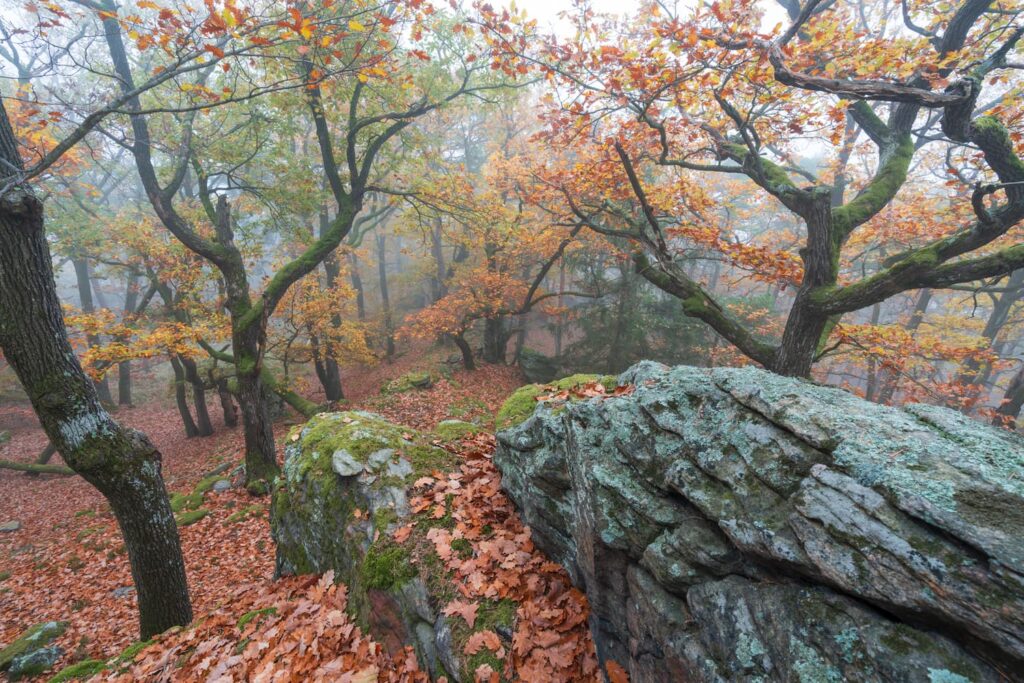
What to do in the Wachau?
The Wachau is very easy to get to from Vienna on public transport, you can take the train to Krems or Melk and explore from there. We recommend taking your bike with you. Otherwise, there is a small train that runs along the valley.
Some of our favourite villages, and things to do and see in the area:
- Weißenkirchen – Especially in autumn for the vineyards and spring for the cherry blossoms. The panorama path is excellent with spectacular views through the vineyards.
- Stein an der Donau (we will delve into Stein a little more in the next section)
- Krems – A small university city with a really nice old town and architecture
- Spitz – Another small village, about a 30 minute bike ride from Weißenkirchen. Spitz has two (!) castles – one in the centre of the old town and one older ruin on the mountain side, watching over the Danube. There is also the Rotes Tor, an old Roman gate. It’s just outside of the village up the mountain and super nice in spring through the blossoming trees with sublime views back into the valley. Finally the Tausendeimerberg is incredible to walk up and around, through the vineyards. It’s a maze of pathways and vine tunnels. You can also find great views on to the Hinterhaus ruins.
- Aggstein – A tiny village on the other side of the Danube, it’s cute – but what’s more interesting is the castle of the same name high above, with sweeping views over the valley. And it’s almost entirely hidden from below. There are also some cool climbing gardens nearby.
- Emmersdorf – A small village opposite Melk with a pretty arched train bridge passing through the middle.
- Sarmingstein – A tiny village with a cool old tower ruin and some nice nearby walks to vantage points up the steep valley mountains sides.
There are so many other things to mention, castles, palaces, churches, hikes, bike rides, etc, etc. There is pretty much a castle every 10 meters in the Wachau. Don’t forget Melk Abbey, Göttweig Abbey and Schönbühel.
Lunz am See
Lunz am See is an underrated destination nicely within reach of Vienna. It’s a bit tricky on public transport but can absolutely be done when you combine trains and busses. While you can technically do it as a day trip, we would recommend at least staying for the weekend to make it worthwhile. There is a campsite in the main village on the river which is quite nice, especially if you get a good pitch.
The main village is just away from the lake, but on the lake directly are some restaurants, boat houses and a few other buildings. The lake is gorgeous, in summer, it’s a swimming paradise. A forested path traverses the back side of the lake providing ample secluded swimming spots.
As is usually the case in Austria, there are multiple hiking options to keep you busy, one particularly nice tour ascends gently through a succession of higher lakes, and returning via a ridge. This hike starts with the same first half as the previous but continues on to the Ybbstalerhütte where you can stay the night. This one is slightly easier with nice views over the lake.
As nice as it is in the summer, the magic really happens in autumn as can be seen in the pictures below. The forests are transformed into a lush gradient of orange, yellows, browns and reds. The lake is quiet but the sun shines on, small fishing boats patrol the perimeters, the mountains reflect perfectly in the lake as it shimmers in the late warm breeze.
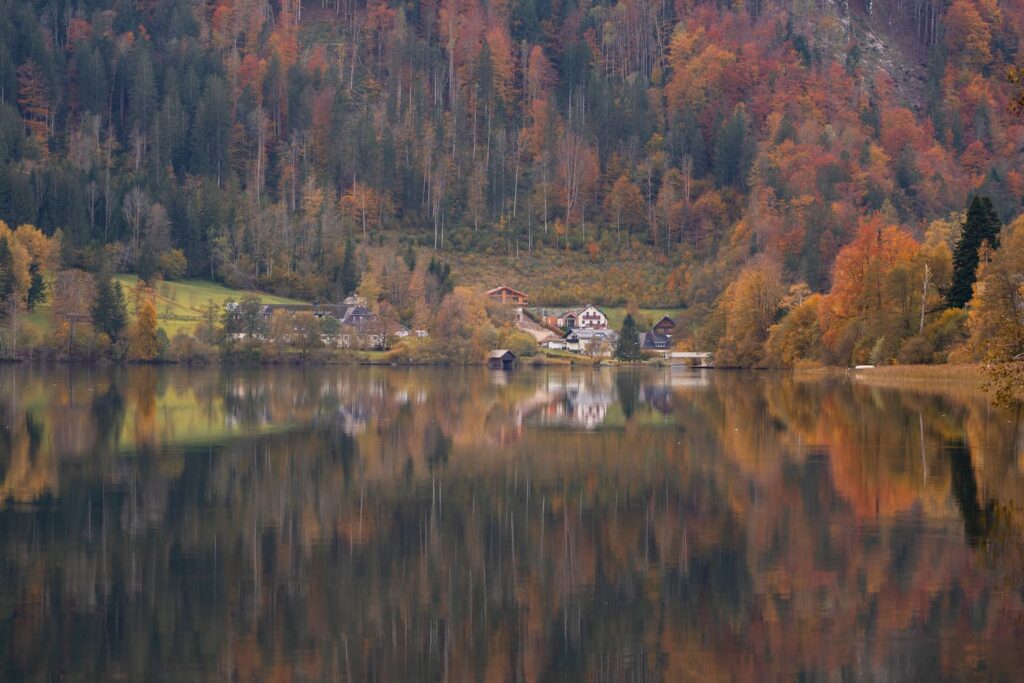
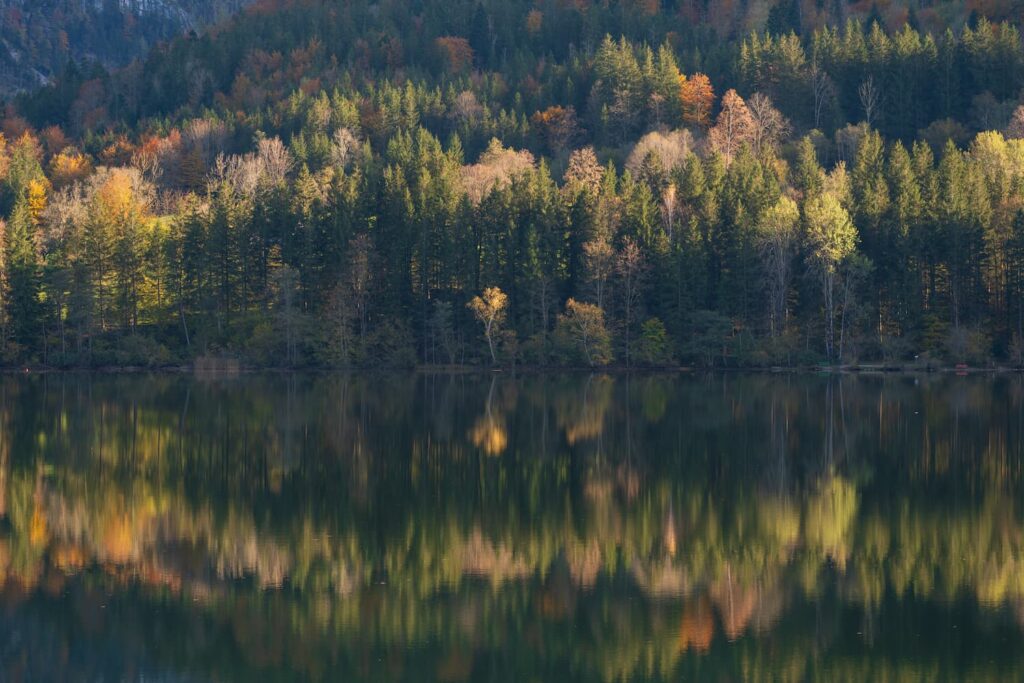
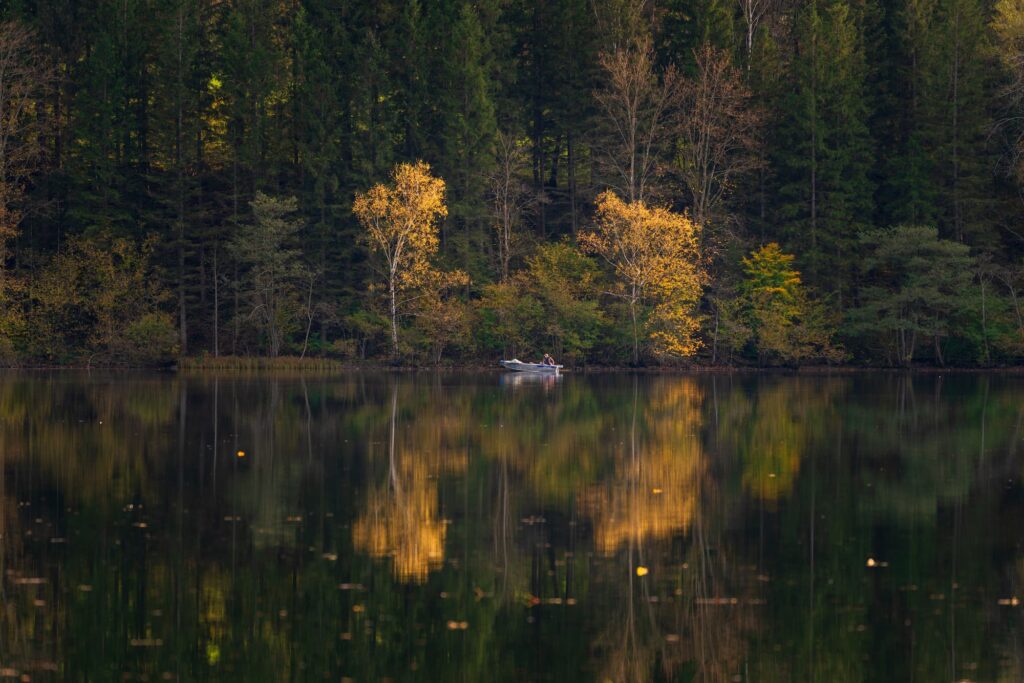
Kremstal
Close to the Wachau, the Krems valley is another gem that bursts into colour during the autumn months. Fortunately there are a lot less visitors than the Wachau/Danube region and the landscapes are just as impressive. Rolling hills, vineyards, cute villages and hilltop-perched castles. Cycling are hiking are the main activities here, but you can also experience a more laid back visit, lounge in the vineyards with a picnic, visit a Heuriger, explore Senftenberg castle, and so on.
Some nice hiking trails and biking trails:
- Kremstalweg – A long distance 100KM trail through the whole area, of course, you can split it in to stages.
- Weinwanderweg in Senftenberg – A short hike around the castle and vineyards of Senftenberg.
- Lots more hikes – You can find many more hikes here in the area, although, it is in German, albeit with many pictures.
- Cycling routes from the Kremstal website.
Getting to Kremstal is not so easy, most likely you will need a car, or you can cycle from Krems.
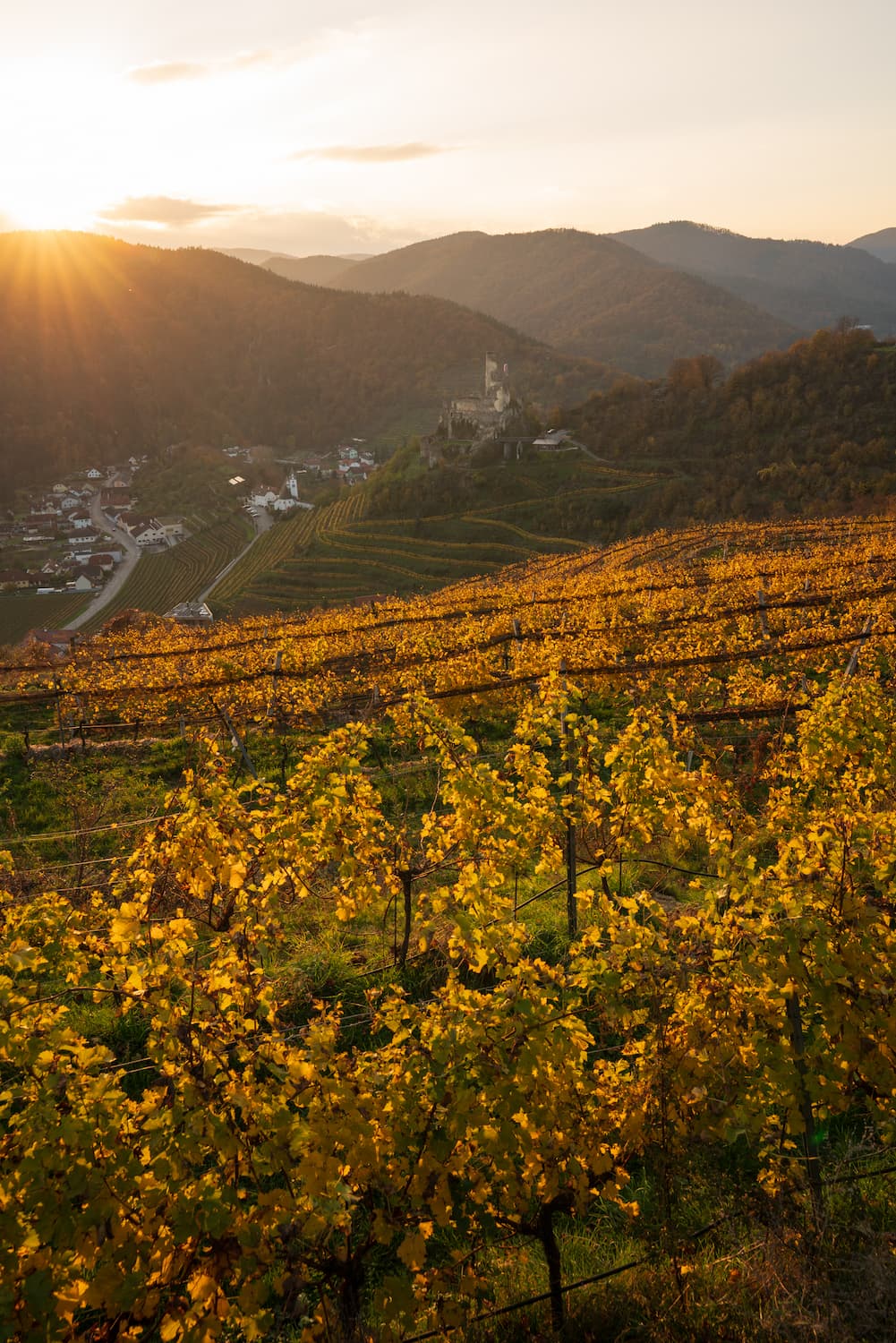
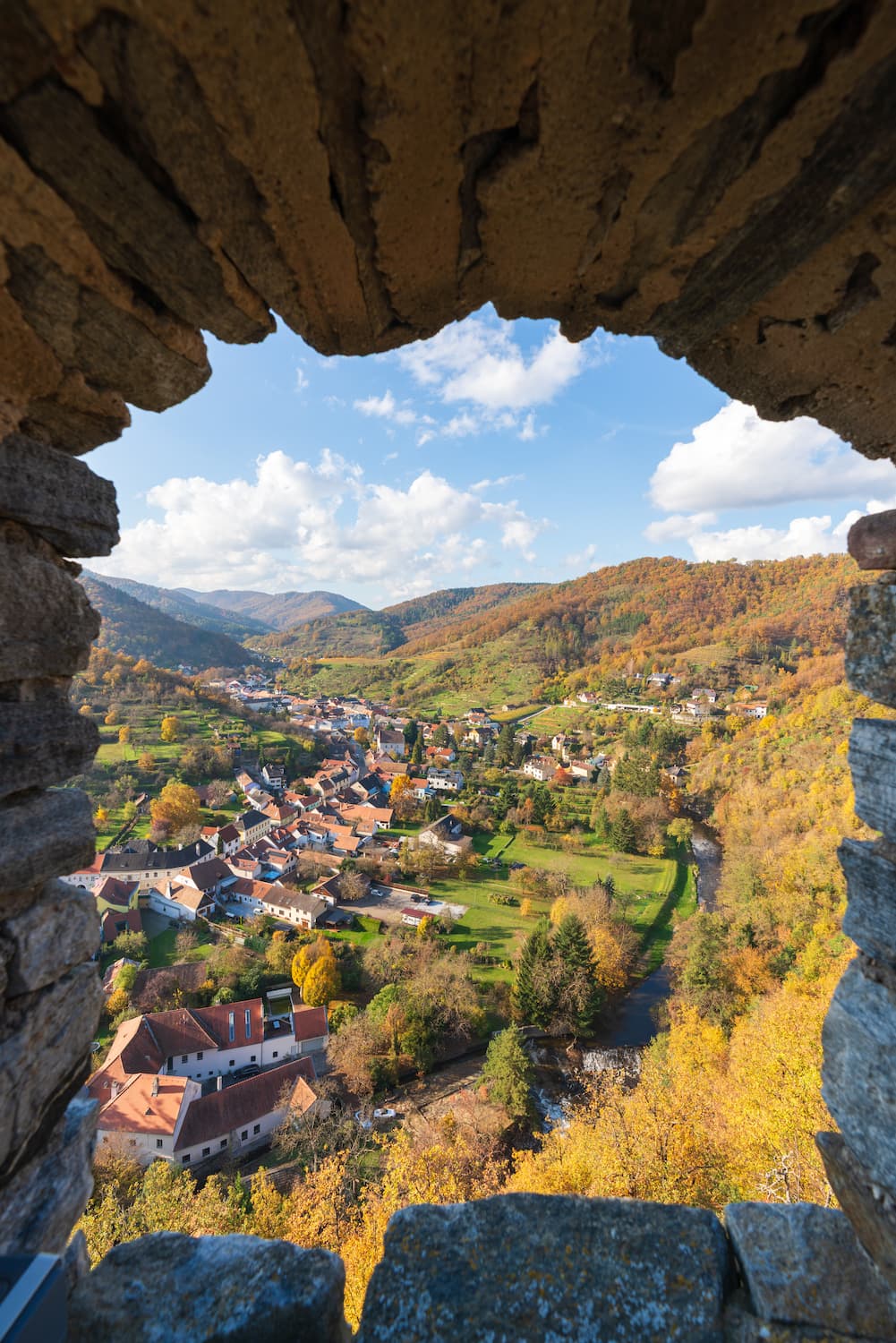
Kellergassen – Wine traditions
If you’re in Austria and craving a glass of wine in the open air, you probably jump for the traditional Heurige or Buschenschank. But if you’re looking to try something a bit different, we highly recommend visiting a Kellergasse. These picturesque lanes, often found in Austria’s wine-growing regions, are lined with rows of small, colorful houses. But don’t be fooled by their charm—no one lives in these homes. Instead, they house wine cellars and pressing rooms, earning them the nickname “villages without chimneys.” The Kellergassen are an important part of Austria’s cultural heritage, and many of these buildings are under historical protection.
When you peek through one of the often open doors, you’ll typically find a staircase leading down into a cool, larger room, slightly below ground level. Even further back, you’ll discover storage cellars where wine was once pressed and stored. Though wine-making has largely moved elsewhere, many of these buildings have been repurposed as cozy tasting rooms where local winemakers serve their finest. A particular highlight in these areas is the annual Kellergassenfeste, where the cellar houses throw open their doors for a big celebration, often in September. Keep in mind that the exact dates vary by location, so be sure to check with our reception for the latest updates.
Late summer is the best time for wine tasting but late autumn (October/November) is the best time for the real beauty, in our opinion. We wrote a whole article about our favourite Kellergassen and how to visit them. Check it out here.
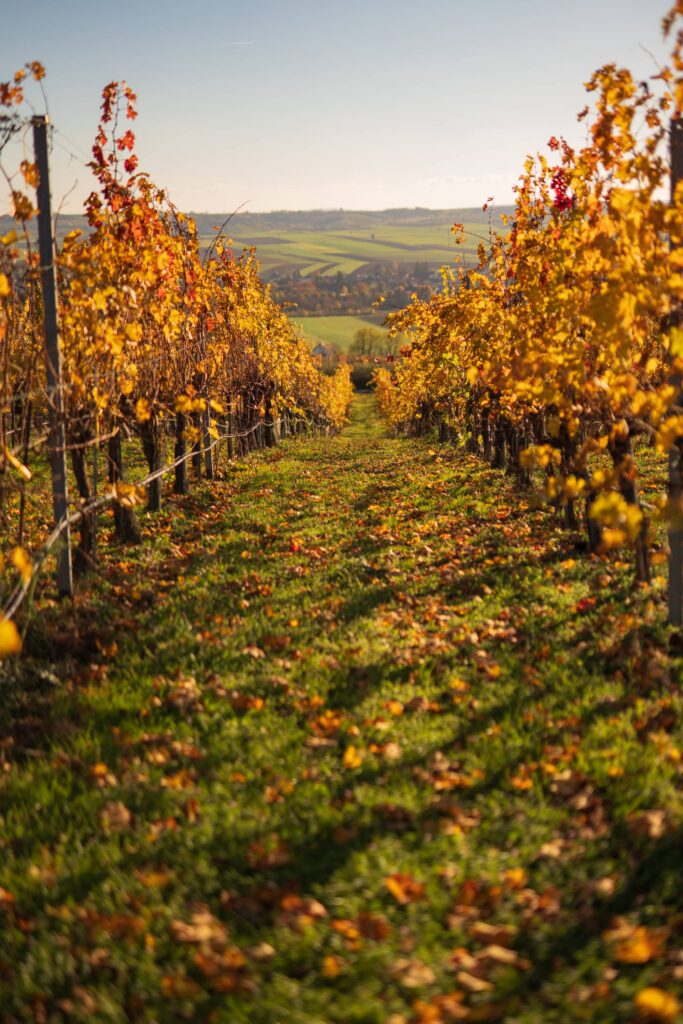
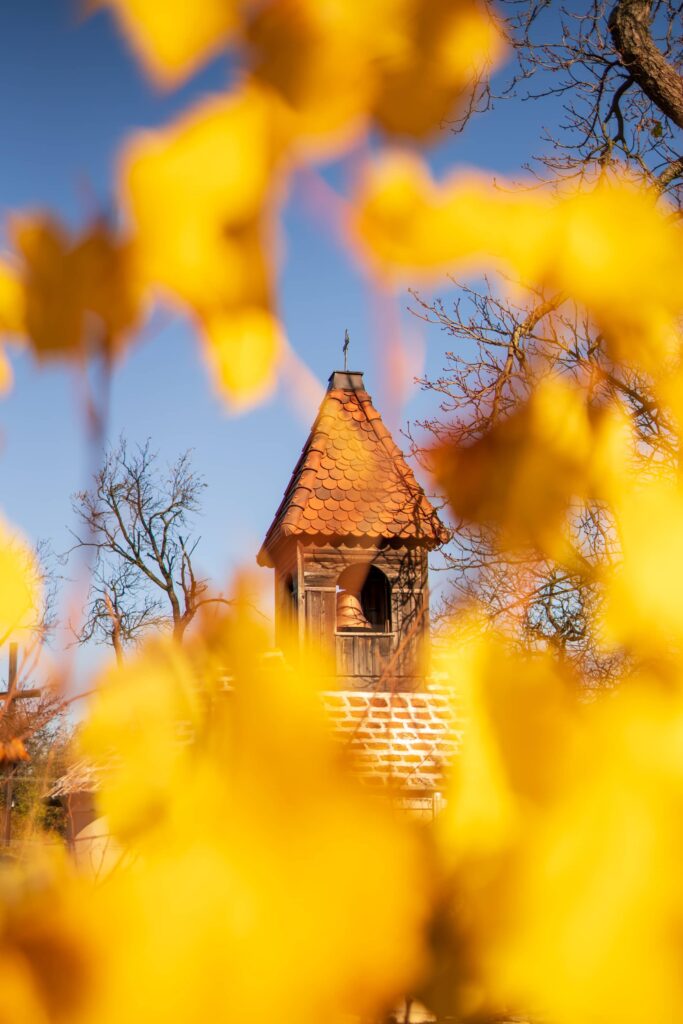
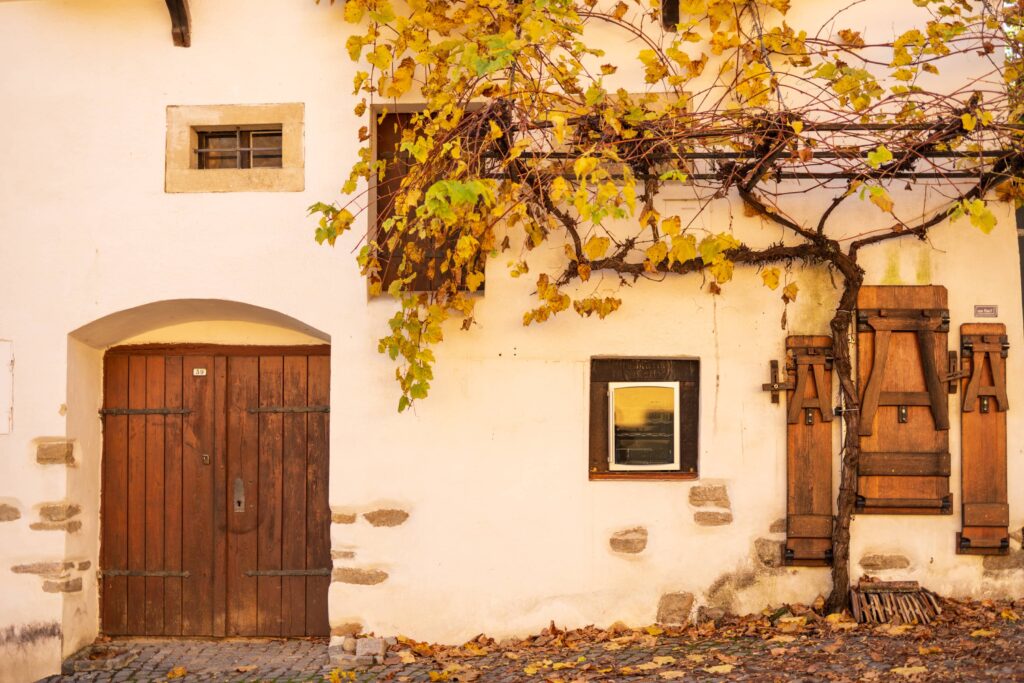
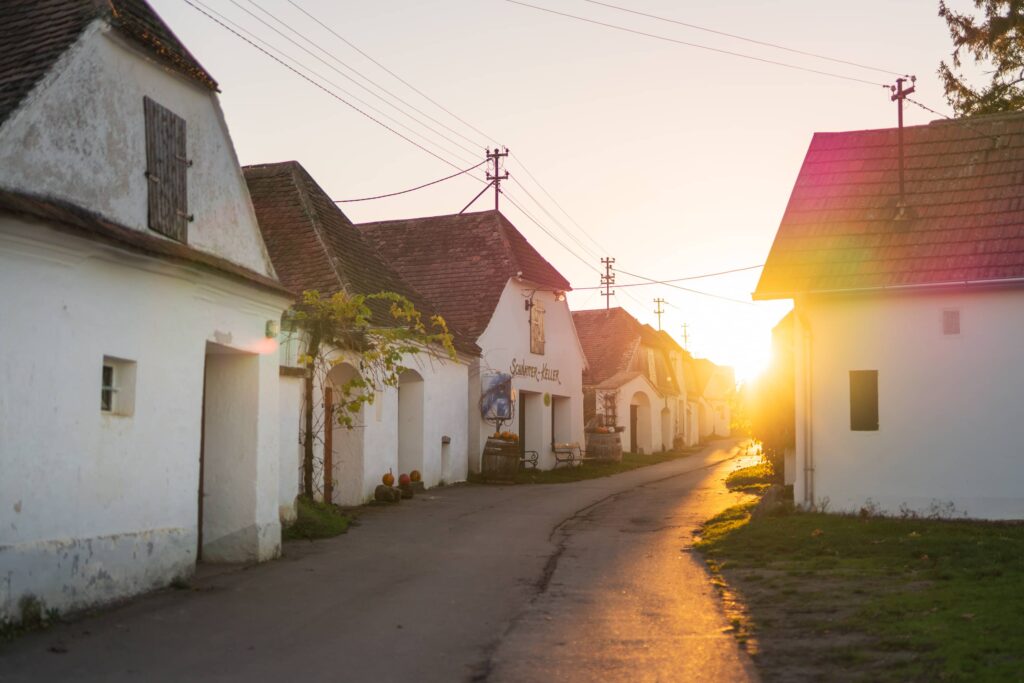
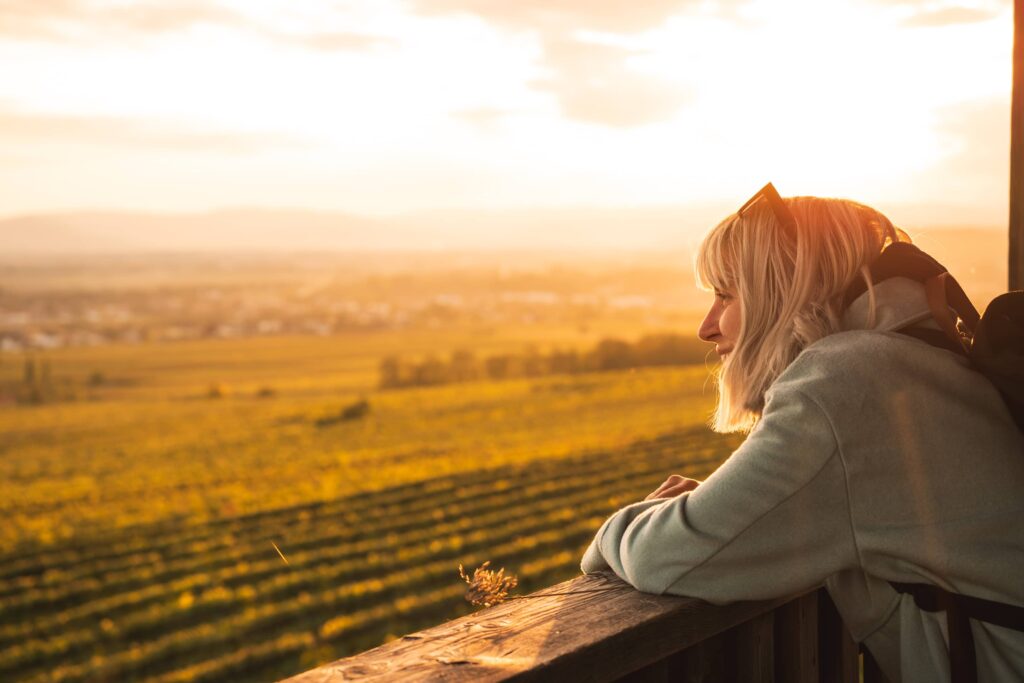
Schneeberg – The largest mountain in Lower Austria
The local mountain of Vienna. Schneeberg is about as well connected as a mountain can be to the city and is therefore quite accessible. It has a myriad of trails and the mountain hut on top (Fischerhütte) is open until the end of October – it’s perfect for autumn hiking. Just don’t underestimate it: some of the trails can be very dangerous unless you posses the necessary skills.
If you want to know more about hiking Schneeberg, we wrote a whole post about it: Five reasons to avoid Schneeberg: The worst mountain in Austria – don’t worry, the title is satire!
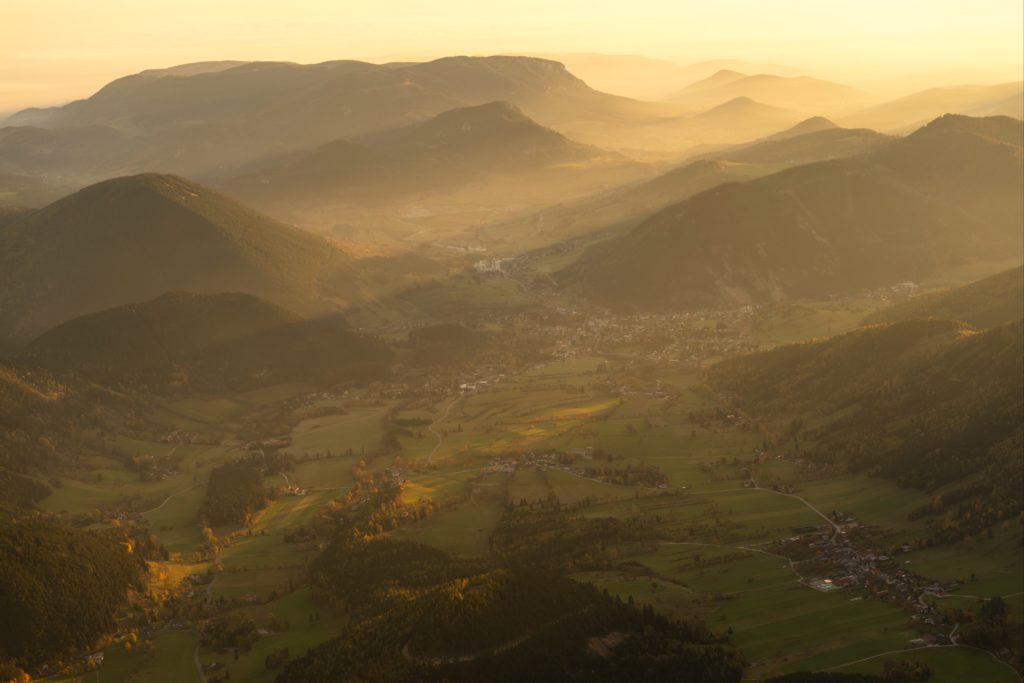
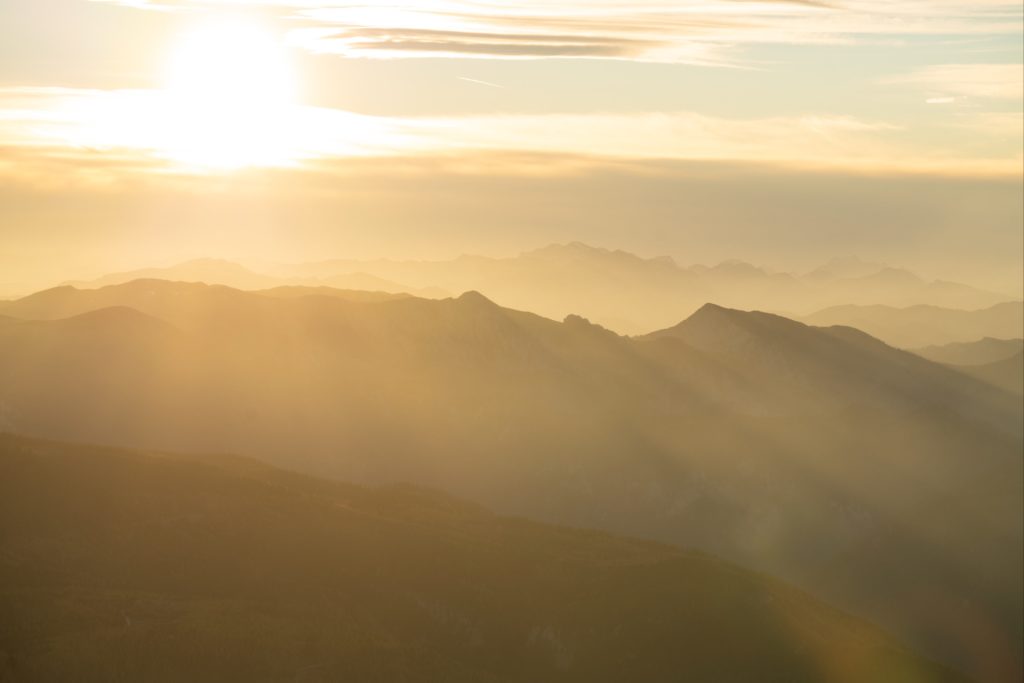
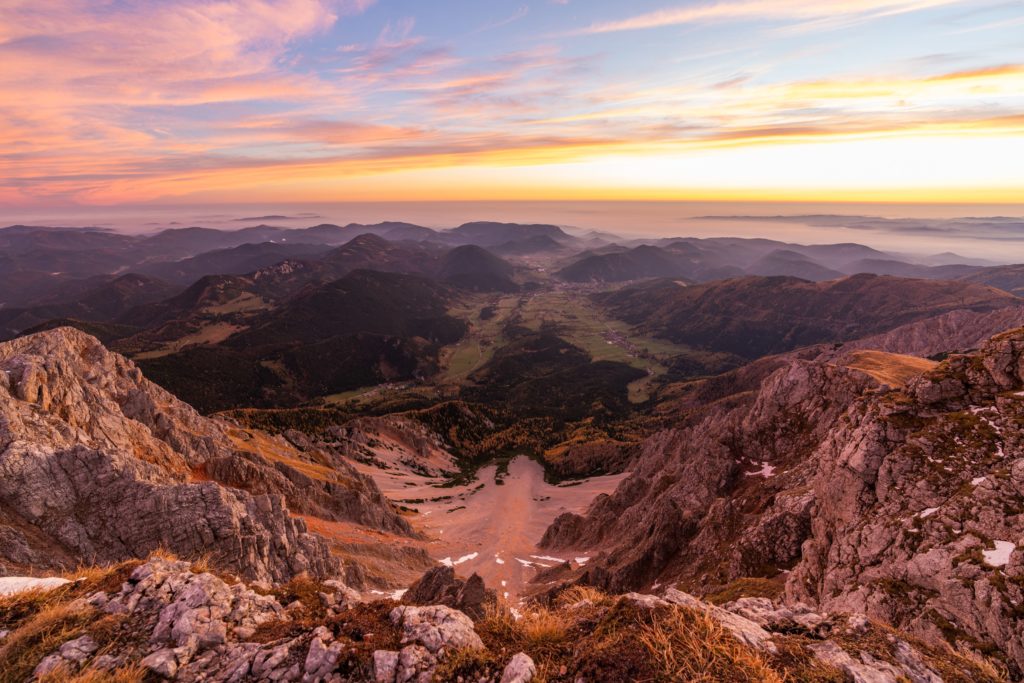
The Karwendel Alps
The mountain range straddling the border of Austria and Germany in the Tirol and Bavaria regions is known as the Karwendel Alps. Mostly in Austria, Innsbruck is the nearest major city and the transport links are great. You can get to a lot of trail heads by train.
The Karwendel Alps were our first foray in to multiple day hiking, we picked a 60KM three day trek. The hike passes through valleys, mountains, waterfalls and ridges. It was our first time sleeping in an alpine hut and since then we’ve stayed in many more, regularly visiting them. They are fantastic for exploring the mountains.
The Karwendel hike is still one of my favourite hikes we’ve ever done and part of that was due to the incredible autumn scenery. We experienced really bad weather on the second day but the passing of the storm created unimaginable beauty with waterfalls falling from clouds, mist filled valley and peaks rise from a sea of fog. I don’t think I’ll ever forget it.
The mountain huts are not open all your around, they close around mid October, so depending on the year, hiking in the autumn might not work out. The weather can be bad with early snow fall possible in September. Mind you, that can also happen in mid Summer, so plan your trip accordingly!
We wrote extensively about our experience trekking in the Karwendel mountains. If you’re interested in multi day treks in the Alps, or in particular the Karwendel mountains – check it out: Wild and without: 3 day trek in Karwendel Alps – Part 1.
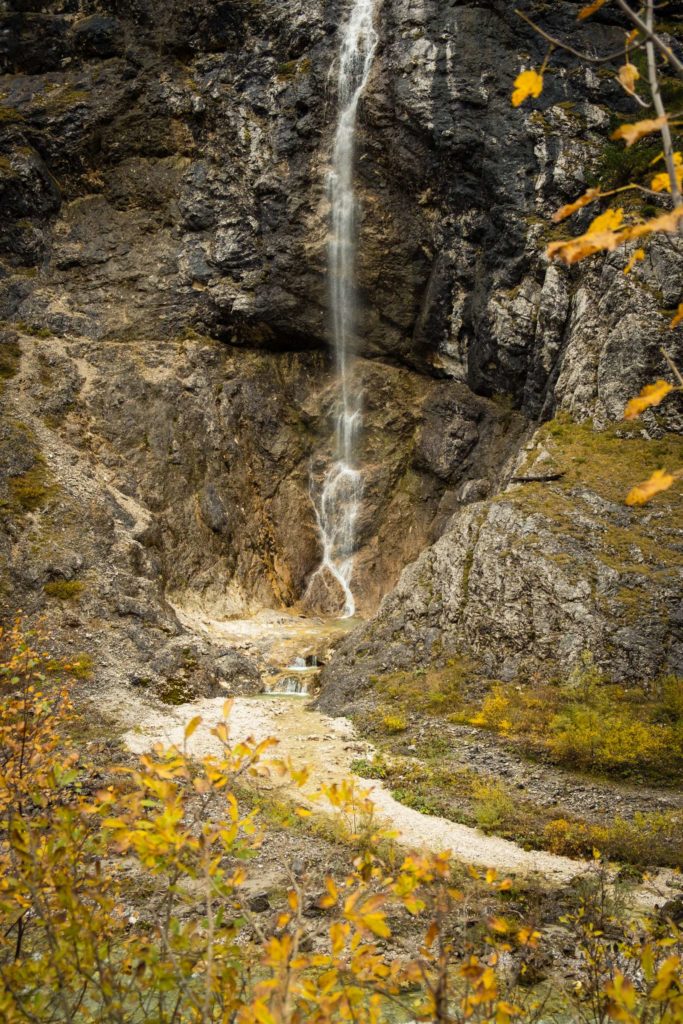
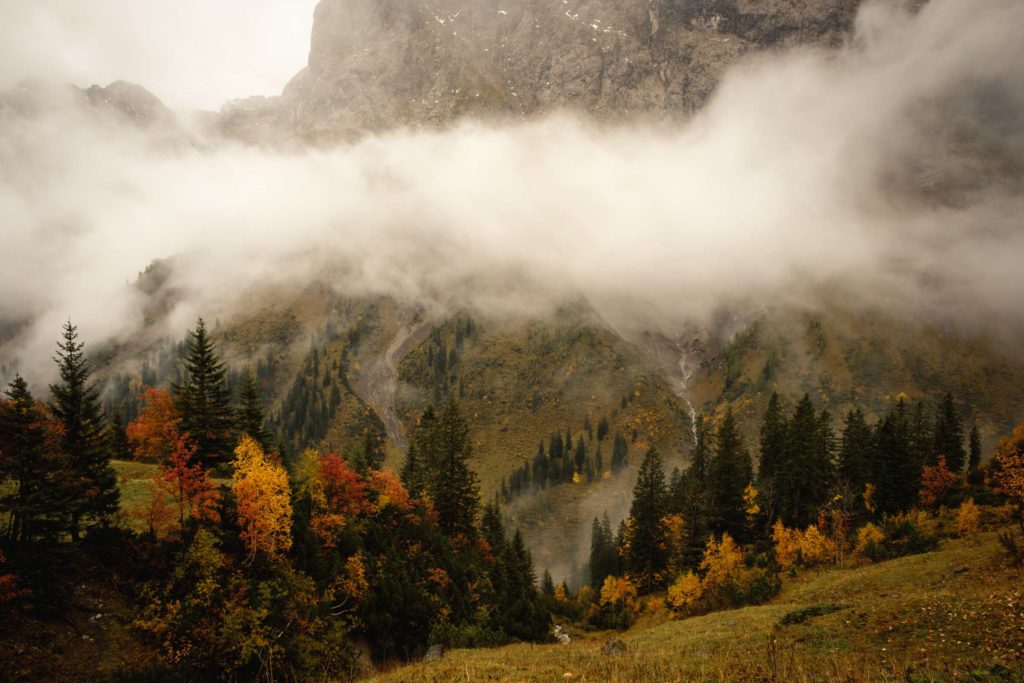

The city of Vienna
Vienna is the capital of Austria and accounts for over 20% of the countries population. It’s an incredible city and one we call home (for now). There are many reasons to visit Vienna and of course we can’t/won’t list them all here, we’d just like to highlight the beauty of Autumn.
Vienna is hot in the summer, like really hot, it regularly exceeded 35 degrees Celsius in the last few years. When you’re not a tourist, e.g. working, it can get a little too much. As a tourist it’s pretty great, you can chill in the parks, go swimming, head to museums etc. We on the other hand, quite often flee the city during summer and head to the higher lands, in search of cool and calm. For us, autumn is when it really kicks off in Vienna.
There’s Sturm – a young fermented wine that is served from late September through early October. It’s how Austrians celebrate the harvest season, it’s pretty much debauchery, with all of the class associated with wine thrown out the window. It’s served from make shift plastic bottles resembling cheap fuel, but don’t be deceived, it’s truly delicious. In the vineyards and Heurigen surrounding Vienna, particularly in the 19th district (Döbling), you’ll find all ages of people enjoying the fun.
As the months roll on towards November, sometimes right until the end, the vineyards transform in to a rainbow of colours, the days can still be warm but begin to shorten. Street sellers serve Maroni and baked potatoes, the bars begin to fill up as the outside seating is packed away for winter. The city parks are smothered in layers of golden leaves, crunching under your feet. Autumn is really the best time of the year in Vienna. And if you the weather is just right you can see the whole city engulfed in fog with sky scrapers piercing through, catching the suns early rays.
What to do in Vienna during Autumn:
- Nußberg – Head to Nußberg, stroll through the vineyards, drink some Sturm or wine in one of the many outdoor Heurigen, our favourites are Wieninger am Nussberg and Mayer am Nussberg because they have vegan options. There are many smaller and more romantic options hidden in the vine rows so make sure to explore.
- The many parks throughout Vienna are transformed as the leaves begin to colour and decay, slowly covering the grass in a sea of gold. Try Prater, Lainzer Tiergarten, Türkenschanzpark, Schwarzenbergpark, Steinhofgründe, etc.
- Schönbrunn Palace and gardens deserve an honourable mention, the stunning trees mixed with the classic architecture make for a special experience.
- Try some seasonal food: Pumpkins/chestnuts/mushrooms are very popular during the autumn season.
- Explore Stammersdorf (Vienna’s own wine cellar district) and hike up to Bisamberg. For more wine cellar walks and experiences, check out our post.
- Explore the central graveyard, it may be somewhat morbid but it’s truly beautiful, and you might even spot some wildlife, birds, squirrels, deer, mice and so on.
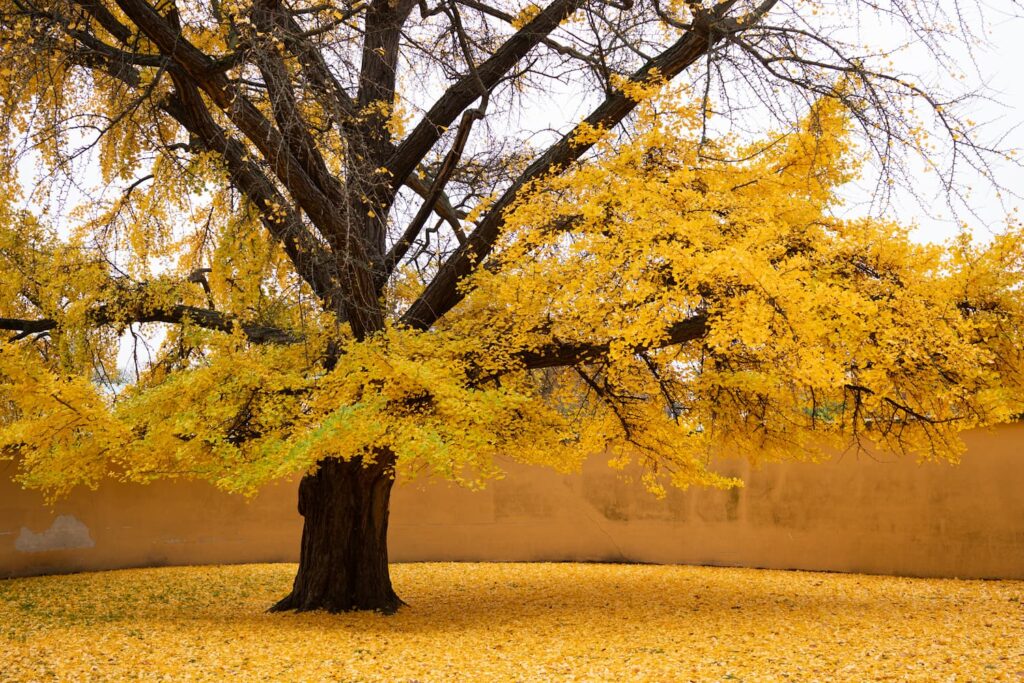
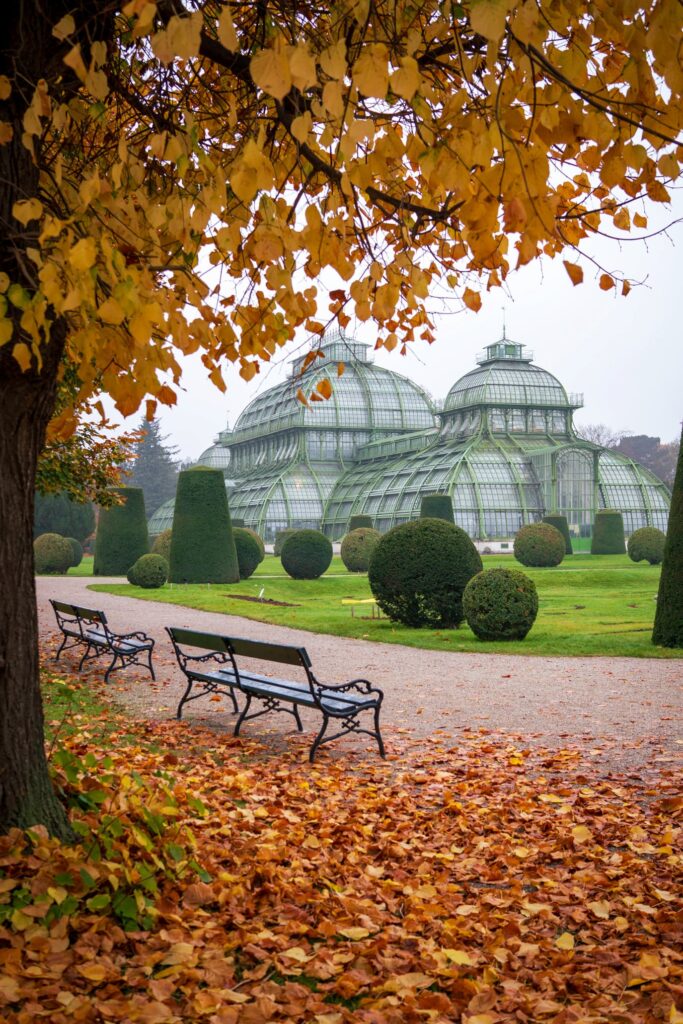
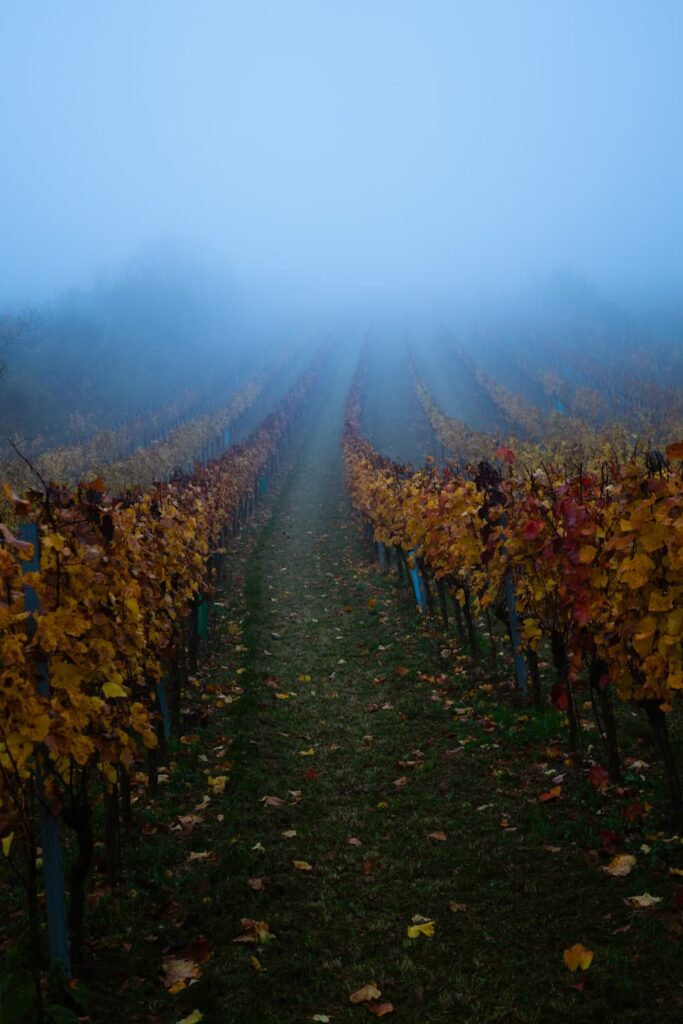
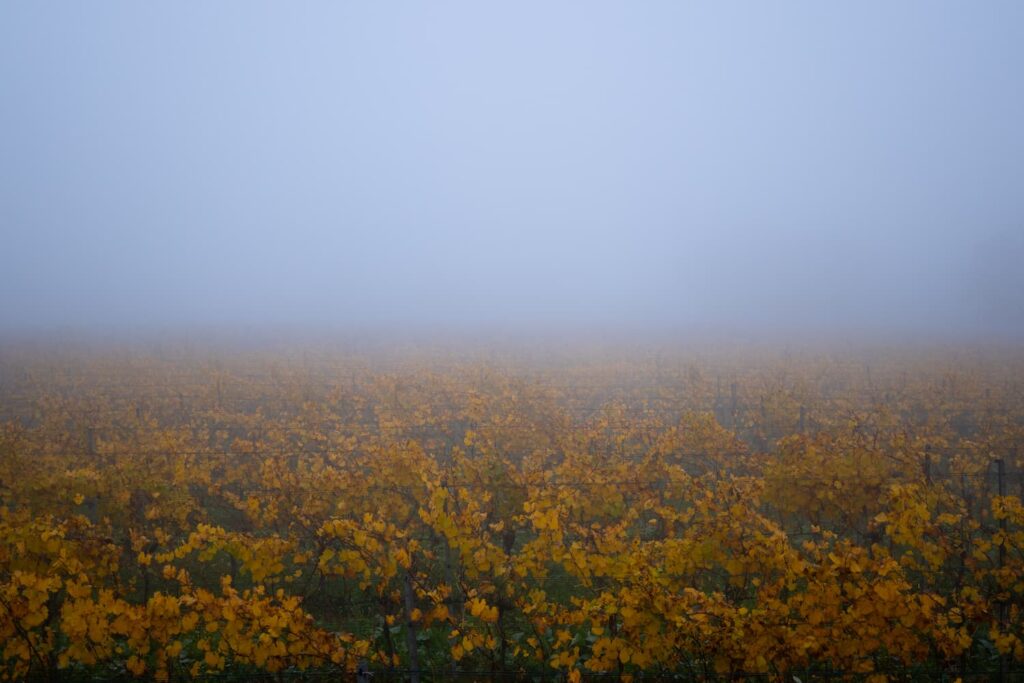
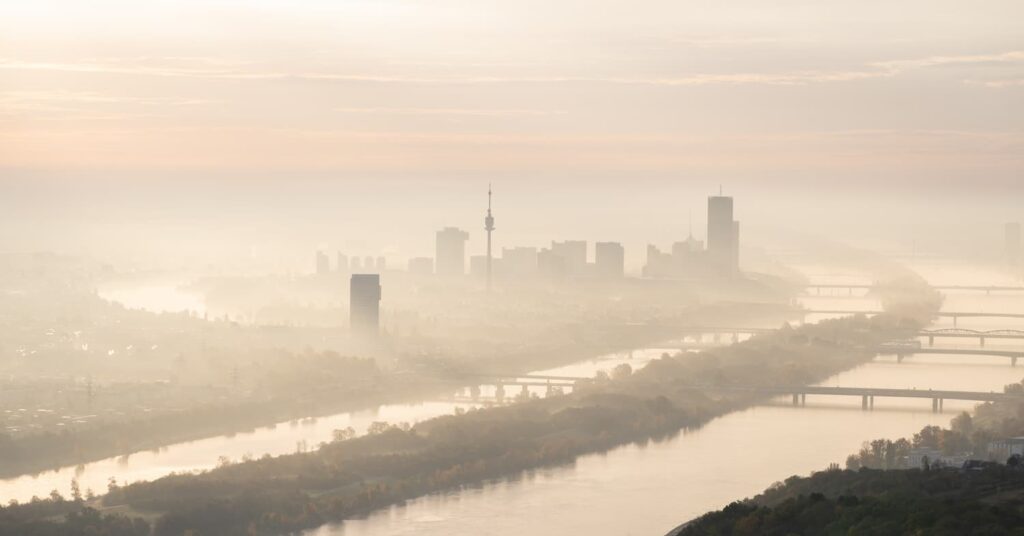
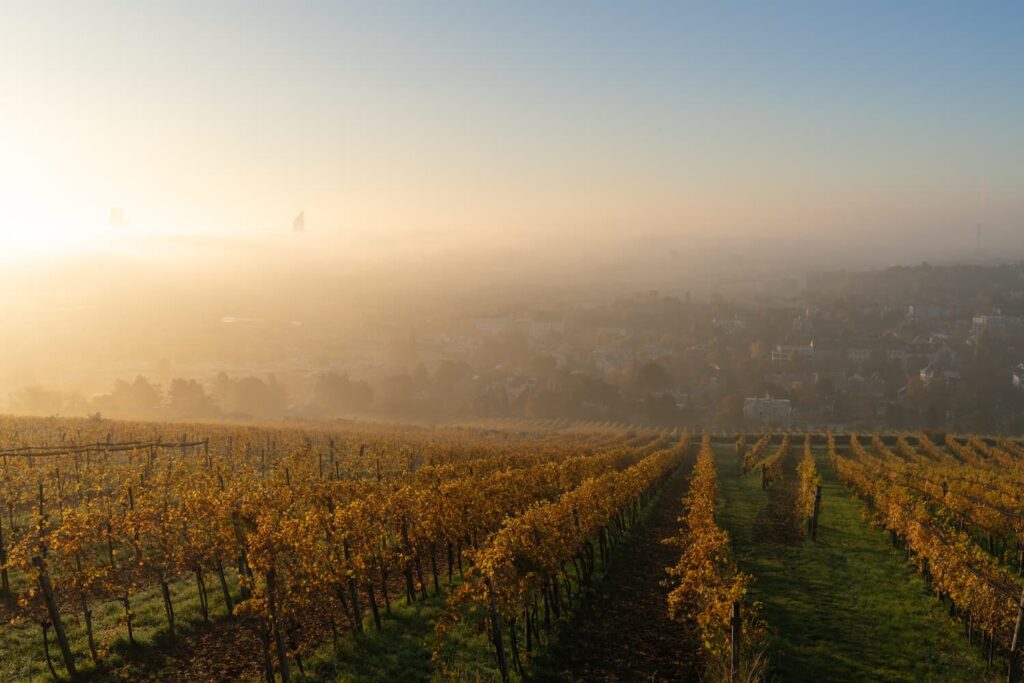
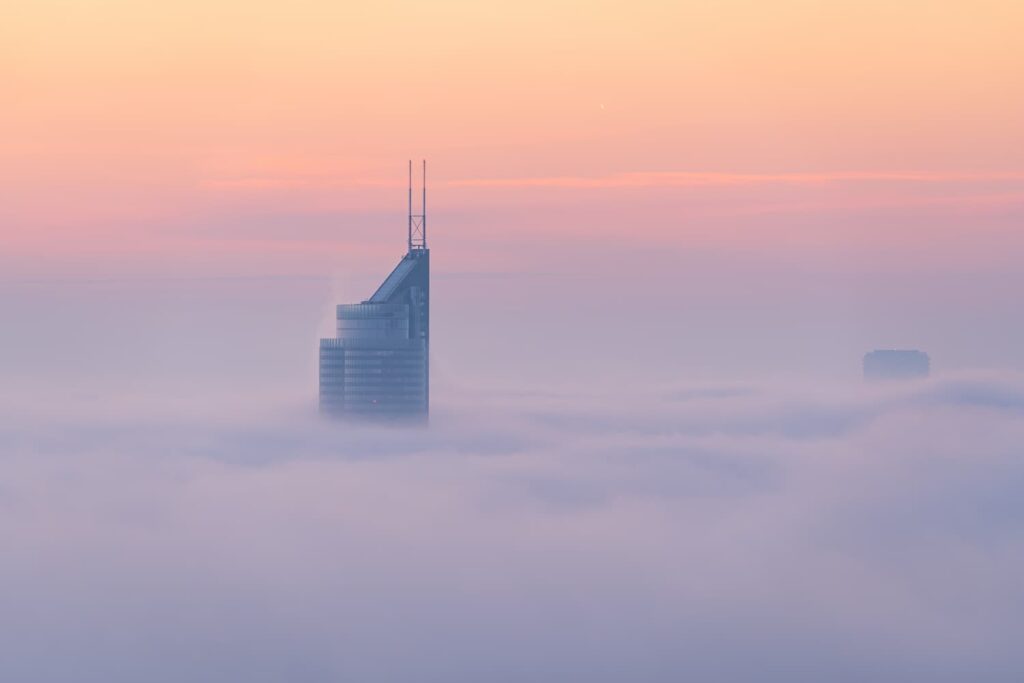
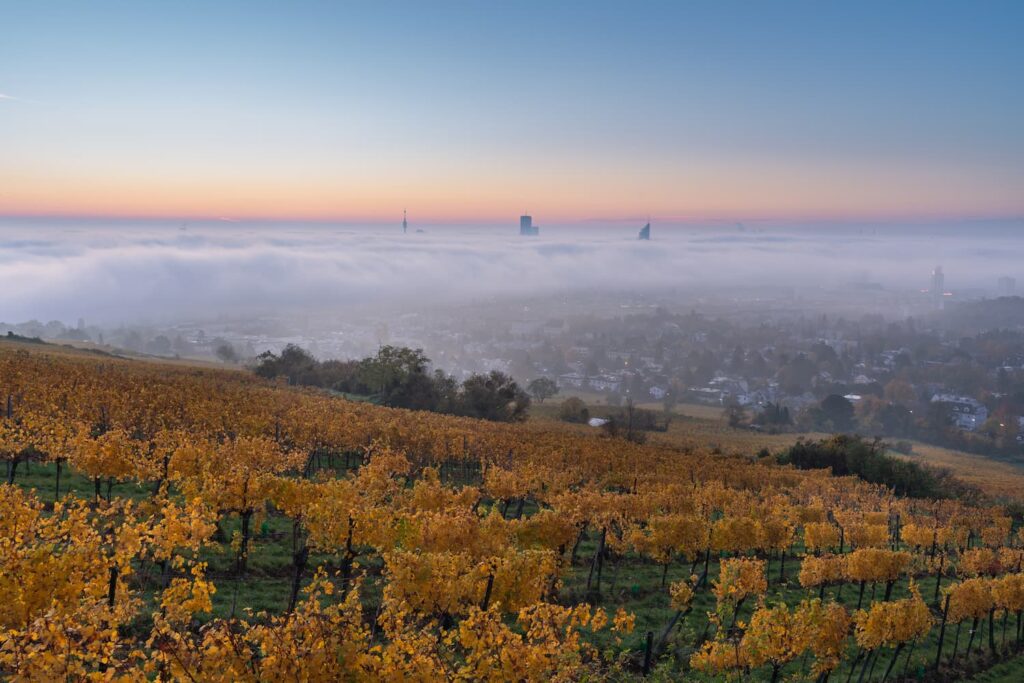
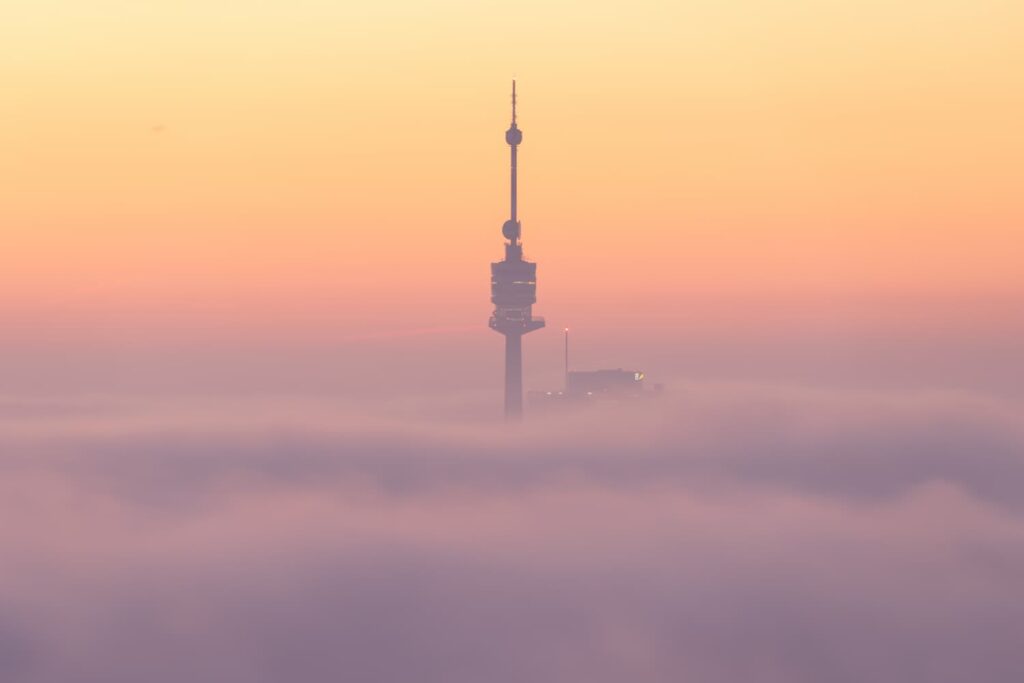
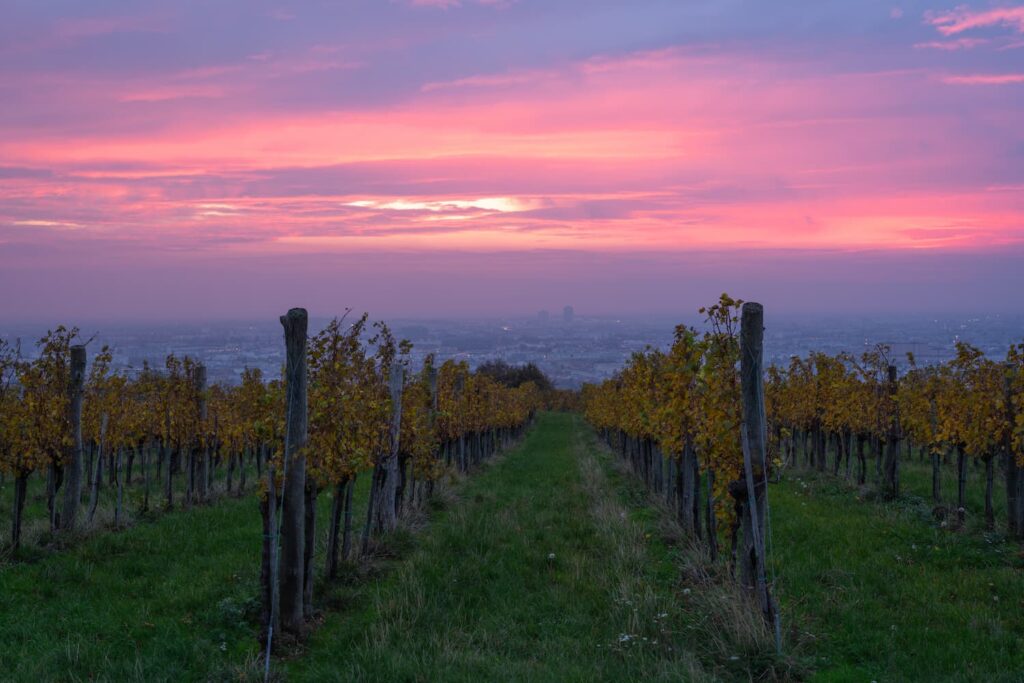
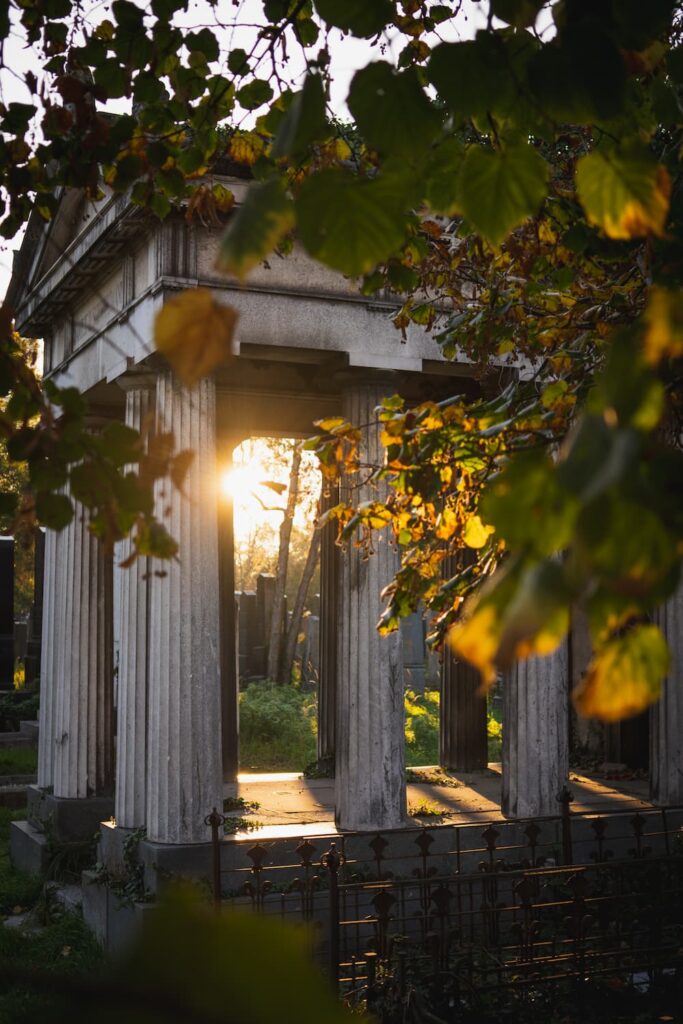
Autumn around Vienna
Then there’s the surroundings of Vienna. Being as well connected as it is, it’s easy to get to the surrounding towns, villages and countryside. There’s a myriad of options to enjoy the gorgeous autumn colours.
- Head to Schloss Laxenburg, explore the village, gardens and castles, in particular the romantic Franzensburg castle, situated on an island in a lake.
- Check out the small towns and villages around Vienna such as Mödling, Baden, Gumpoldskirchen, Perchtoldsdorf, etc.
- Explore the vineyards, they are very pretty in between Mödling, Baden and Bad Vöslau. Especially so in autumn.
- Hike in the Vienna woods:
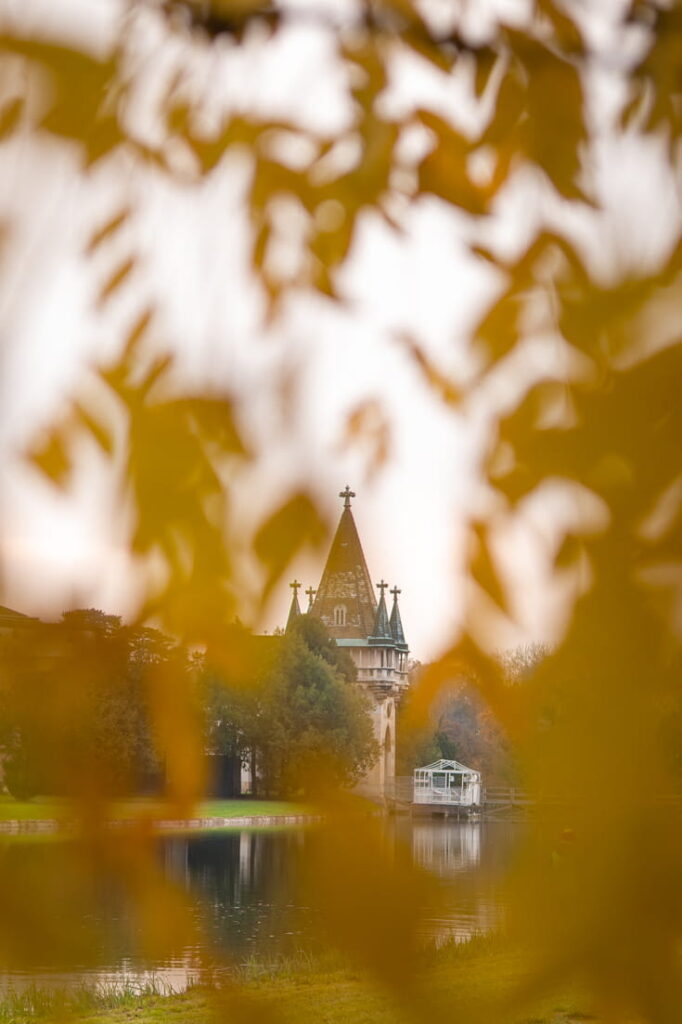
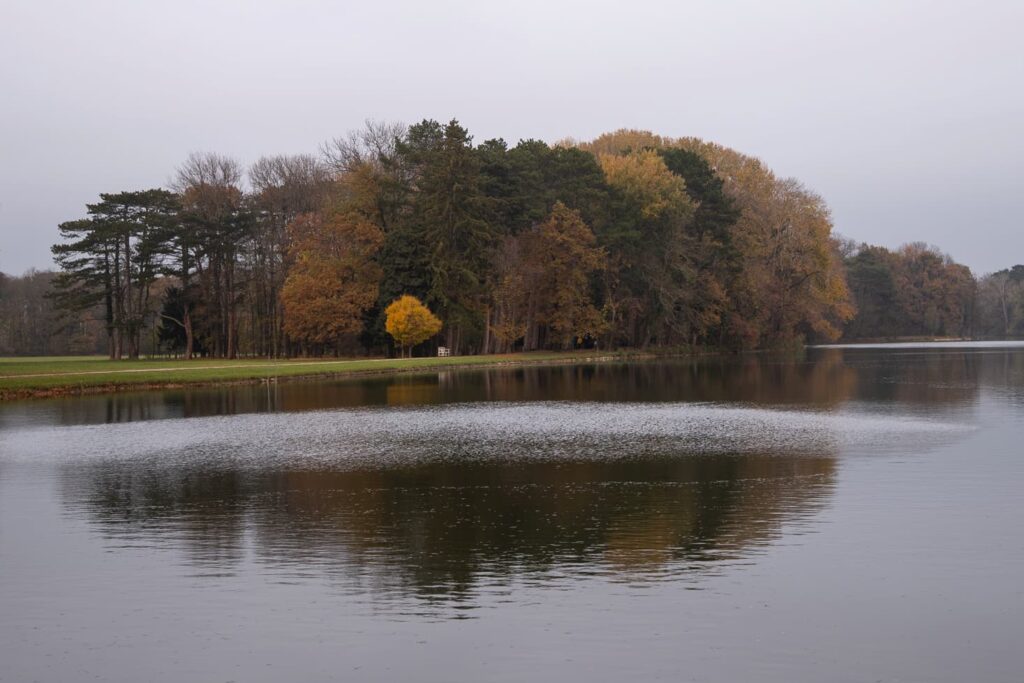
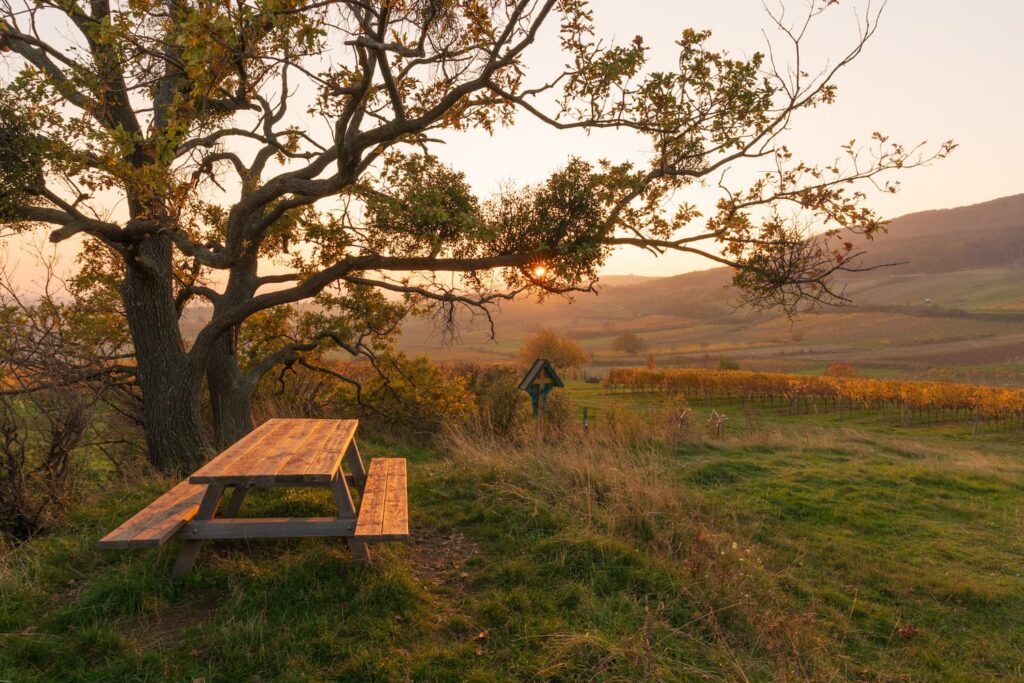
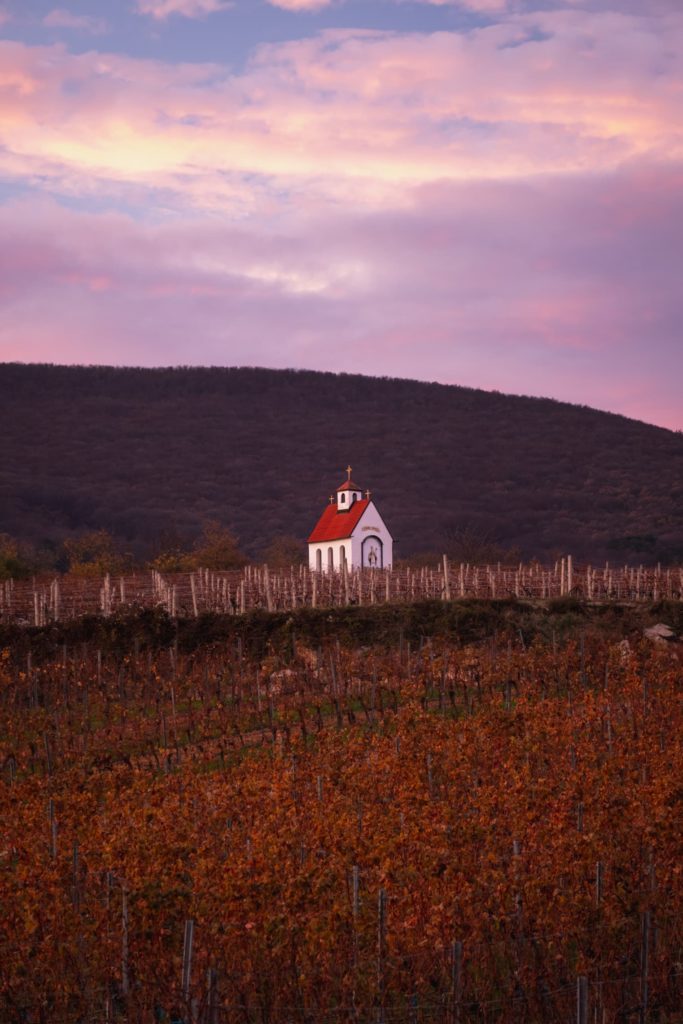
Luchs trail (Lynx trail) – Long distance hiking
The Luchs trail or Lynx in English is an 11 stage long distance hiking trail, the first long distance trail I’ve ever walked alone, that traverses the centre of Austria through the Kalkalpen and Gesäuse National Park. The mountain huts that you will stay in stay open in the season longer than many of the more well-known locations in Austria, but don’t let that fool you – the scenery is just as impressive, the lime stone peaks of Gesäuse are striking and formidable.
Since the huts stay open longer, it makes the area perfect for autumn hiking, better still, you will be very alone in the wild centre of Austria – I hiked for 8 days and saw but a few people on the trail and was quite often alone in the huts – apart from the last, Ennstallerhütte where an all day long party was occurring, not the best for sleep, but since it was the last night of the season, a little celebration was a nice end to the adventure.
Overall, it was an incredible experience and I would recommend lone long distance hiking and in particular the Luchs trail to anyone looking for an epic autumn adventure – and maybe you will see the lynx, he exists!
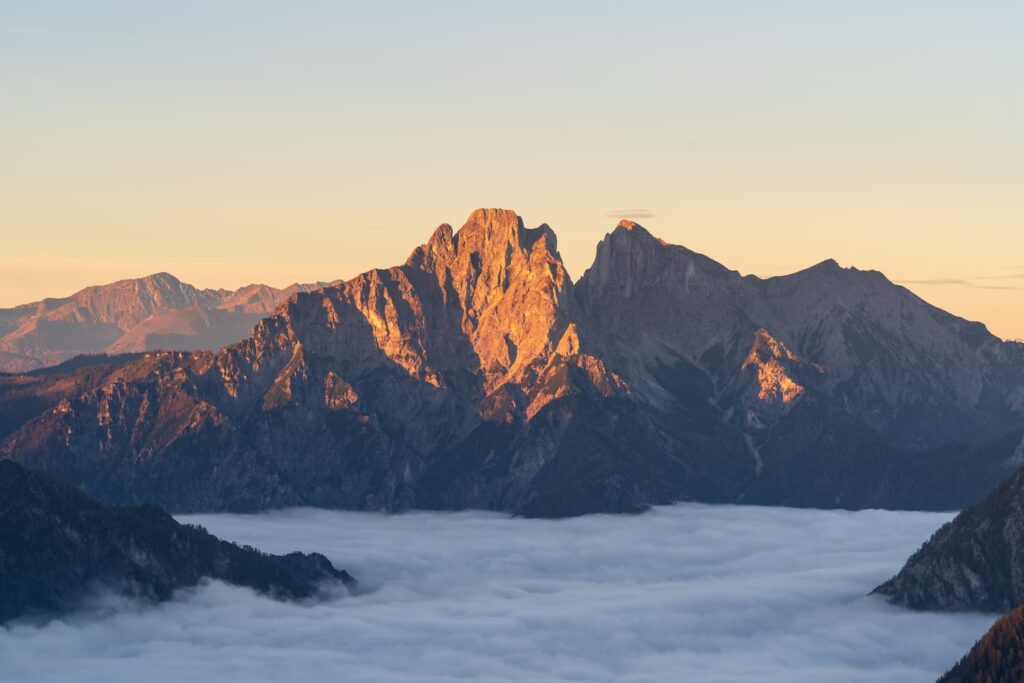
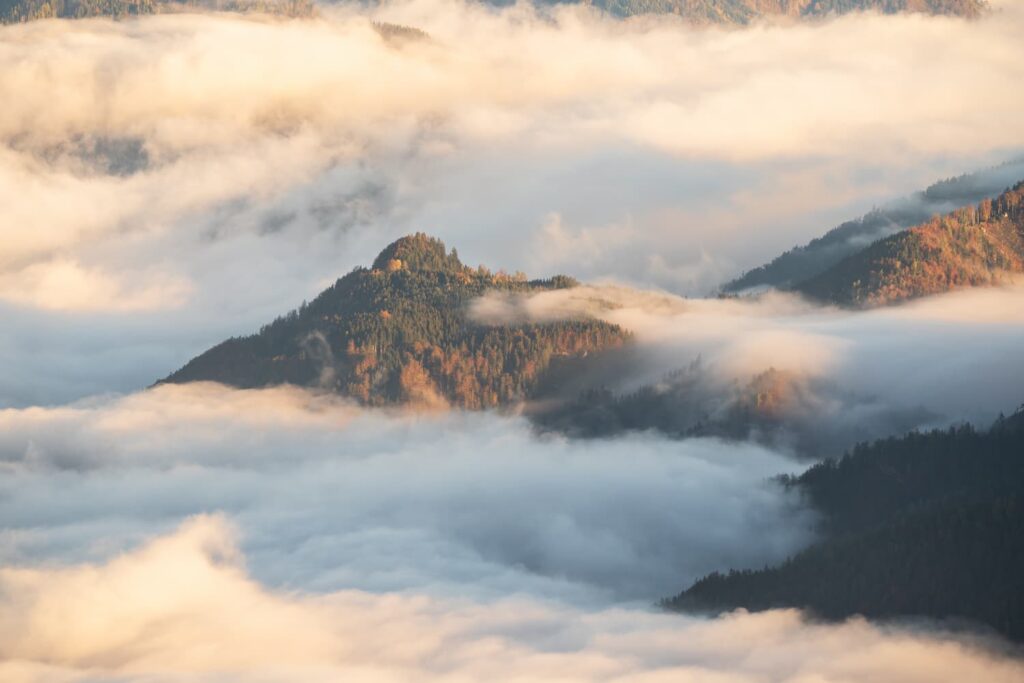
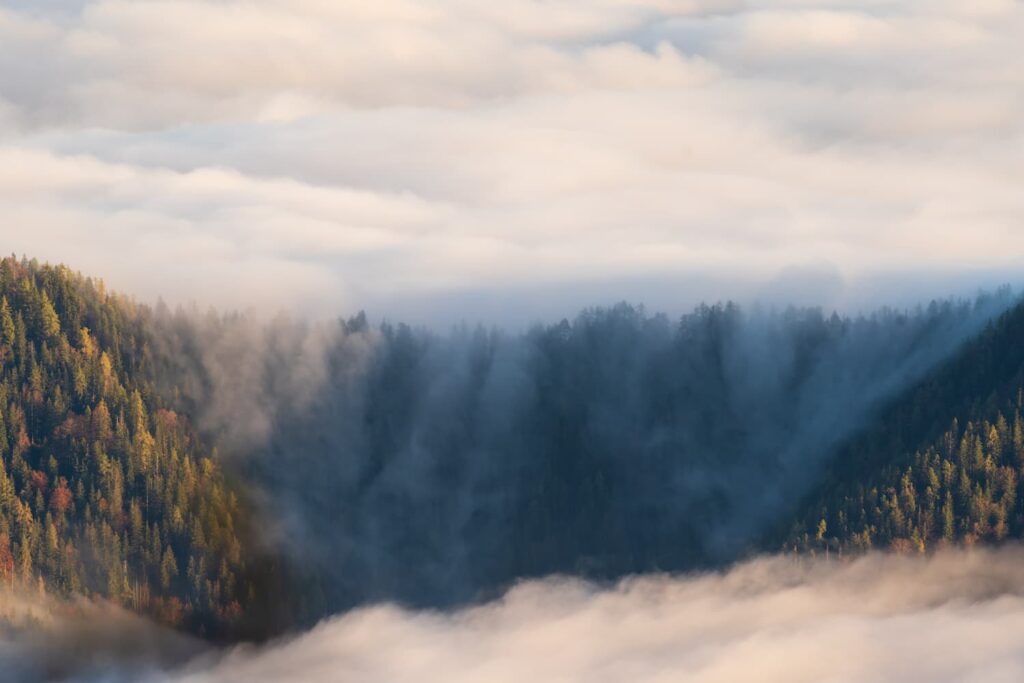
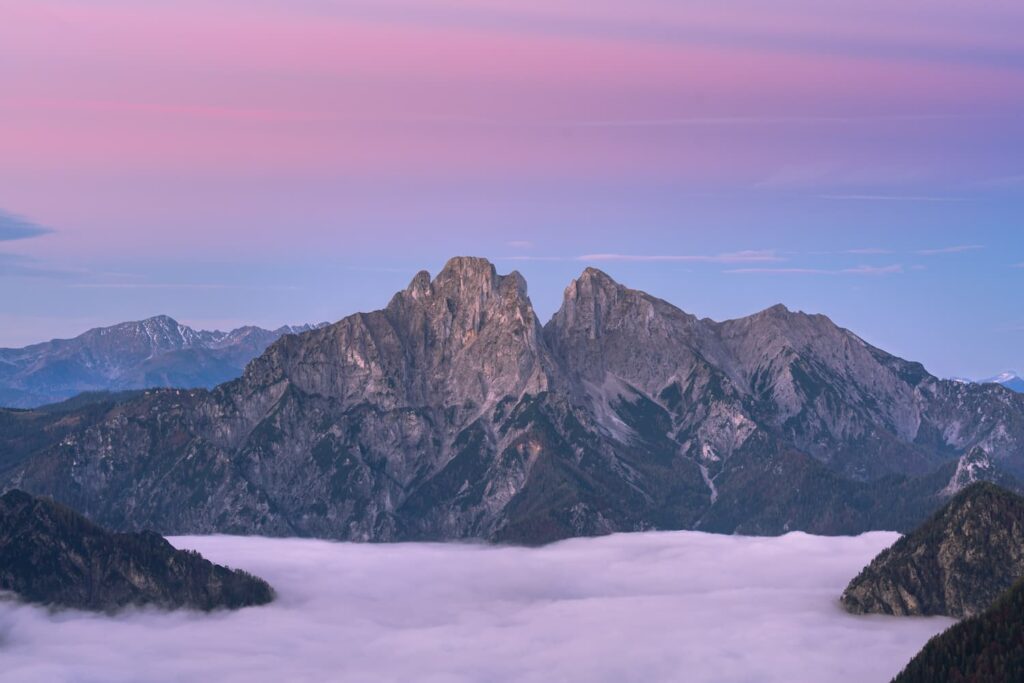
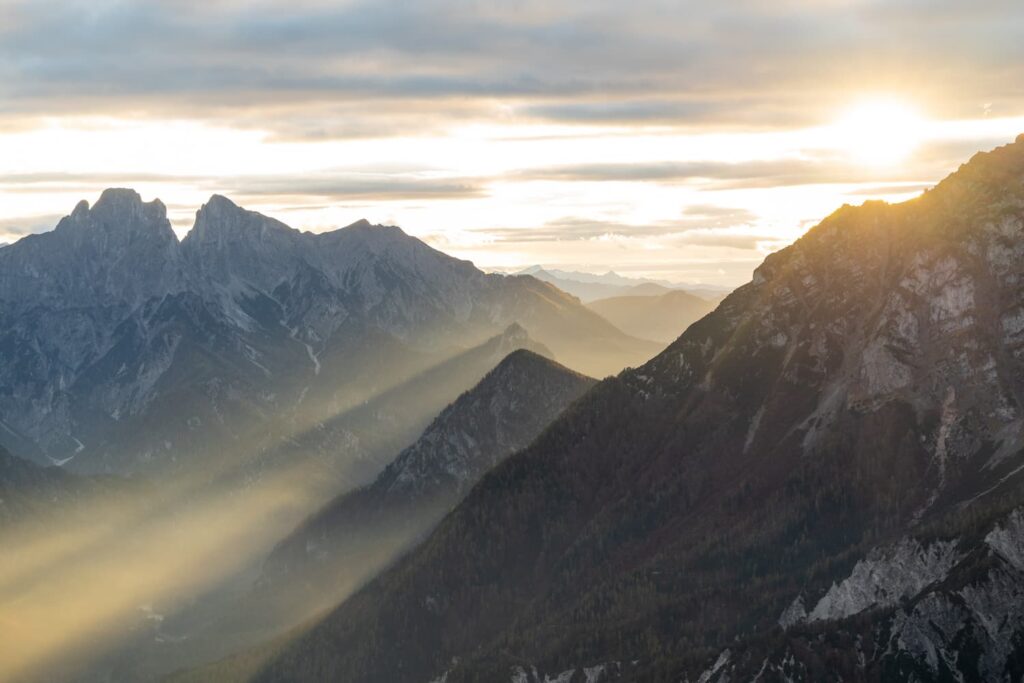
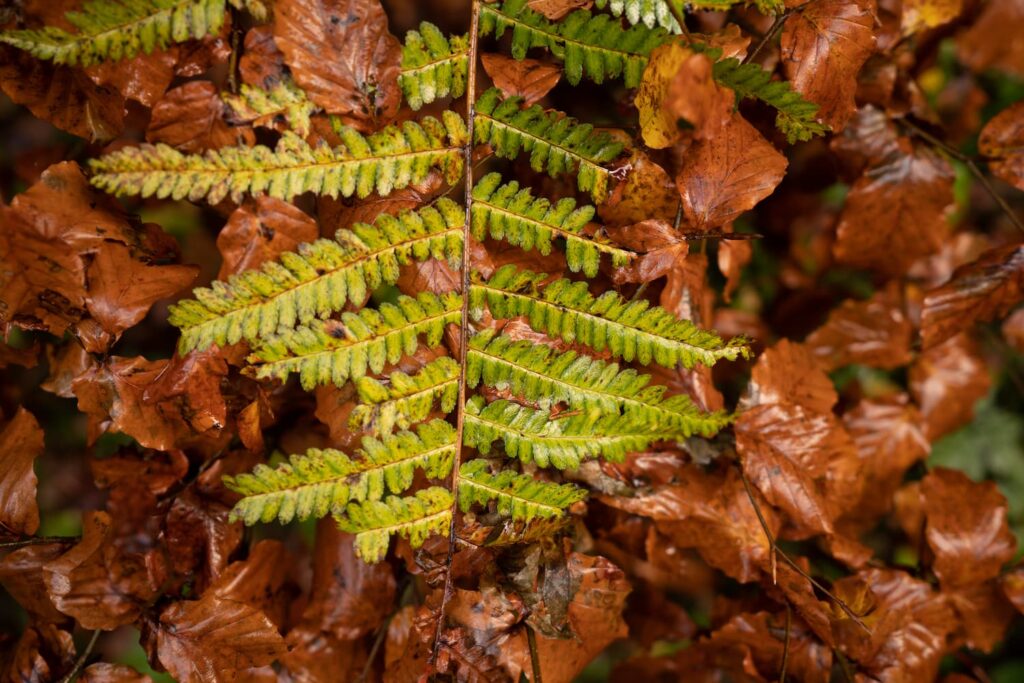
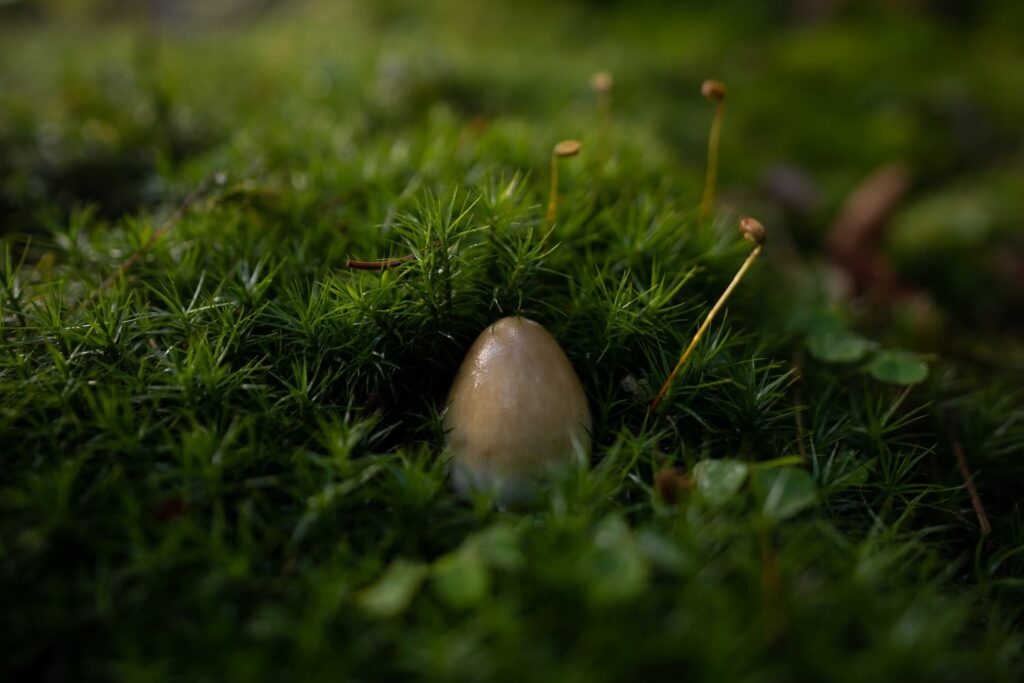
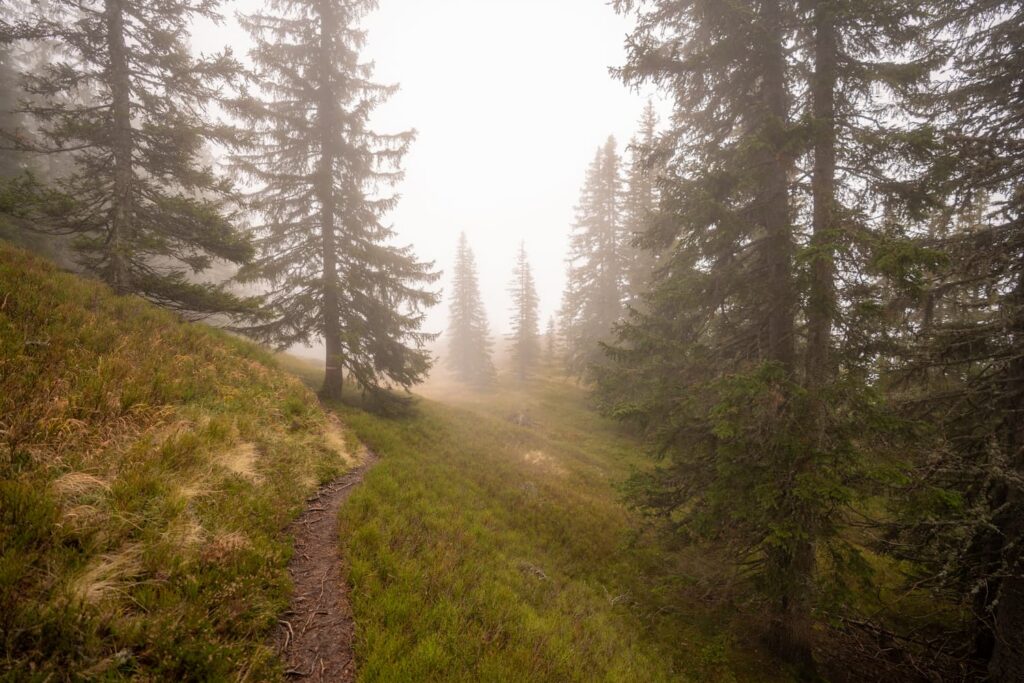
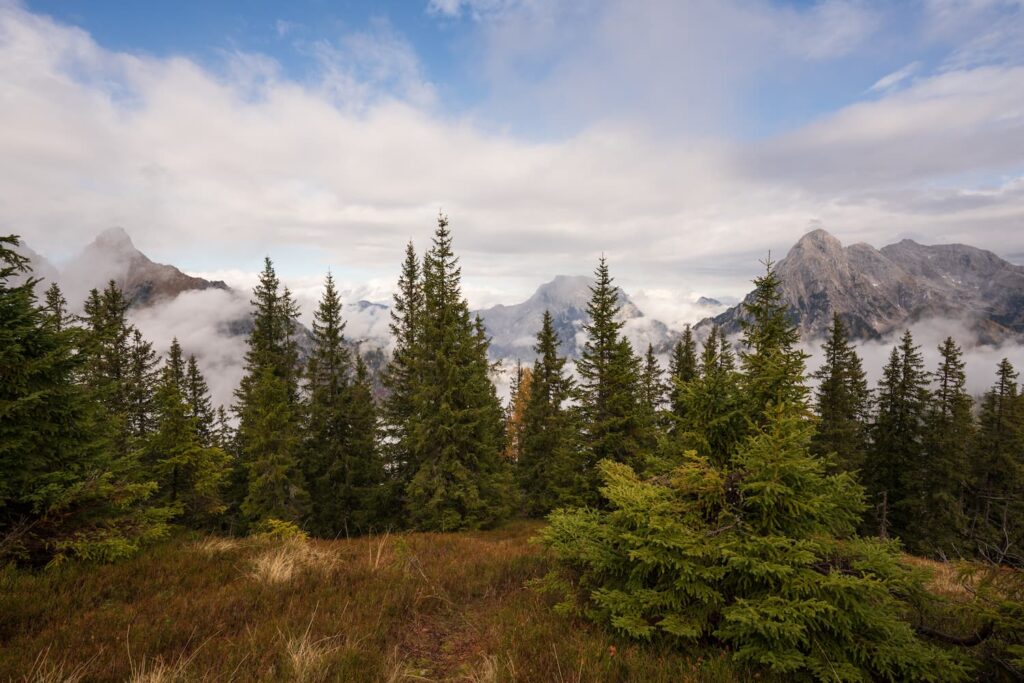
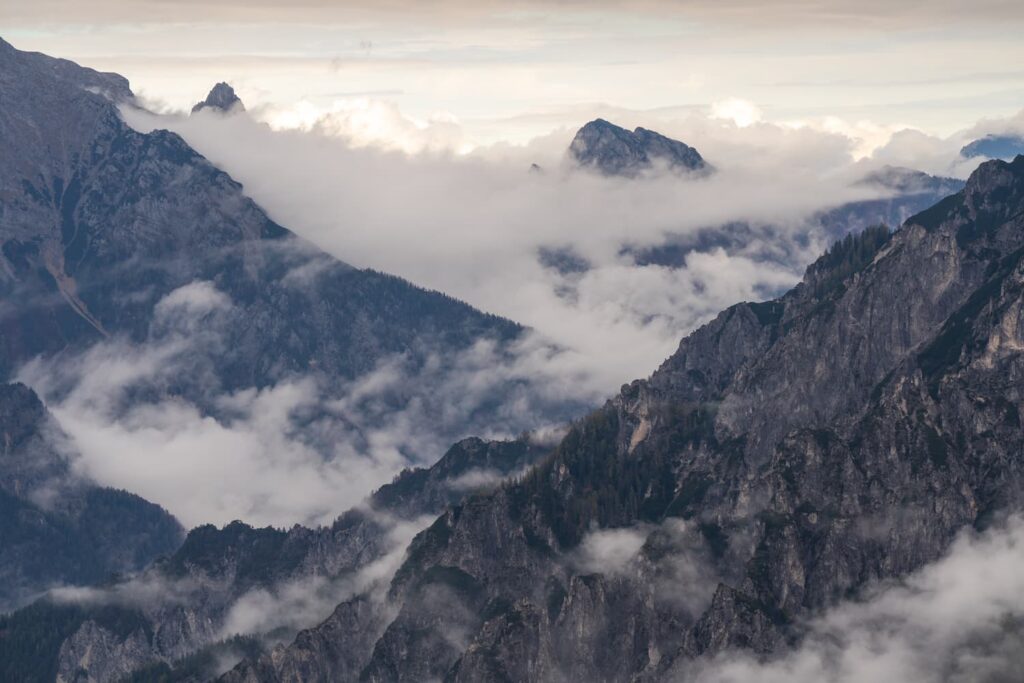

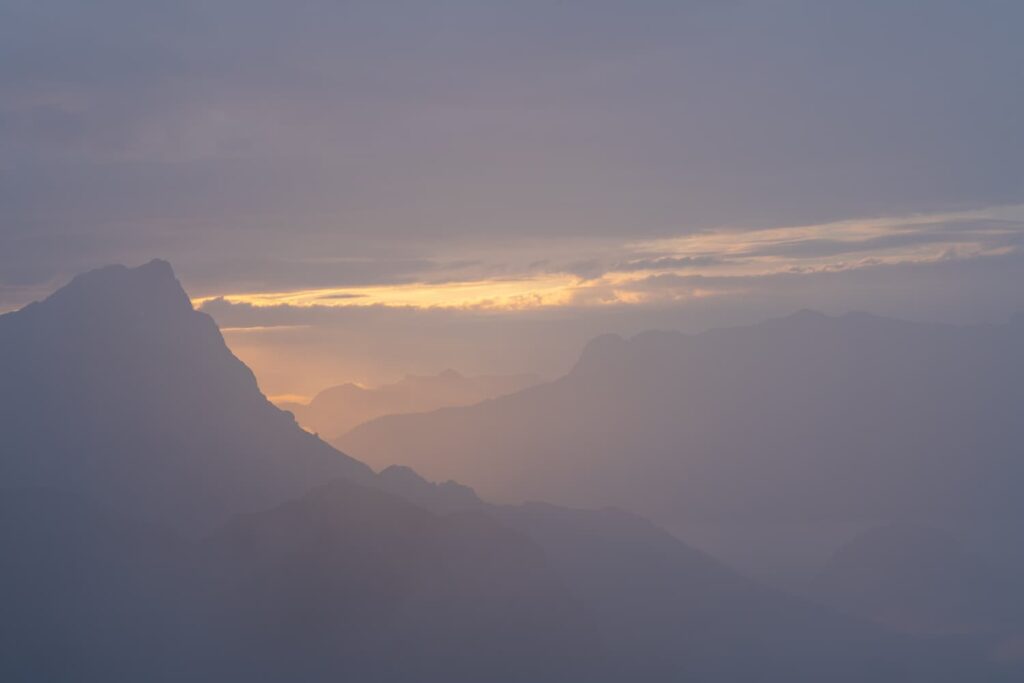

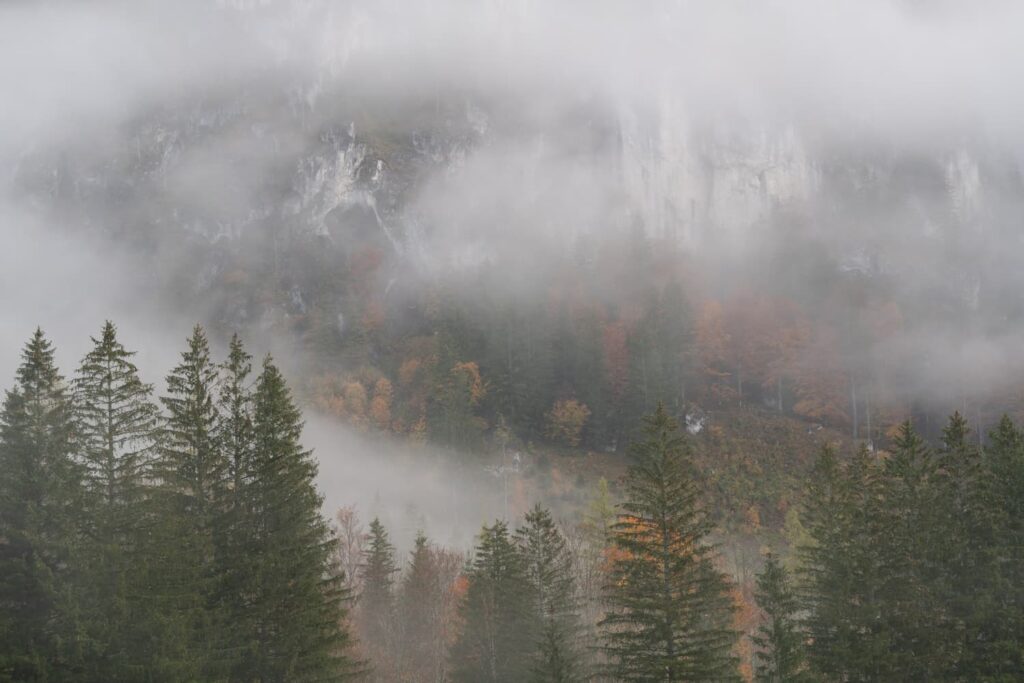
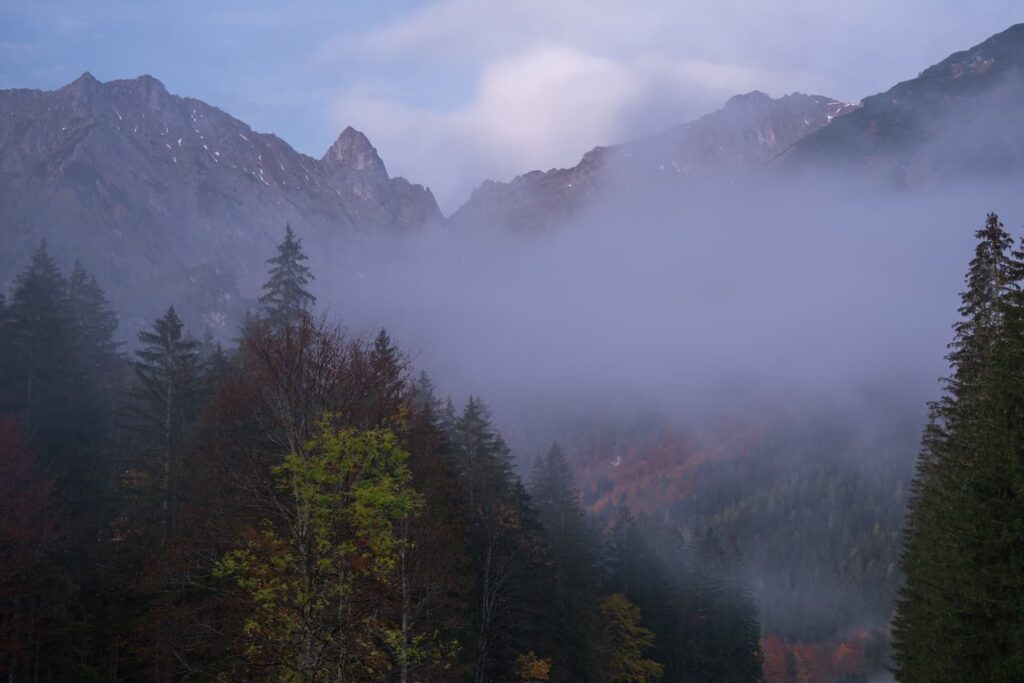
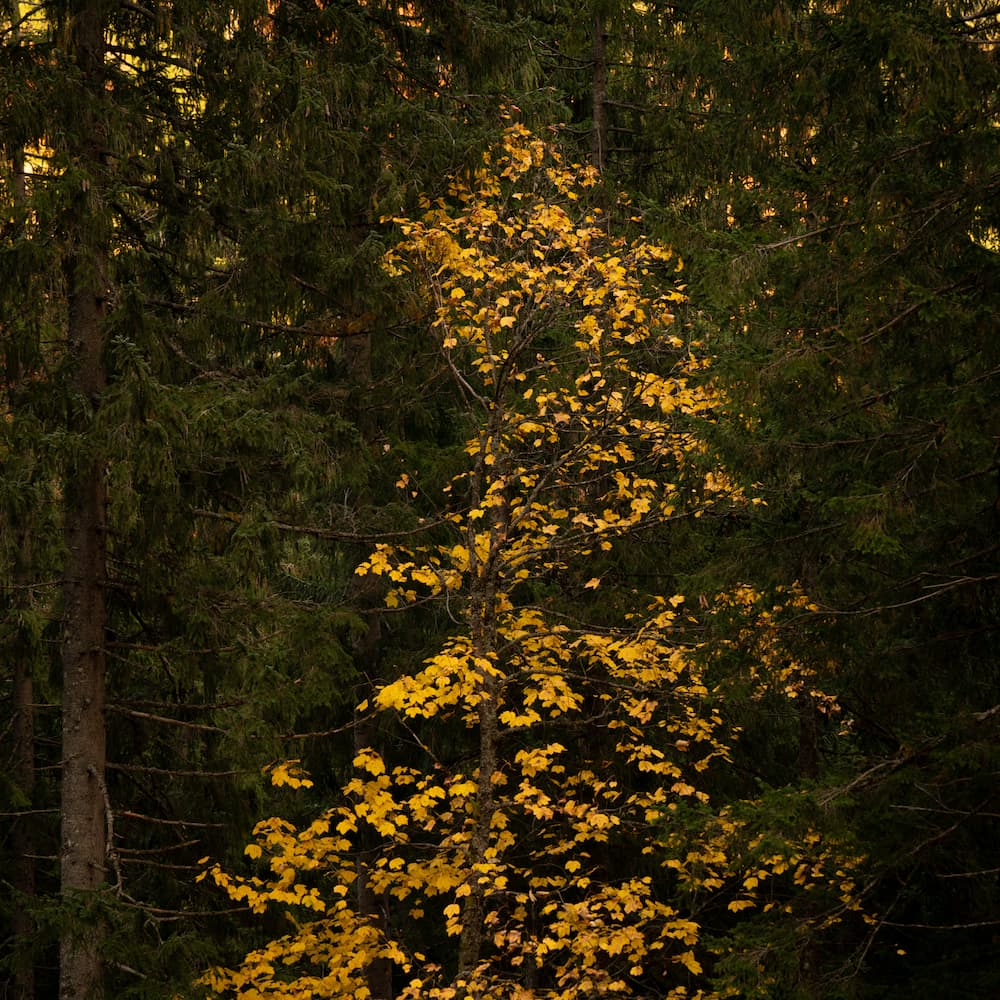
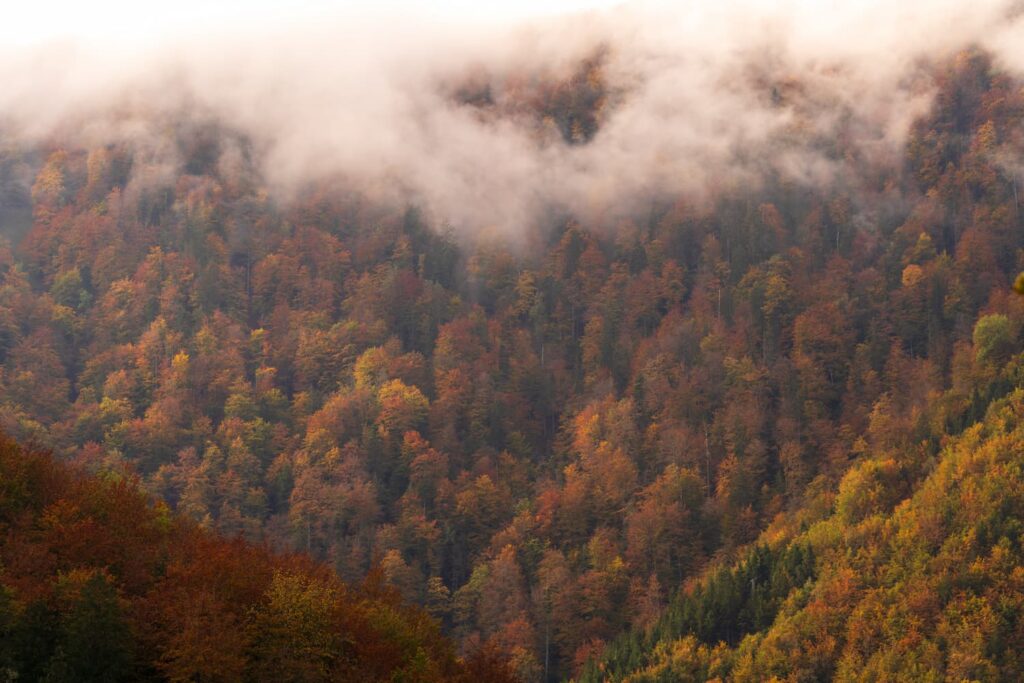
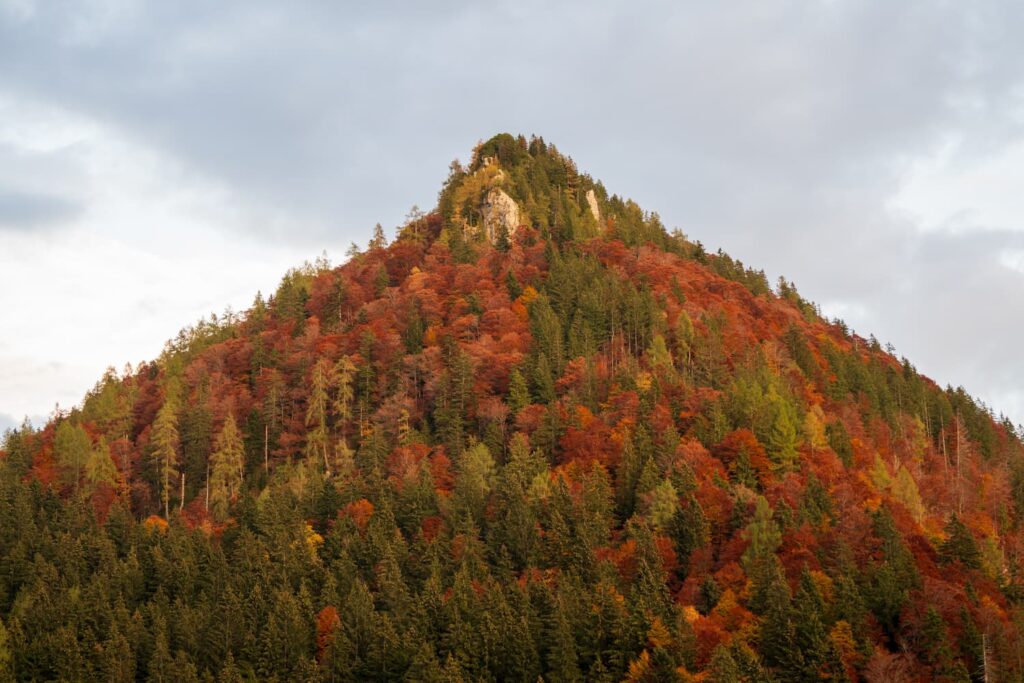
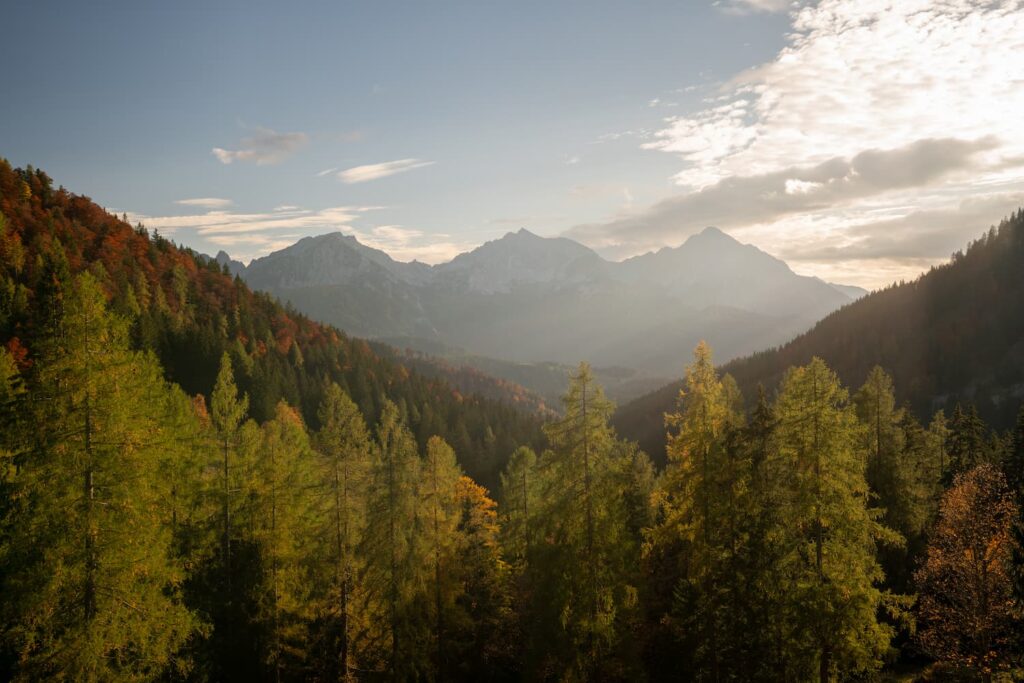
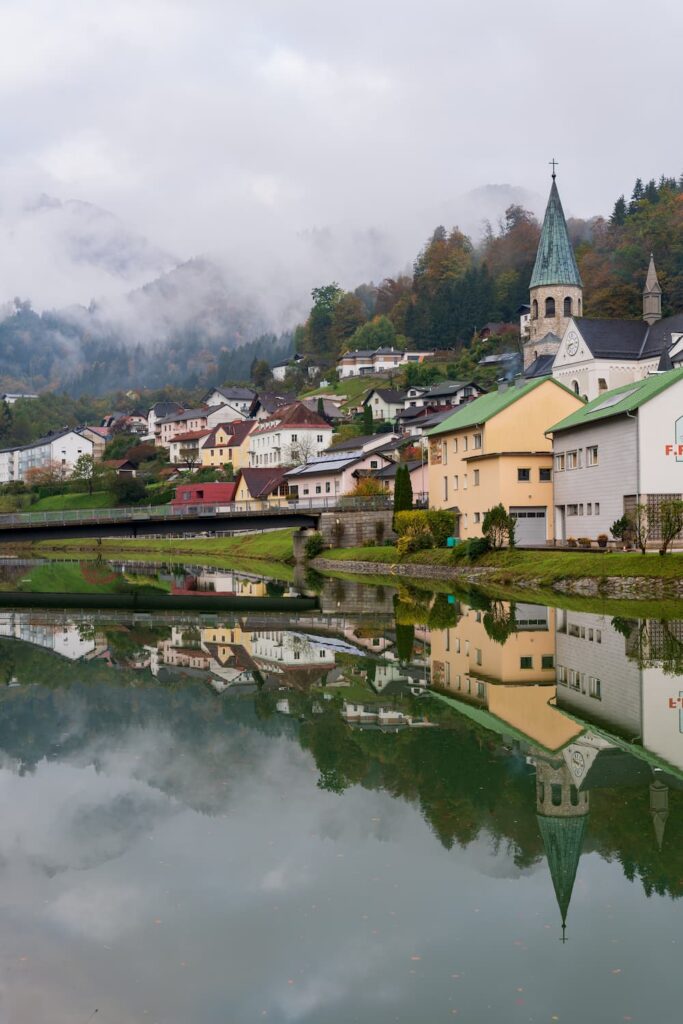
Gesäuse National Park
It’s worth mentioning Gesäuse National Park again, because we’ve visited many times outside of me walking the Luchs trails. There are many fantastic trails and peaks to climb, and it’s fairly accessible from Vienna. As you can see, autumn is always interesting, with good weather and especially in bad weather, it’s hard to beat a bit of mountain drama. There are some really great mountain huts in Gesäuse National Park, in particular: Buchsteinhaus, Ennstallerhütte & Admonter Haus.
For multi day hikes take a look at the Luchstrail in the section above, we will detail here smaller loops and overnight stays.
Some of our favourite trails include:
- Gstatterboden to Ennstalerhütte – A stop at Ennstalerhütte is recommended, the food and atmosphere are hard to beat. We can also recommend to extend the tour to the Tamischbachturm peak for sweeping views over all of Gesäuse. Finally you can make the tour a loop and take a different way back down to Gstatterboden.
- Buchauer Sattel to Admonterhaus – We recommend to stop the night at Admonterhaus, it’s also a really nice hut with good food. From there you can take some other tours. First to Admonterwarte, it’s just a twenty minute scramble from the hut with magnificent views, especially during sunset and sunrise. A longer tour takes you to Mittagskogel and possibly on to Hexenturm, but that’s a bit trickier.
- Gstatterboden to Großer Buchstein – This is quite a strenuous tour, an over night stay is recommended at the Buchsteinhaus, a very nice modern hut. It’s a hiking route but there are also climbing routes. The views from the top reach to Dachstein and Großglockner on clear days .
- Mödlingerhütte to Johnsbach – Mödlingerhütte is a bit tricky to make a loop with public transport. We started in Gaishorn am See, where you can take a train to and hiked this trail. The next day, we joined the Luchstrail stage and continued to Johnsbach. This is one of my favourite stages of the Luchstrail. The forest is ancient, and during autumn you will see bizarre mushroom growing out of every bit of rotting wood. If you have your own transport you have a few more options and can maybe start from Kaiserau.
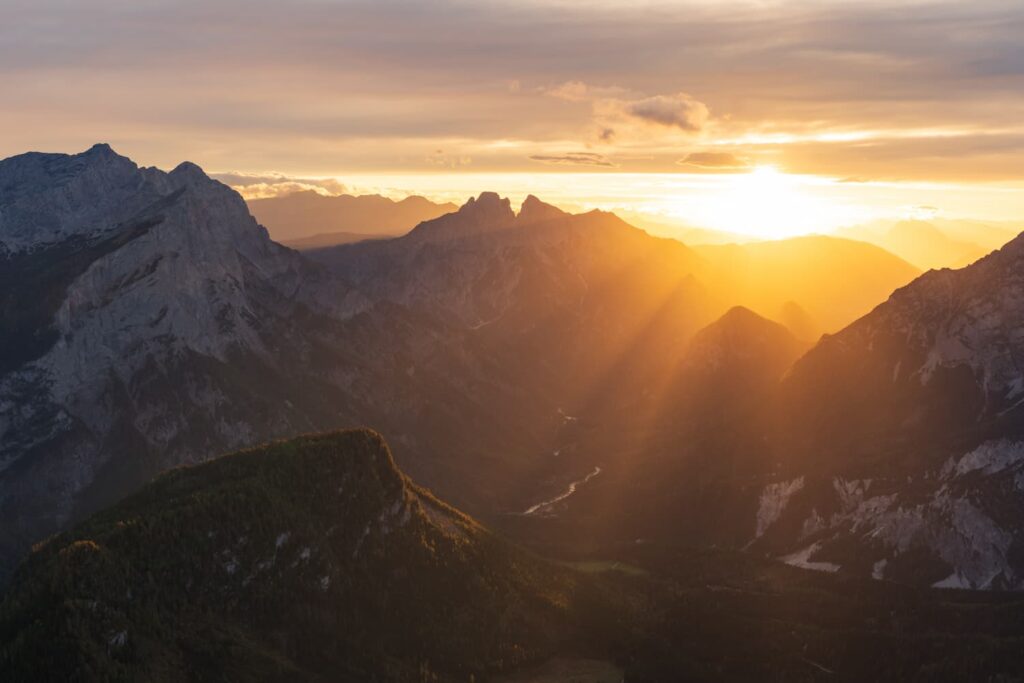
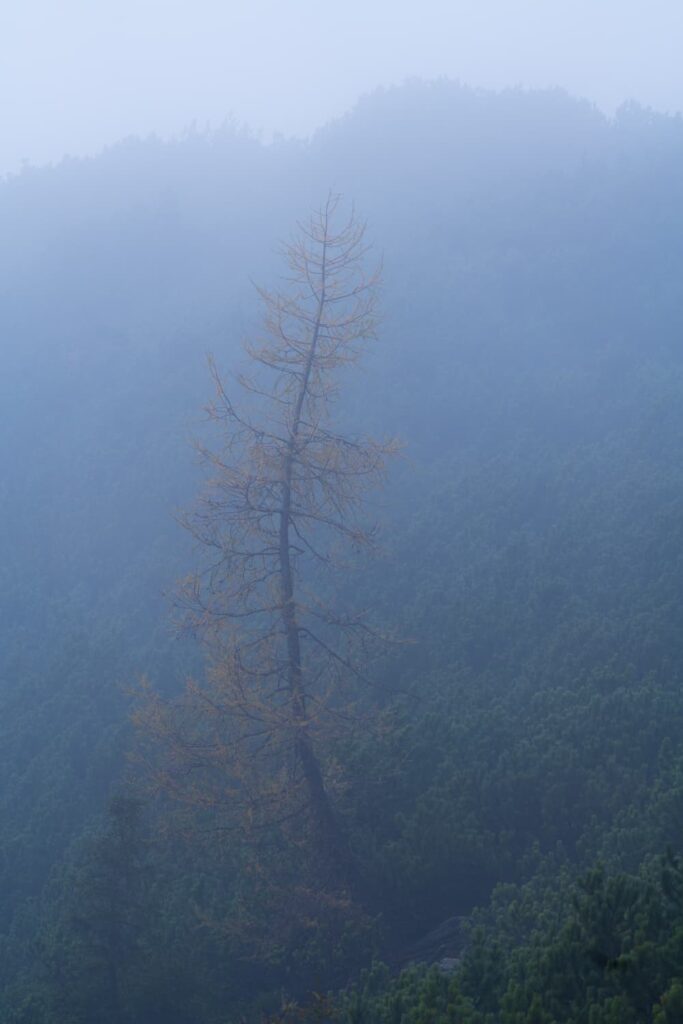
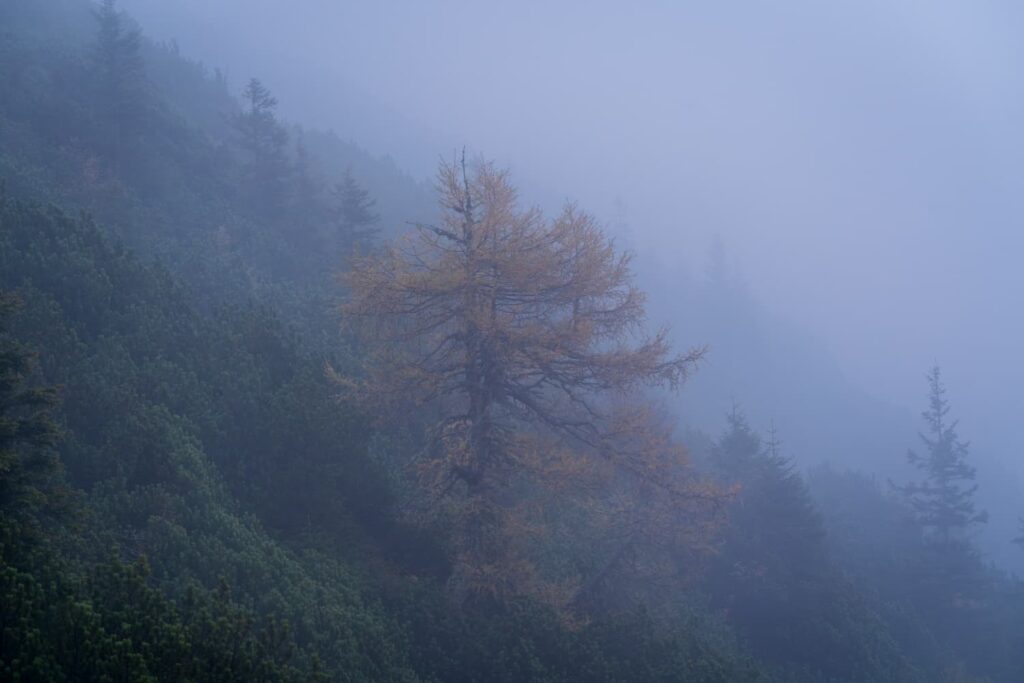
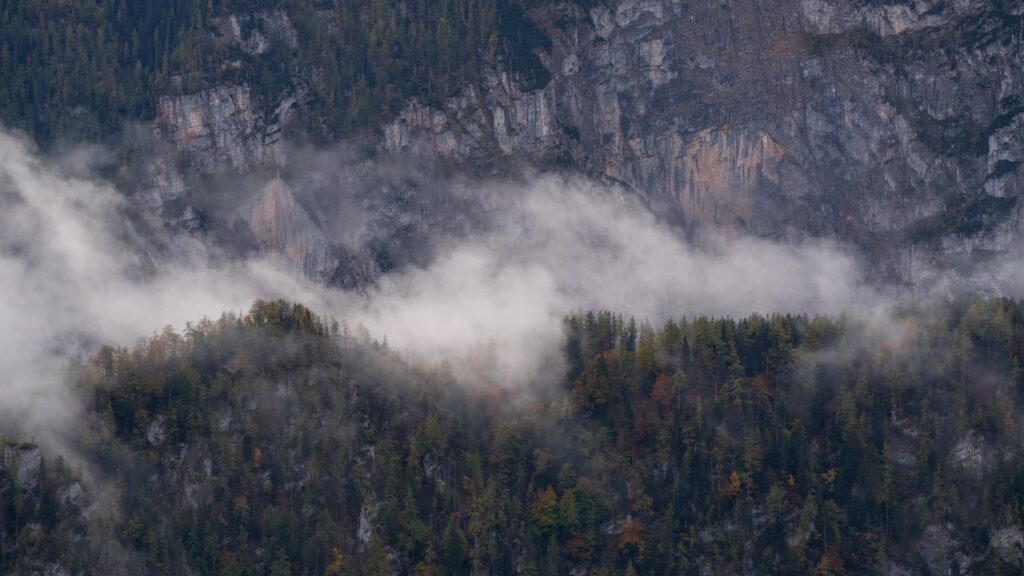
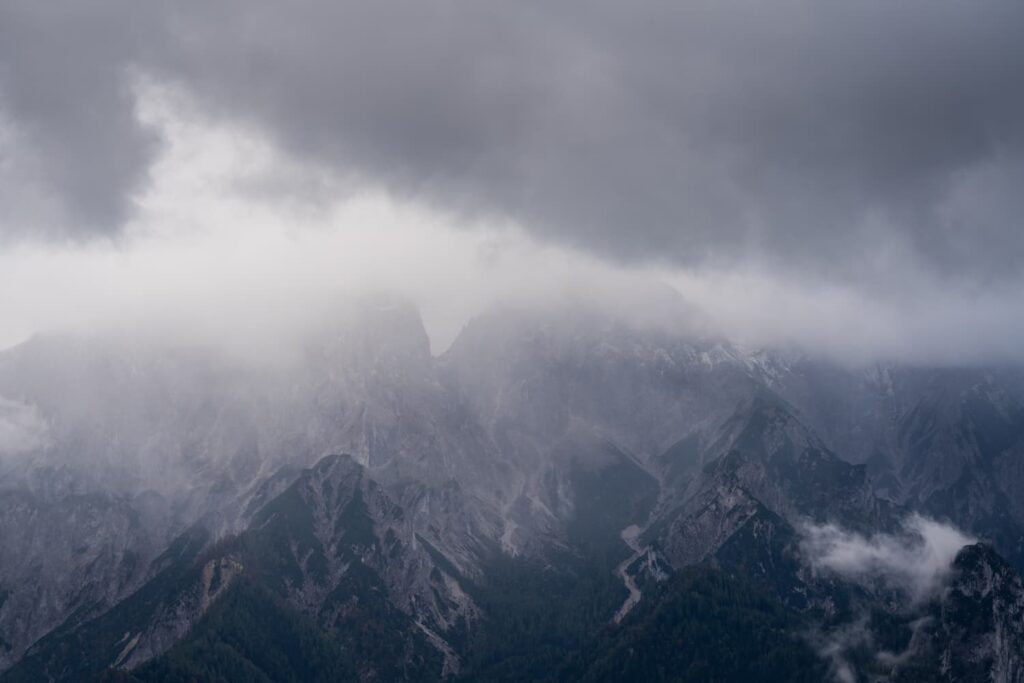
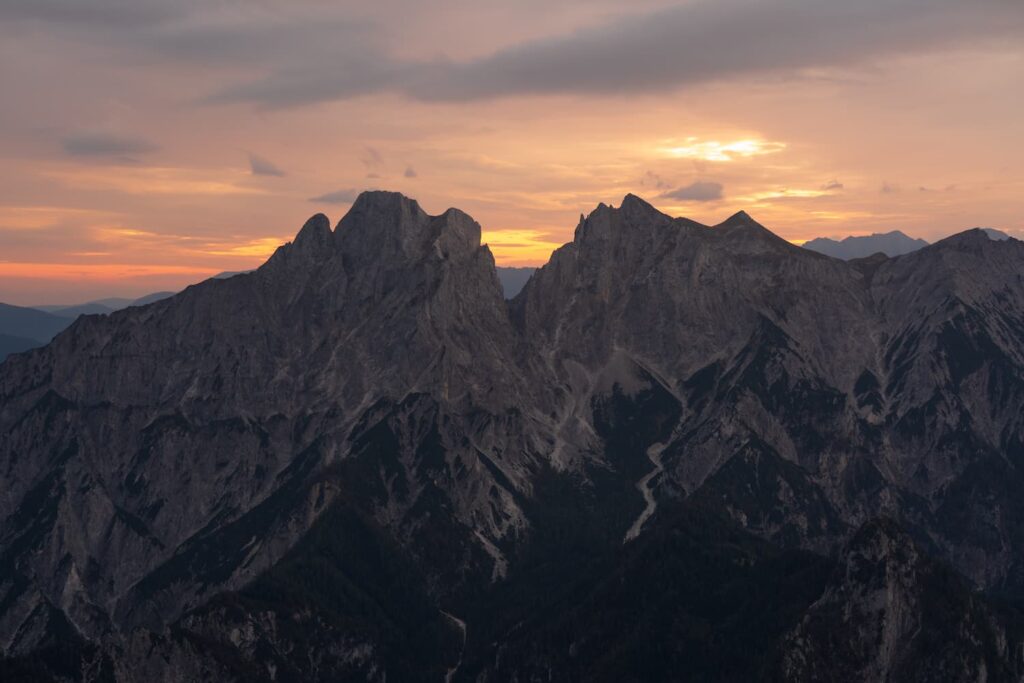
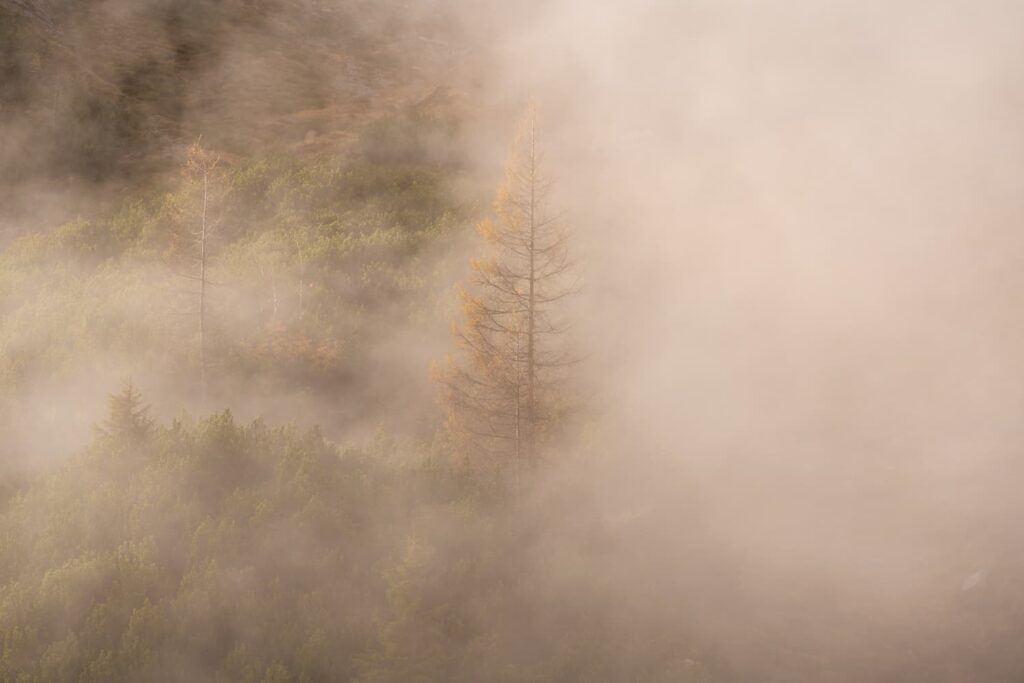
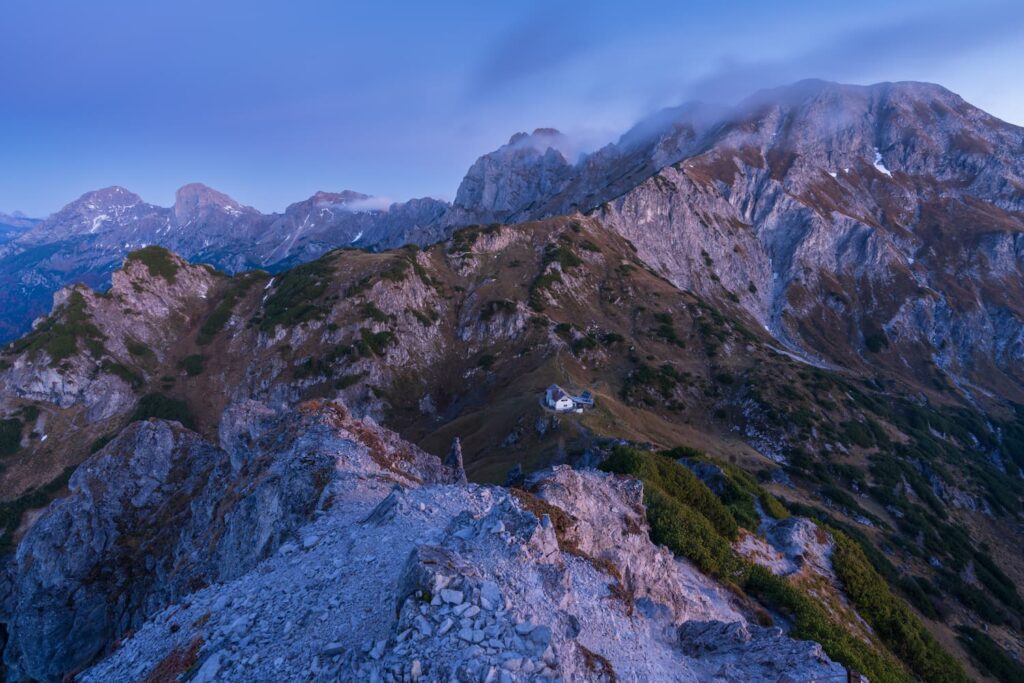

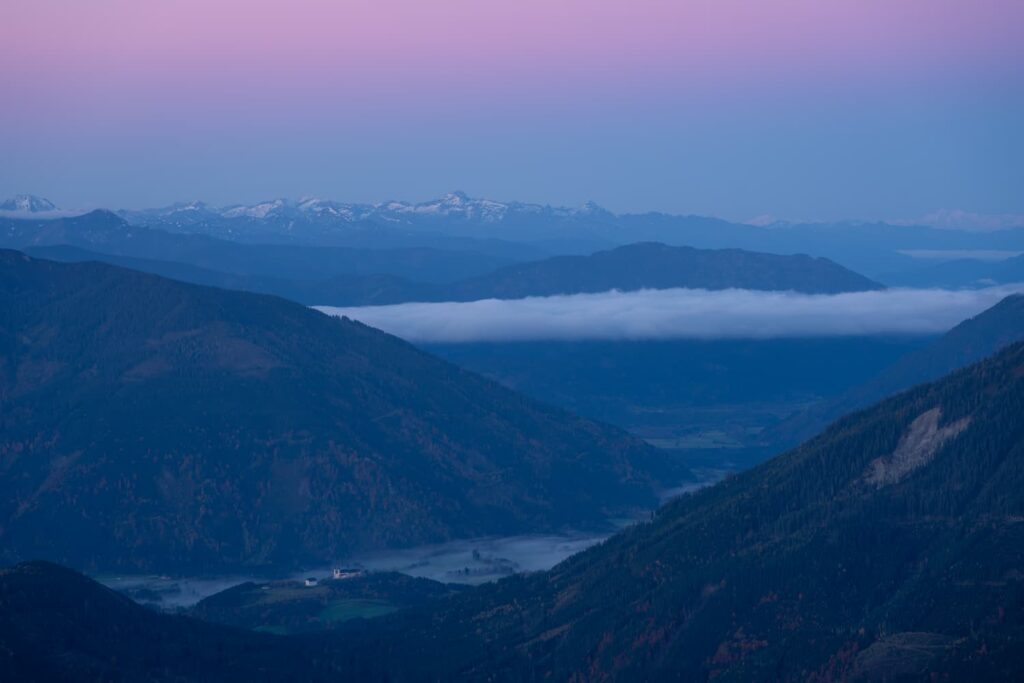
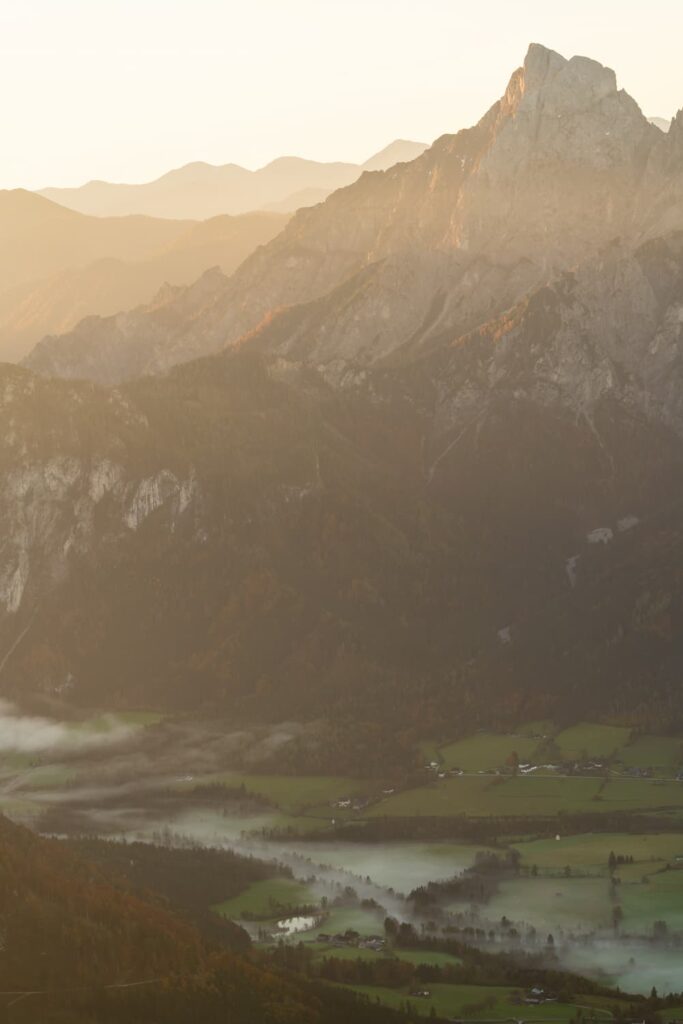
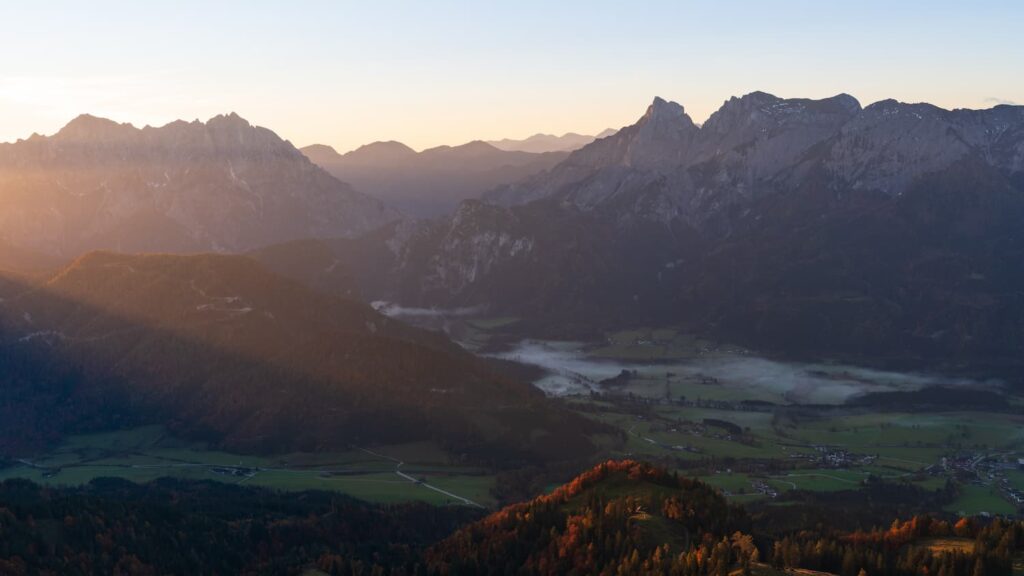
Hochschwab Mountains
I first visited Hochschwab in October 2024 on a last minute three day expedition, managing to snag a place in the Schiestlhaus on its season closing weekend. I didn’t really know what to expect except an autumn adventure – and well, an adventure was a slight understatement. There was a freak storm covering the mountain in snow. Most hikers cancelled their reservations, whilst I and two other people were stuck in the hut on top of Hochschwab for almost 36 hours with little to no visibility the whole time.
The final day I stayed in Häuslalm, an incredibly cute rustic wooden Alm fitted out with creaky floors, low roofs, tiny bedrooms and an incredibly cosy log fire with delicious food an a magnificent view over the Bodental valley. I woke up early, but not early enough, because unbeknownst to me, the clocks had changed and I almost missed the sunrise. Quickly jumping out of bed I ran up the mountain beside the hut (Buchbergkogel) and watched in awe as the sun slowly warmed the golden larches and melted away the low hanging valley fog.
I pieced this hike together with a few separate trails, starting in Seewiesen and ending at Grüner See. I used public transport to get to and from the start and end of the hike and it all went pretty smooth!
3 day hike from Seewiesen to Grüner See
- Day 1: Seewiesen to Schiestlhaus – You can also take the higher path, starting from Seebergsattel, the next bus stop from Seewiesen. The higher track is a little harder, but has more panoramic views.
- Day 2: Schiestlhaus to Häuslalm – I could not find a description for just this section, so just use the portion between Schiestlhaus and Häuslalm. You could also do this whole section from Schiestlhaus to Bodenbauer, also in one day. But there is no public transport in Bodenbauer.
- Day 3: Häuslalm to Pichl-Großdorf via Grüner See.
Other hikes when you have your own transport
- Bodenbauer to Buchbergkogel – This one you can also do in the winter with snow shoes. It’s incredible in snow.
- Bodenbauer – Schiestlhaus – Häuslalm round trip – This is the more traditional loop starting and beginning at Bodenbauer. The way up is really fun with a massive metal staircase/ladder and ropes, but it’s not so tricky.
- An easy hike through a stream with some waterfalls.
- As usual, there are many more hikes in the area – these are just a select few that we have done already.
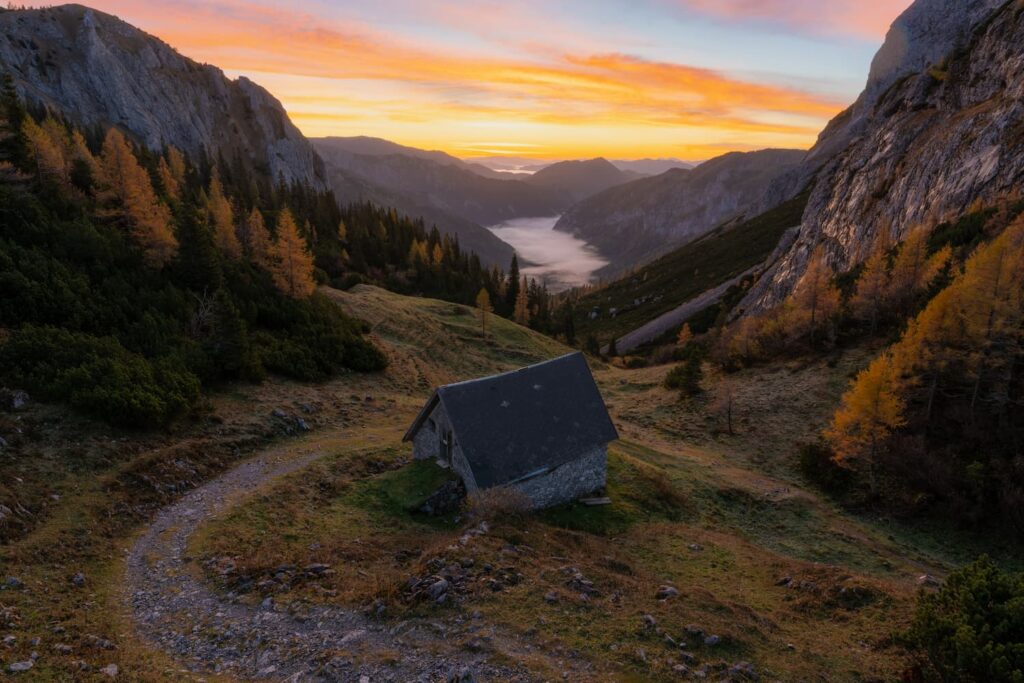
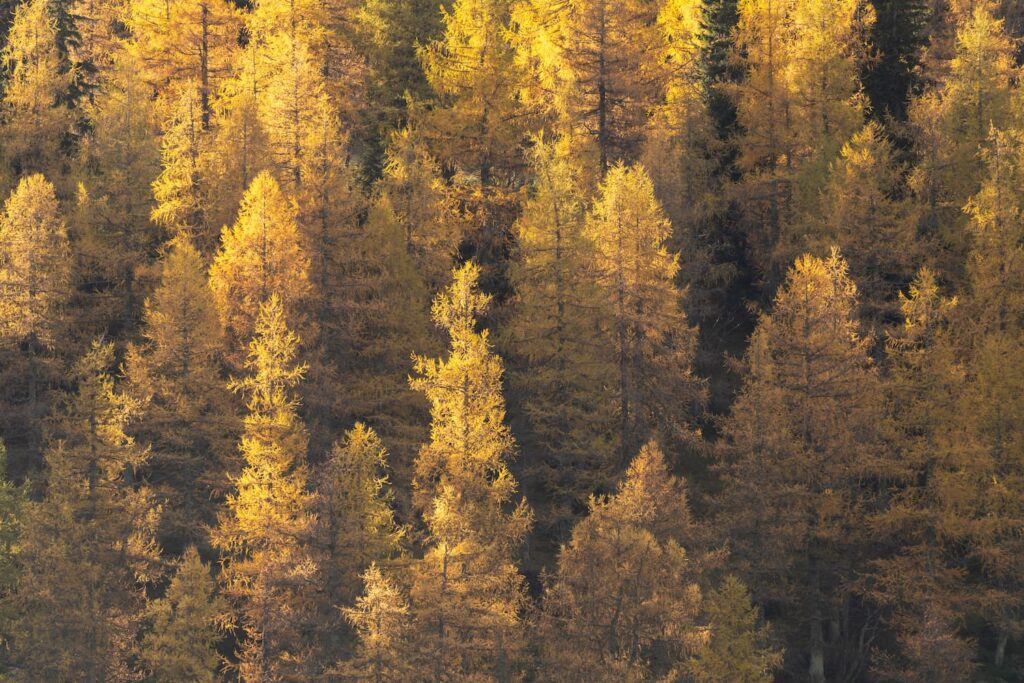
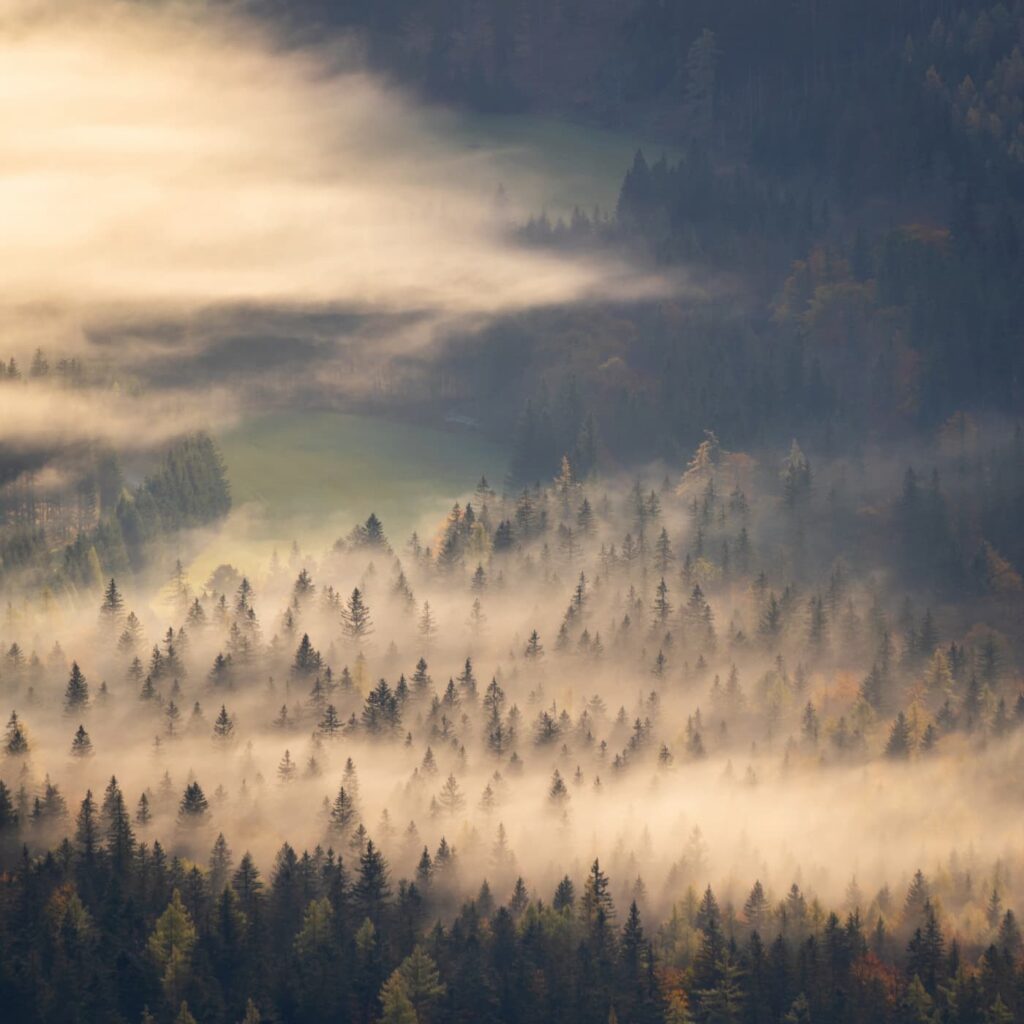
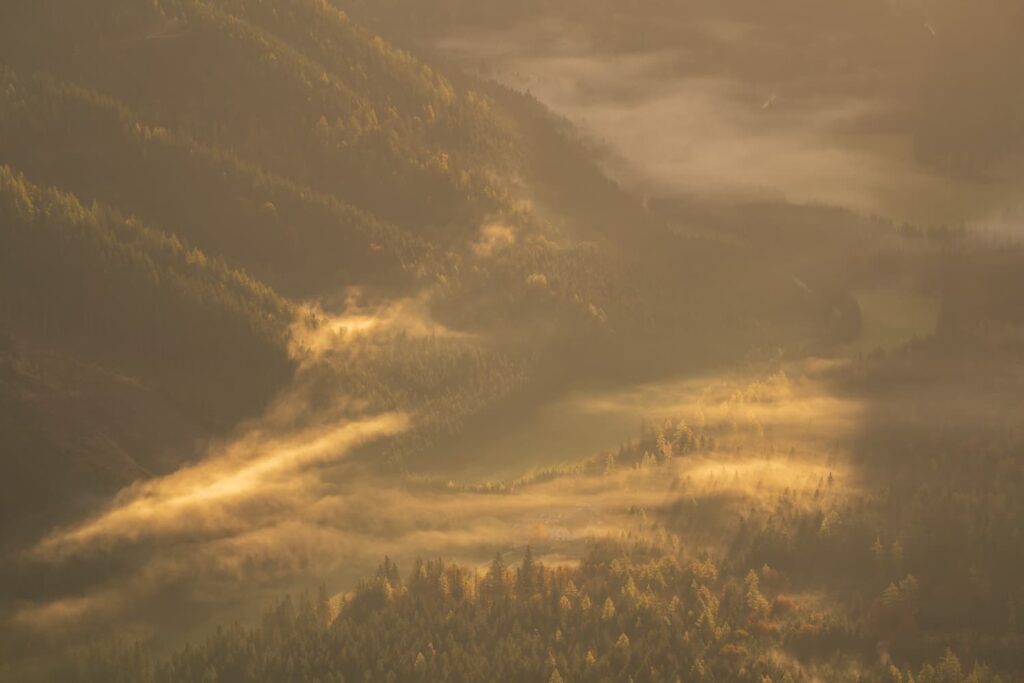
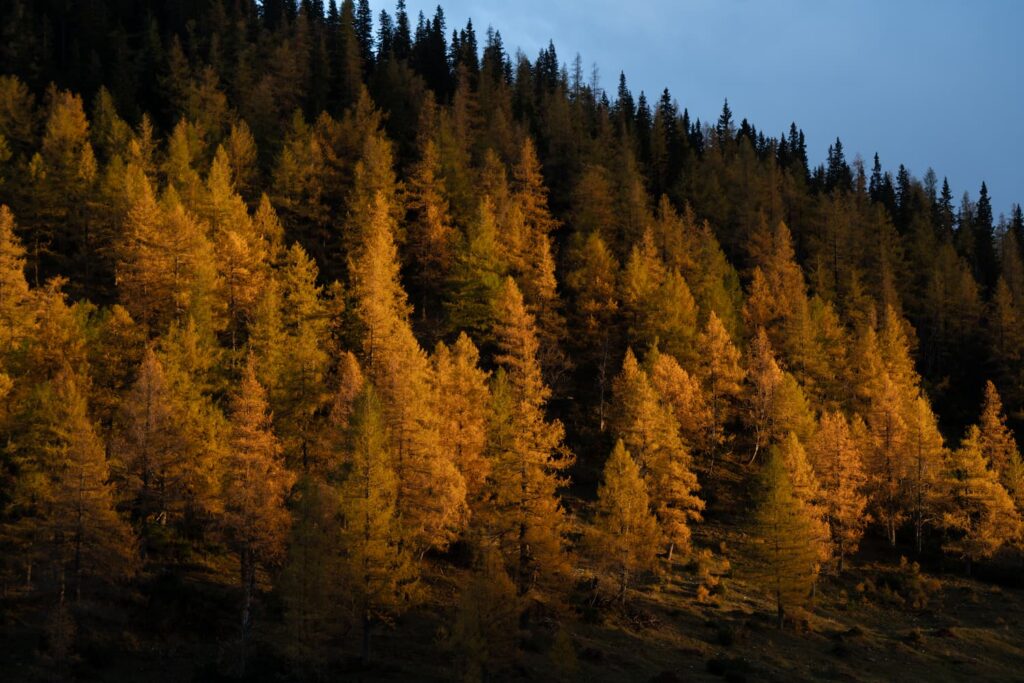
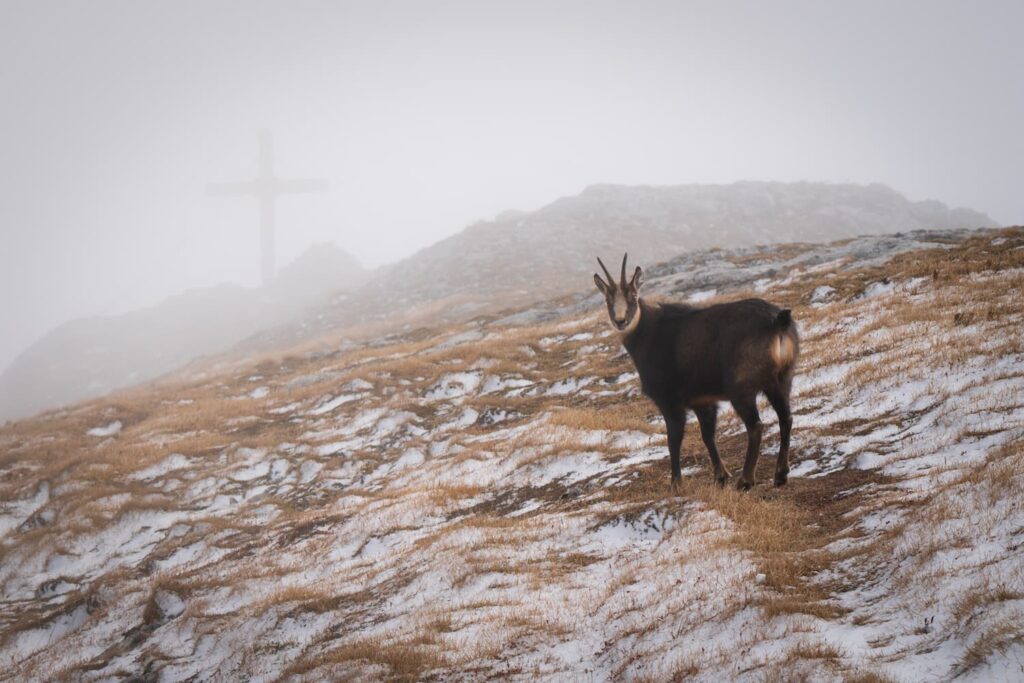
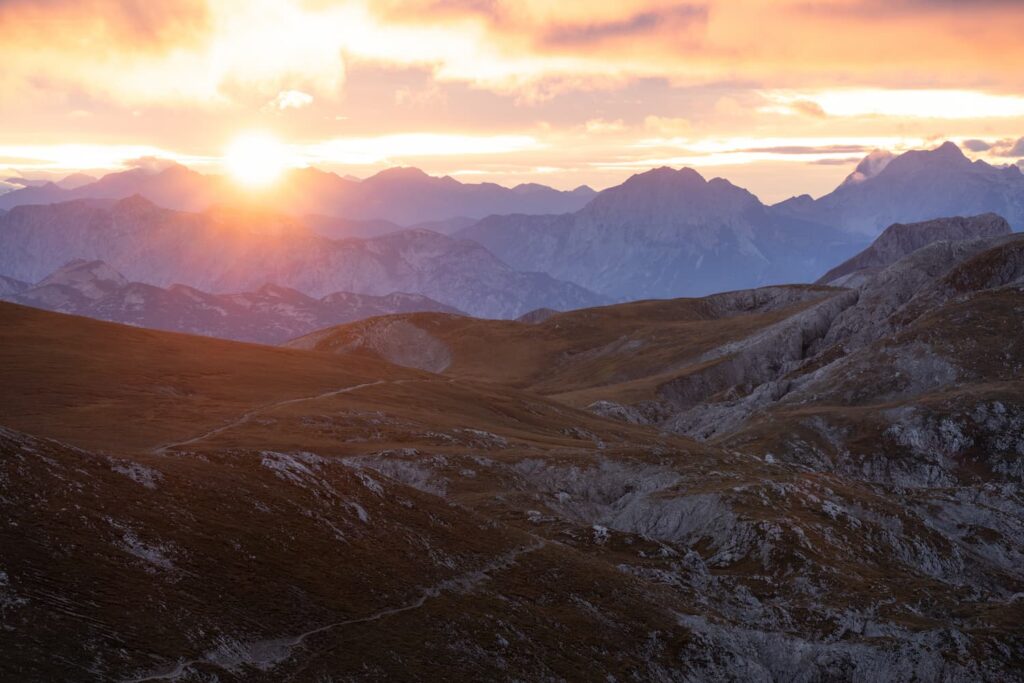
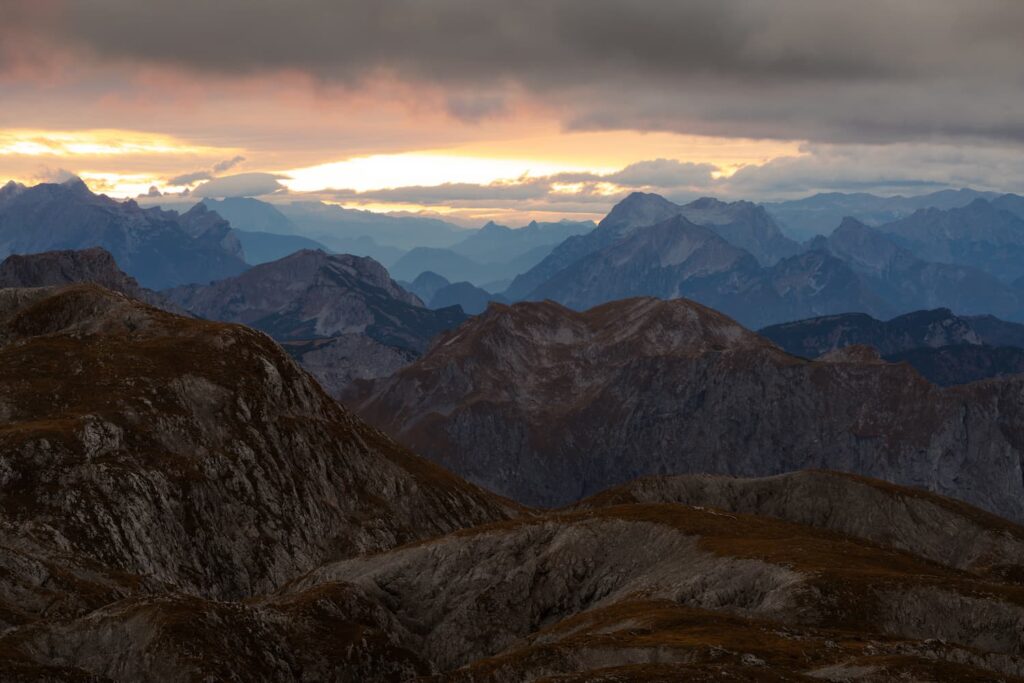

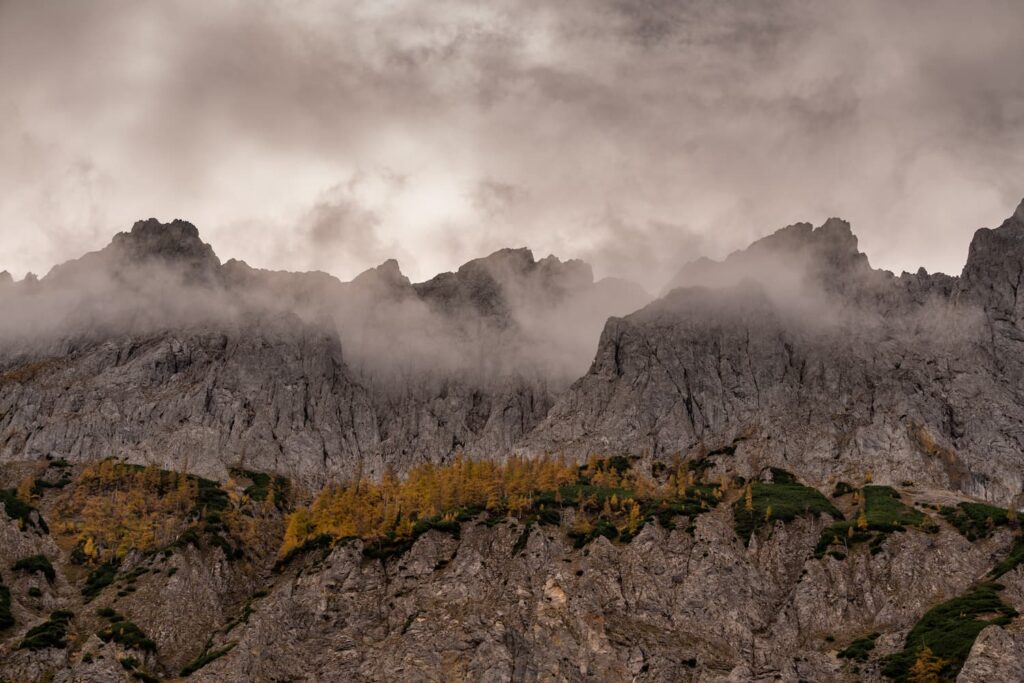
Innsbruck
We touched on Innsbruck a little in the Karwendel section up above but there is so much more to Innsbruck. Of course there is world class skiing and hiking. The city itself is stunning, it is after all, a major tourist destination.
We first visited Innsbruck in 2017 when we hitchhiked through Europe to Morocco, we couch surfed in Innsbruck and hiked up to an Alm with our hosts, through lovely autumnal forests. On a separate occasion we hiked around the ski jump – a simple hike through the forest and by a lovely emerald river squeezed into rust and auburn forests, their last mighty display of colour before the winter sets in.
The last time I visited Innsbruck was for a mammoth long distance hike planned with my friends from the UK in late September of 2024, that would unfortunately miserably fail due to extremely bad weather in all of Austria that resulted in severe floods in the low lands and insane amounts of snow in the mountains. Not a typical autumn.
What to do around Innsbruck
- Inntaler Höhenweg – The Inn valley high trail, a 7 day hike starting in Innsbruck and finishing in Schwaz where you can take the train back to Innsbruck.
- Karwendel Hike – A 3 day hike through the Karwendel mountains, see above for more details. It’s incredible in autumn, especially Eng Alm and the maple tree forest.
- Nordkette – The top of Innsbruck, take a funicular and then a cable car to the very top of Innsbruck where you can do a short hike to Hafelekarspitze with impressive views of mountains in all directions.
- Enjoy the old town – You shouldn’t pass up on Innsbruck itself, it has lots of nice restaurants, classic medieval architecture, cute cobbled streets, and much more.
- Visit Hall in Tirol – Another beautiful medieval town with an old town much bigger than Innsbruck.
- Achensee – The largest lake in Tirol.
- Wolfsklamm – A gorge hike with boardwalks and ladders.
- Visit castles and palaces – Georgenberg, Schloss Tratzberg, Burg Freundsberg, Schloss Freidberg and too many more to mention!
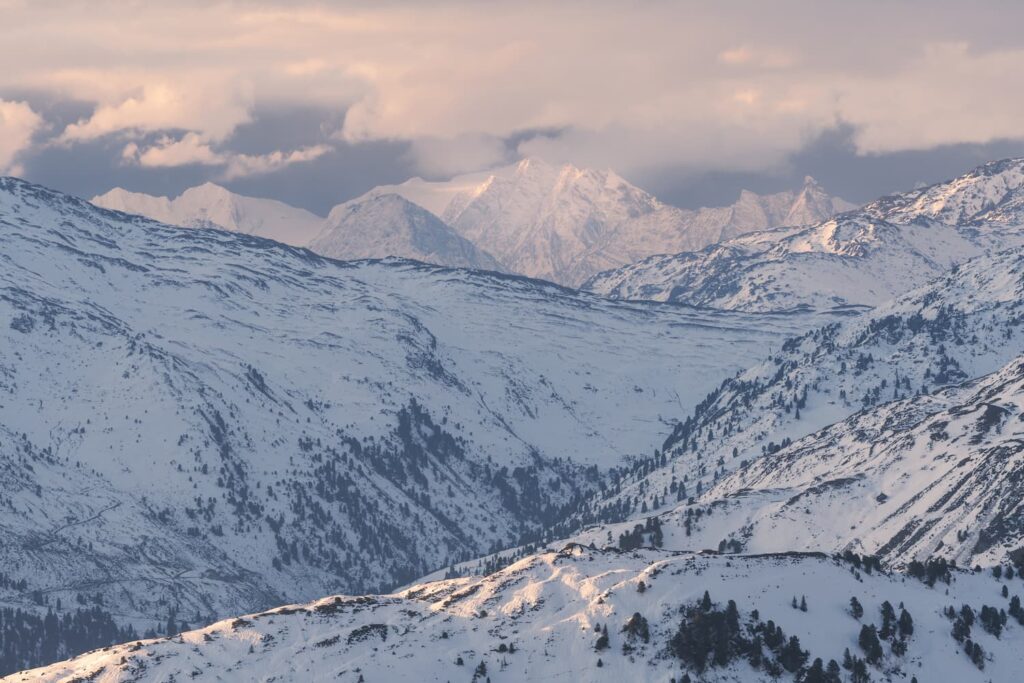
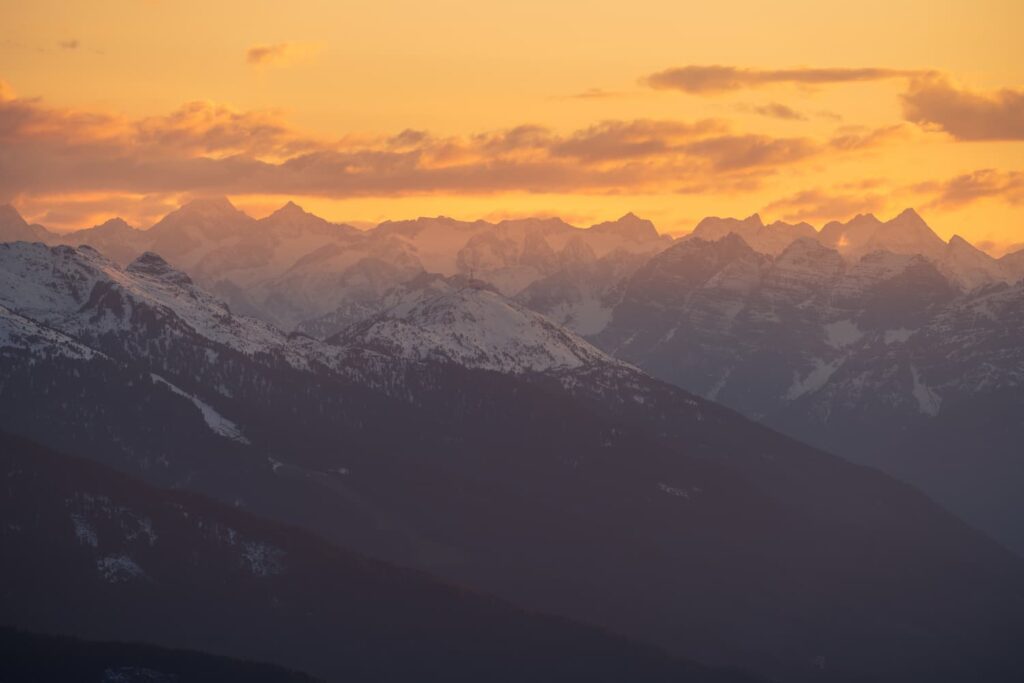

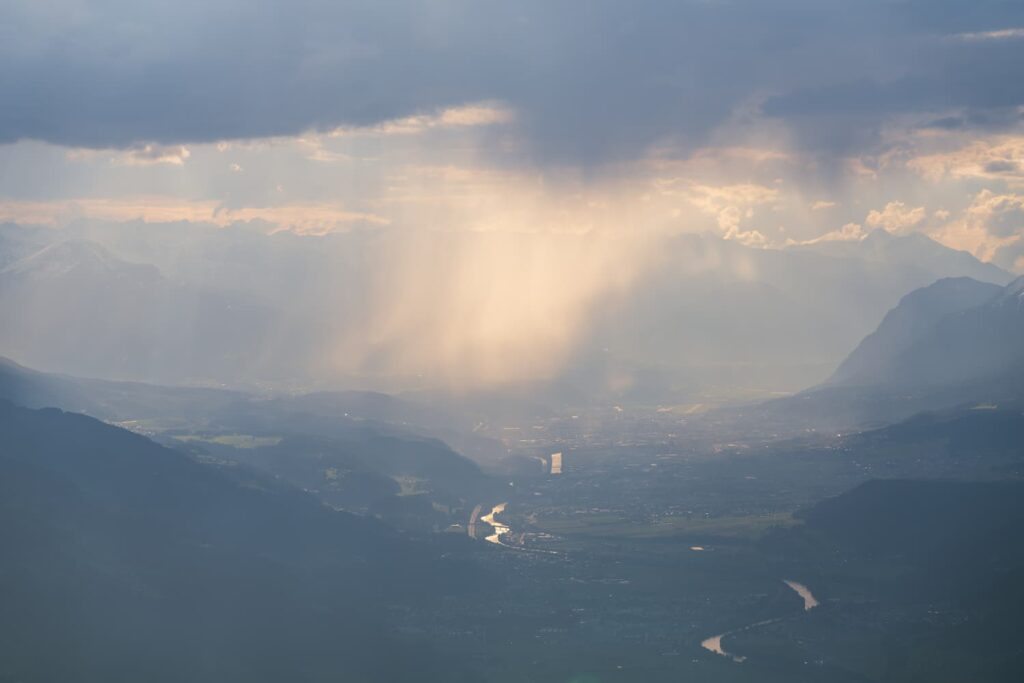
Südsteiermark – Wine Country
Shhhh, Südsteiermark is a bit of a secret destination. Of course in Austria it’s a well known destination, but it doesn’t yet seem to be on the radar of international travellers. Anyway, it’s a paradise of vineyards, rolling hills, forests, hilltop villages, churches and chapels, straggling the border of southern Austria and Slovenia in the county of Styria (Steiermark). It’s famous for wine and many small family run wineries called Buschenschanken exist all over the landscape offering traditional food such as cold cuts, cheese, pickles and salads along with the local wine. The area is often referred to as the Tuscany of Austria.
We first visited in the height of Summer and while it was incredible, especially as we stayed a bit higher up the mountain at Alban Berg Villa – it’s rather hot. Because we were mostly hiking, it was a bit of a struggle. Next time we opted for autumn, and well, see for yourself. It was perfection, the landscape canvassing a thousand different colours, seas of vibrant autumnal hues, the vineyards glowing copper, rolling and rolling over the endless hills. It was and is truly magical. I can’t wait for next autumn to return.
What to do in Südsteiermark
- Hike, it’s the best way to experience the landscape in our opinion, right through the vineyards. Some of our favourites:
- Sulztaler Rundwanderweg – A short hike through vineyards and Buschenschanken
- Greith Genusstour – A tour around a charming less visited wine area
- Großer Hochgrail – Niedergrail Rundweg – A lovely tour through the vineyards and beautiful old houses around the Schilcherstraße
- Gamlitz Rundwanderweg
- There are many more hikes, you can basically walk anywhere and it’s stunning. We would recommend to check for hikes near where you are staying.
- Check out some of the epic viewing towers/view points in the area (although there are great views on basically any of the high roads):
- Kreuzbergwarte
- Aussichtswarte Demmerkogel
- Aussichtswarte Buchenberg
- Stainzerwarte
- Razgledni stolp Plač – In Slovenia, just over the border
- Lubekogl
- Wasserturm Weinleiten
- Visit charming towns & villages, some of our favourites are:
- Gamlitz
- Ehrenhausen
- Deutschlandsberg
- Stainz
- Sankt Stefan ob Stainz
- Langegg an der Schilcherstraße
- Kitzeck im Sausal
- Seggauberg
- Osterwitz
- Visit a Buschenschank, our favourites are:
- Castles, Monasteries, Palaces
- Schloss Ottersbach
- Schloss Hollenegg
- Schloss Stainz
- Burg Deutschlandsberg
- Drive the wine streets (You can find a not very good map here – but when you are there, you can follow the many signposts
- Klapotetzstraße – Through the area of many traditional wooden windmill like structures named Klapotetz
- Alte Weinstraße
- Südsteirische Weinstraße
- Schilcherweinstraße – This one is not on the above map, this map is also much better.
- Drive the small mountain roads, for example up to Weitensfeld and on to the village of Osterwitz. Then you can drive to Klosterwitz and further to Sallegg. You can keep on going eventually making your way back down to Stainz.
- Hike on the Großer Speikkogel mountain for views over all of Südsteiermark.
- Visit the heart street (Herzerlstraße) that everybody on Instagram loves – do be aware you have to pay for the famous view.
- Visit the adorable small chapels dotted around the landscape, especially Dreisiebner Kappelle, Kapelle Hohenegg Schloßberg, Wielitscher Kapelle and Altenberg Kapelle zur Hl. Muttergottes.
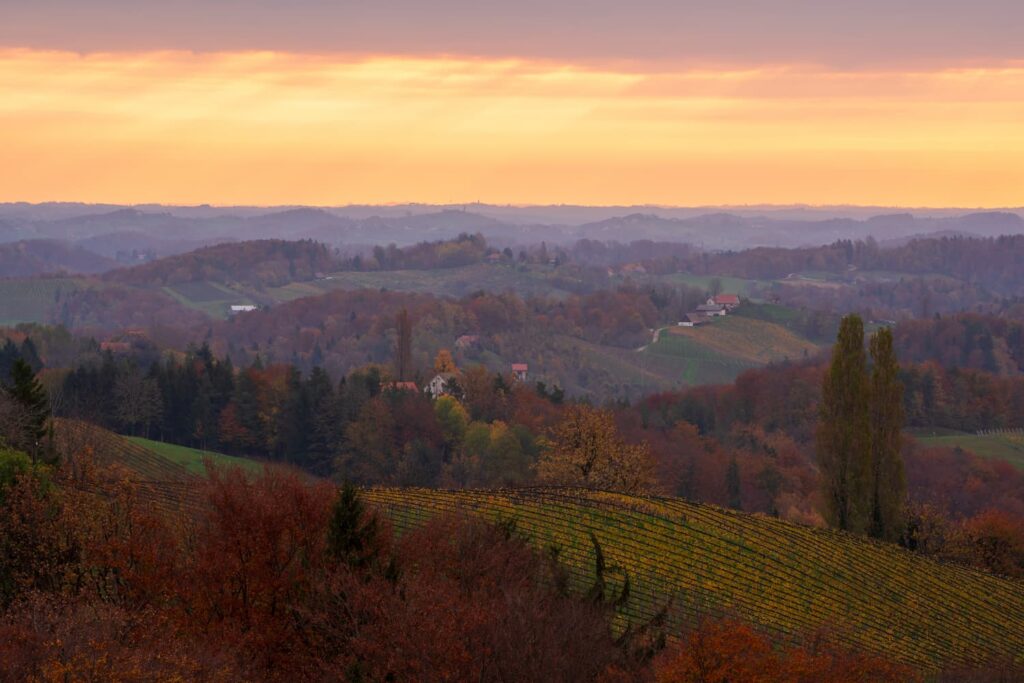
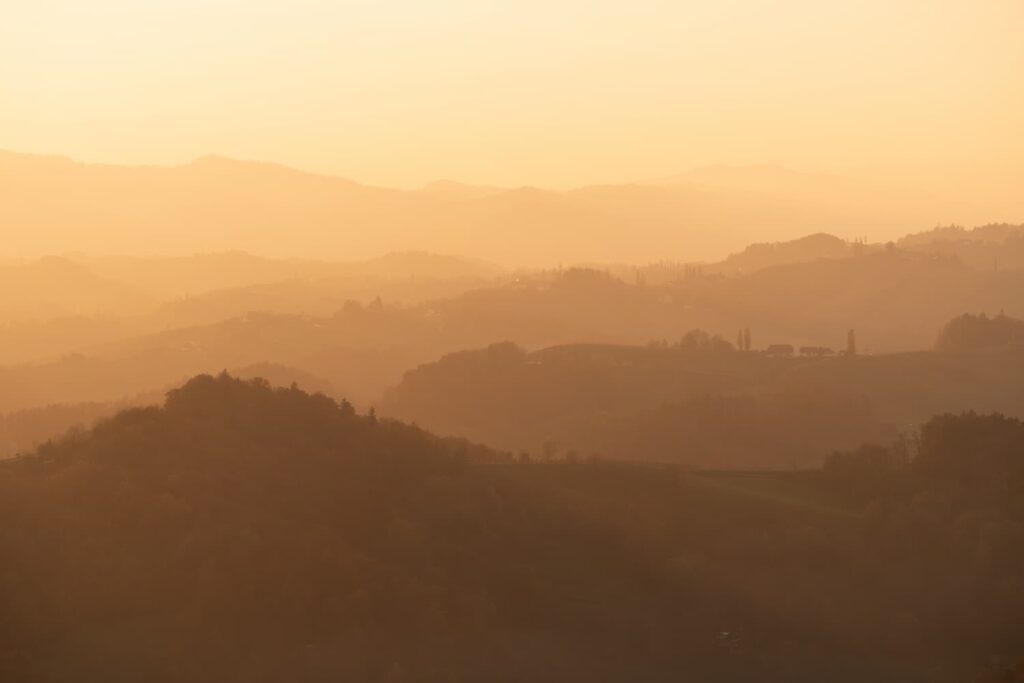
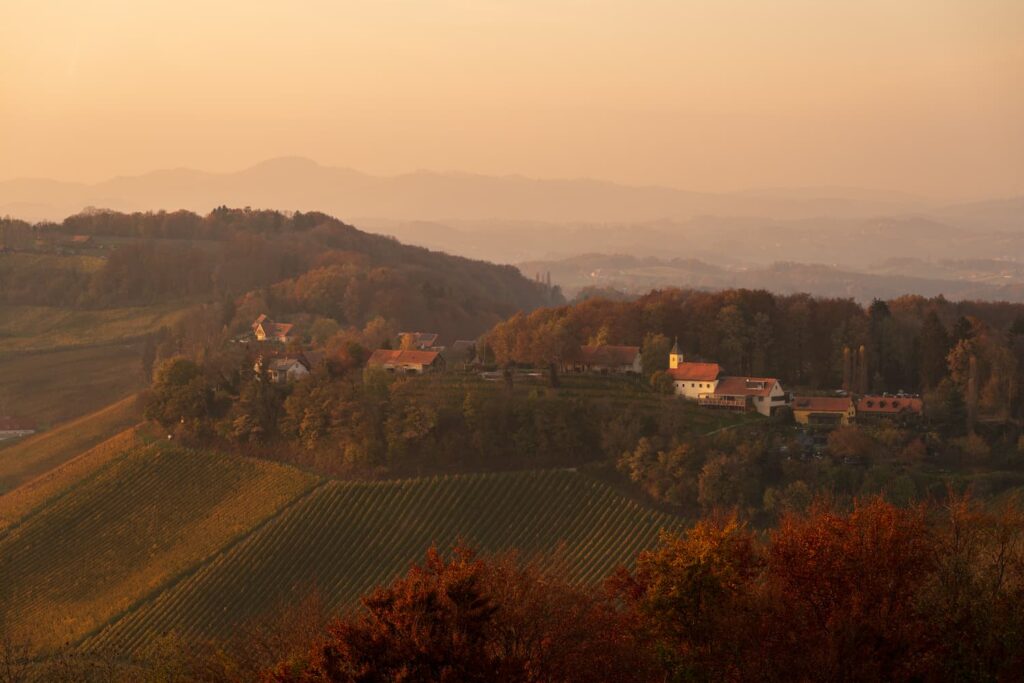
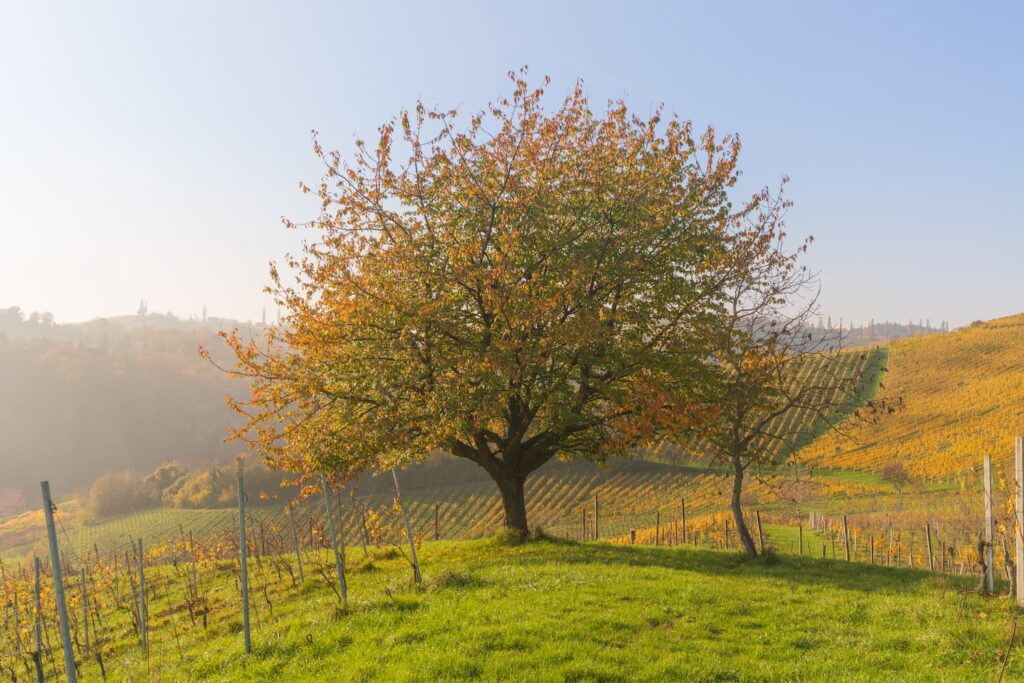
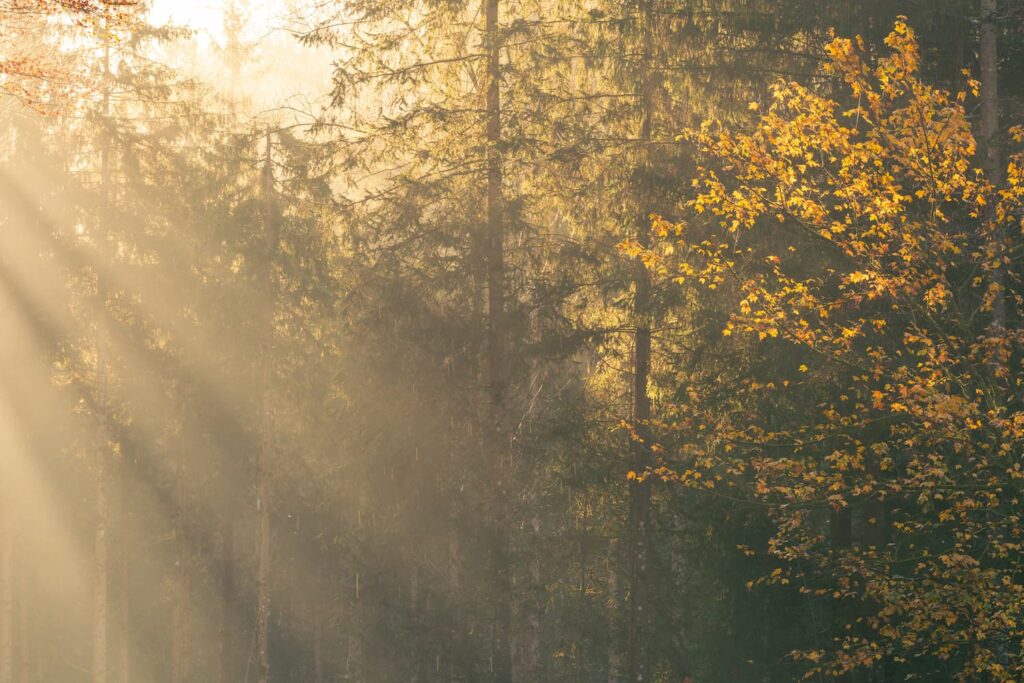
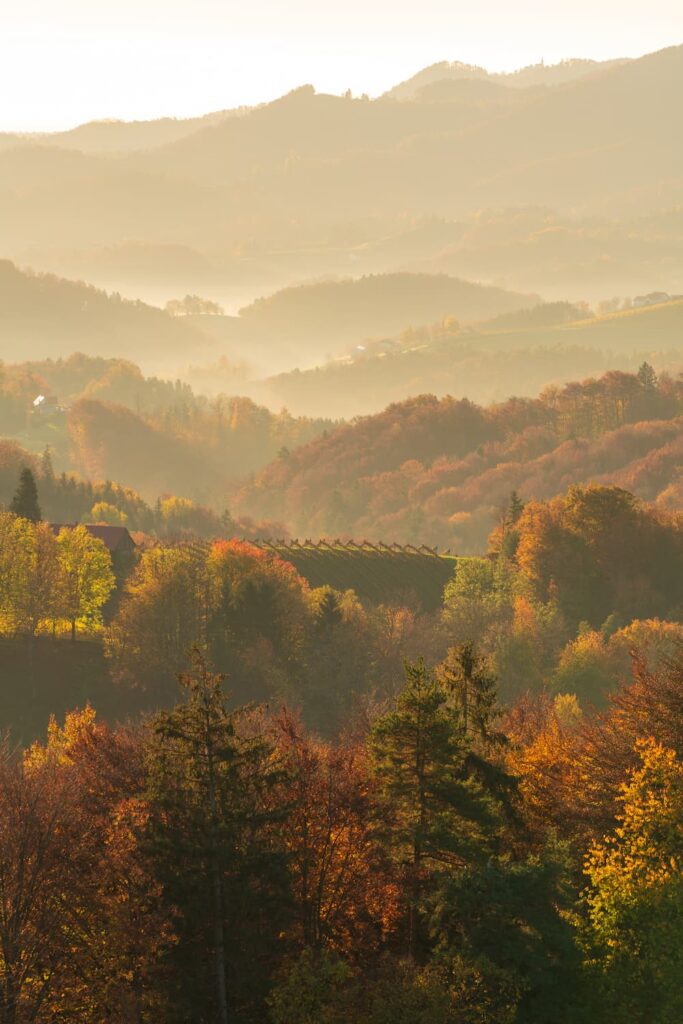
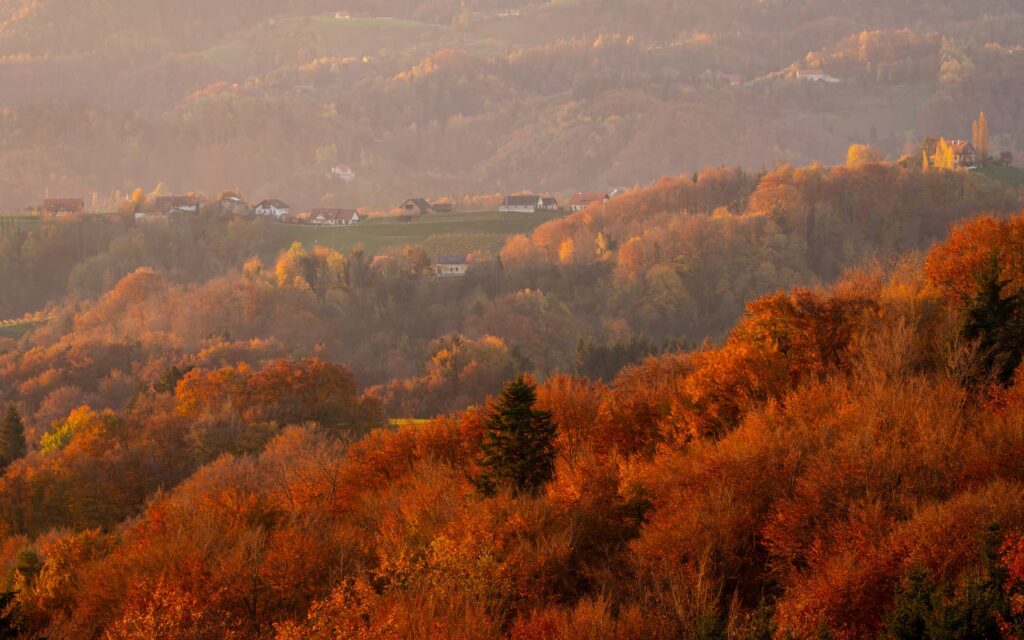
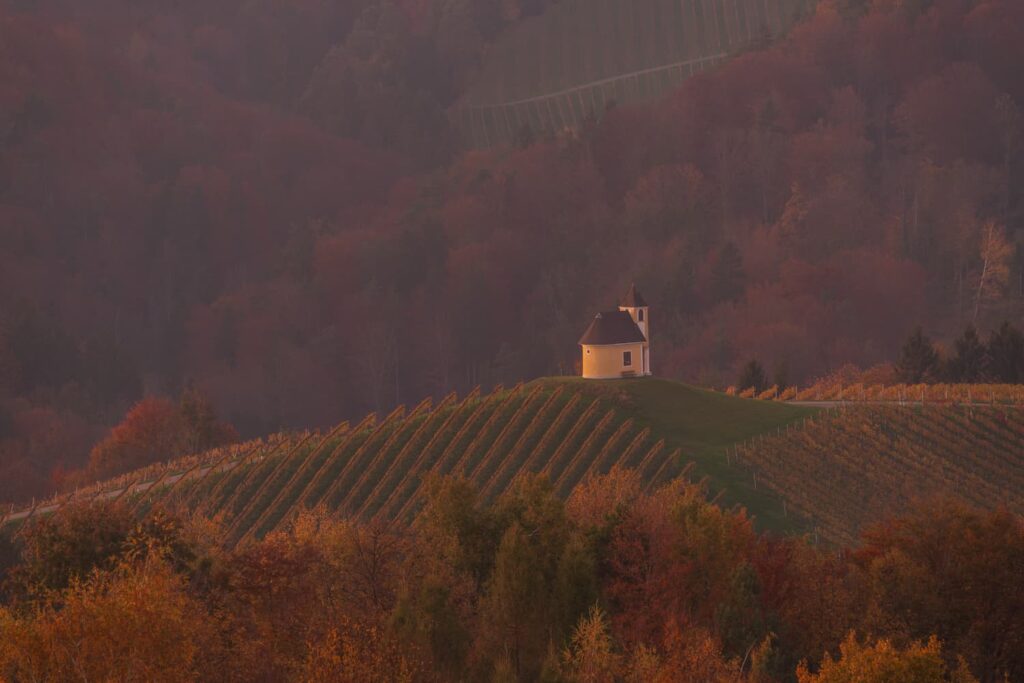
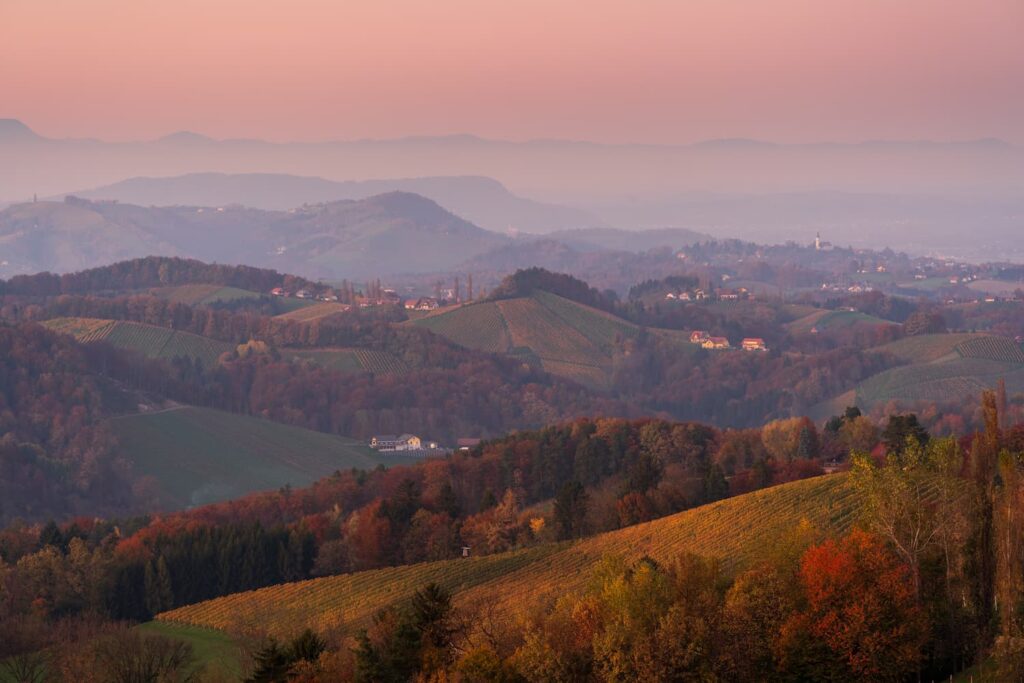
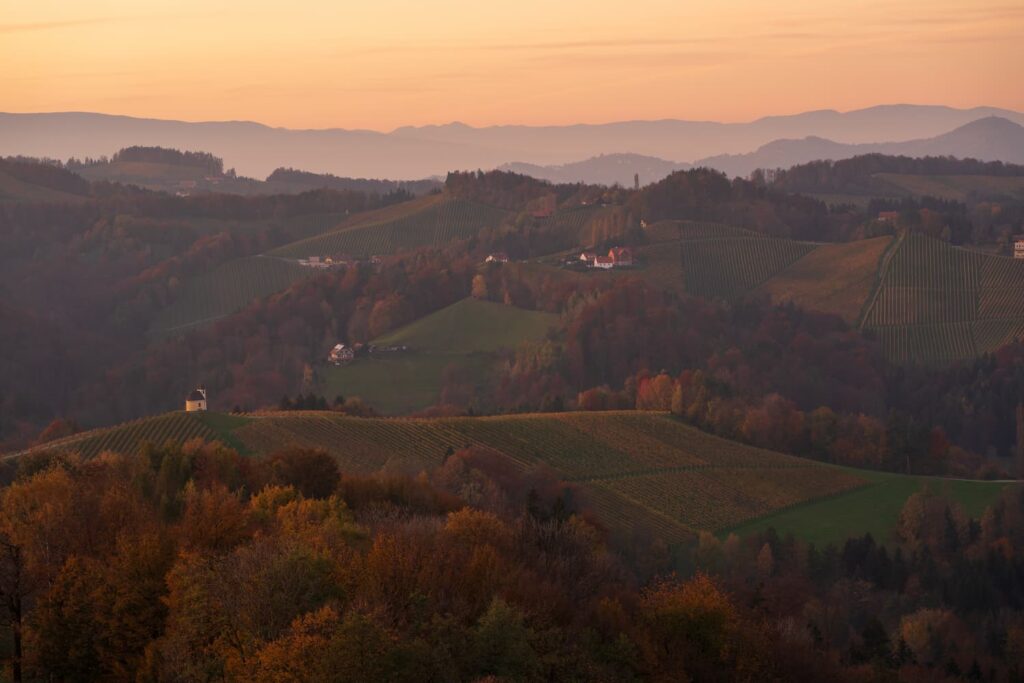
Middle Carinthia (Mittelkärnten)
Upper and Lower Carinthia are both pretty well-known, Großglockner, the Hohe Tauern, the river Drau and the incredible Karawanken mountains, but what about Middle Carinthia? Well it just so happens to be the birth place of Caroline and an unfathomable amount of beauty. We’ve had the privilege of exploring this region in all seasons, but as is this theme of this post: autumn is the best. At least in my opinion: my mother in law hard disagrees!
While the valley floor is often covered in fog leading the inhabitants of the small villages to feel an impeding sense of doom, a short ride up the mountain and quite often the peaks are shimmering in sunshine: and if not, the colours of the forest smothered in creeping, mysterious fog make for ethereal exploration.
Anyway: we wrote a whole post on Middle Carinthia, so if the pictures have you hooked, check it out.
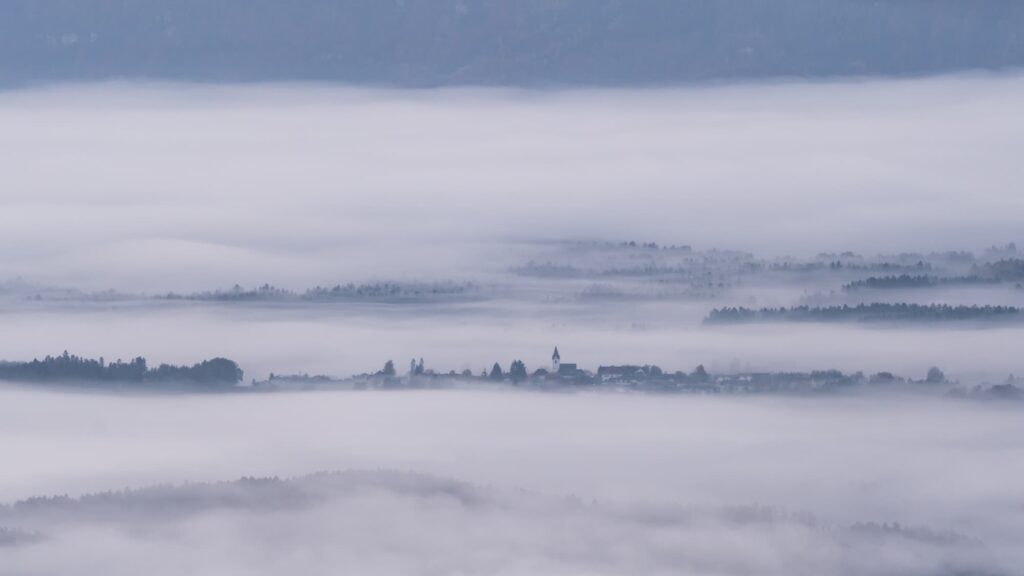
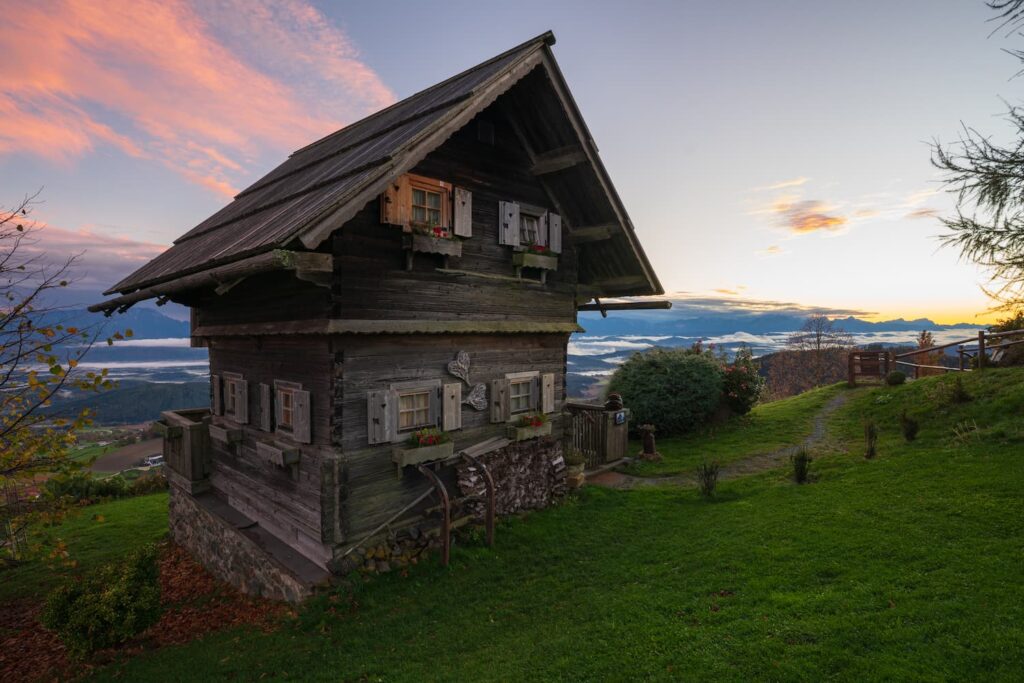
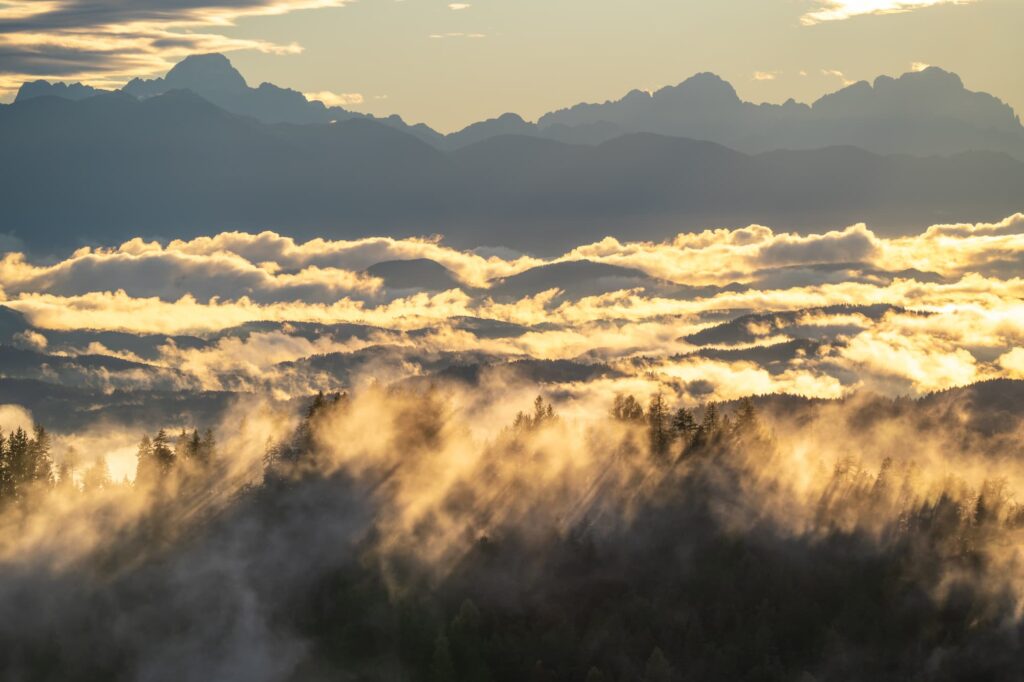

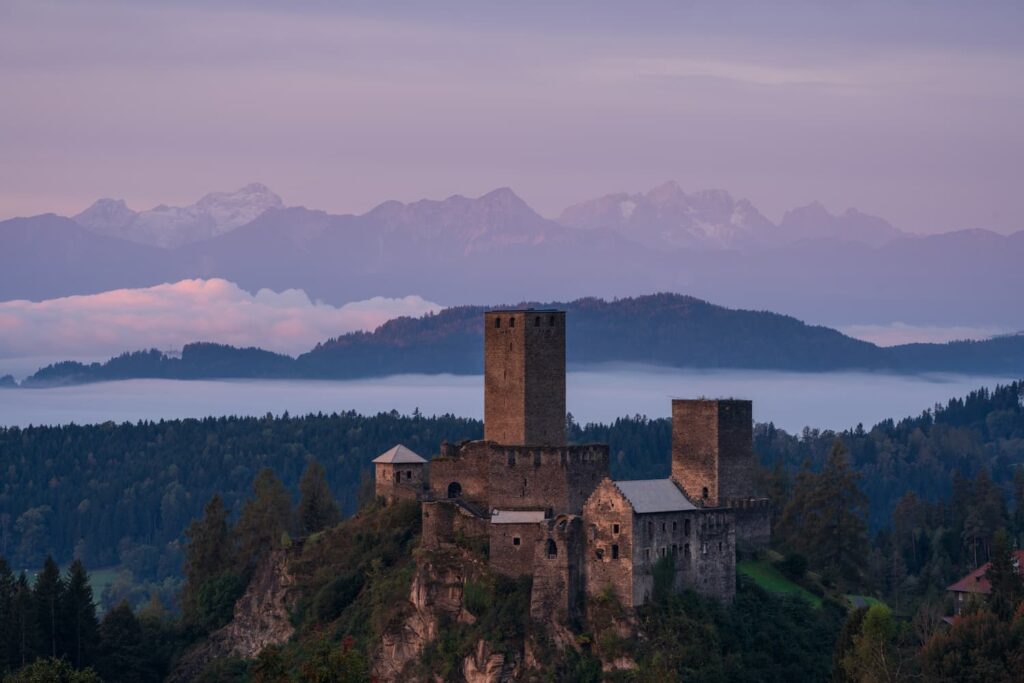
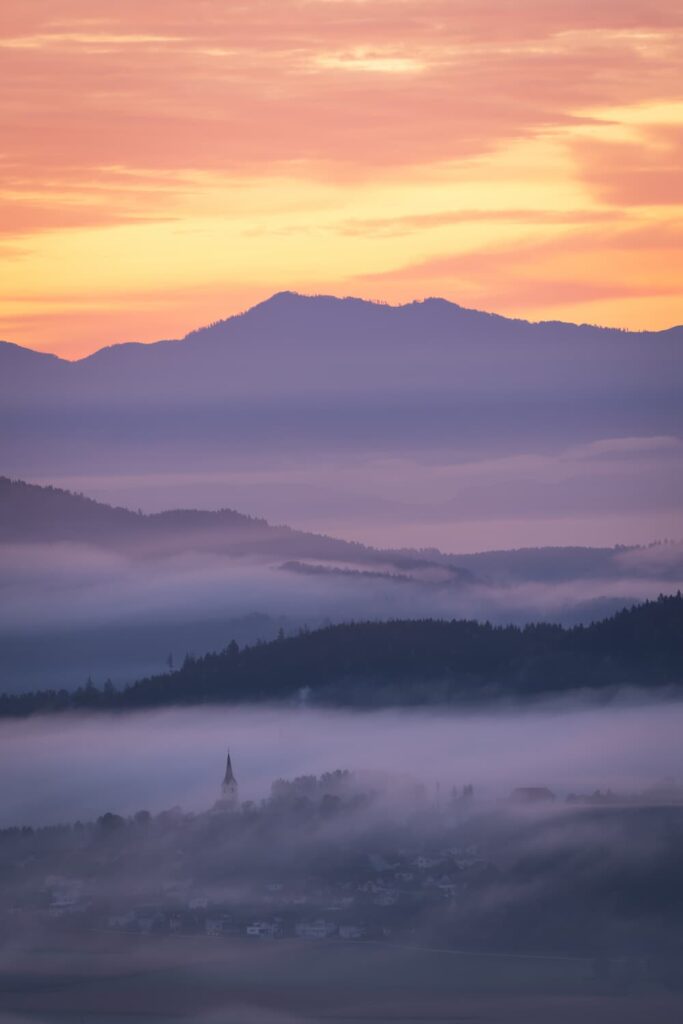
Puster Valley
One of the largest longitudinal valleys in the Alps, only a small 30KM section of Puster Valley (Pustertal in German) is located in Austria (the rest is in Italy). The section from Lienz to Sillian lies in the Austrian district of Osttirol.
There is a high mountain road, Pustertaler Höhenstraße, one of my favourite in Austria that winds its way through many of the tiny villages, farmhouses and idyllic churches and chapels located on the sundrenched slopes of the Villgratner mountains. We’ve visited a few times, often on the way to or from some other place. We plan to stay longer in the future to explore the hiking trails, of which there are many.
The road in some places is incredibly tight and oftentimes you can take detours to explore even more remote corners. In Bannberg there is a toll road which allows you easy access to Hochsteinhütte – a mountain hut situated at around 2000 meters. Here you will find hiking and snow shoe trails.
From the top and many of the villages and of course the high road, there are magnificent views of the Lienz Dolomites (Lienzer Dolomiten) – some of the most imposing peaks in Austria, in our opinion. Also host to one of the most impressive mountain huts/hotels in Austria: Dolomitenhütte. We stayed there back in 2020 – good luck getting a room now!
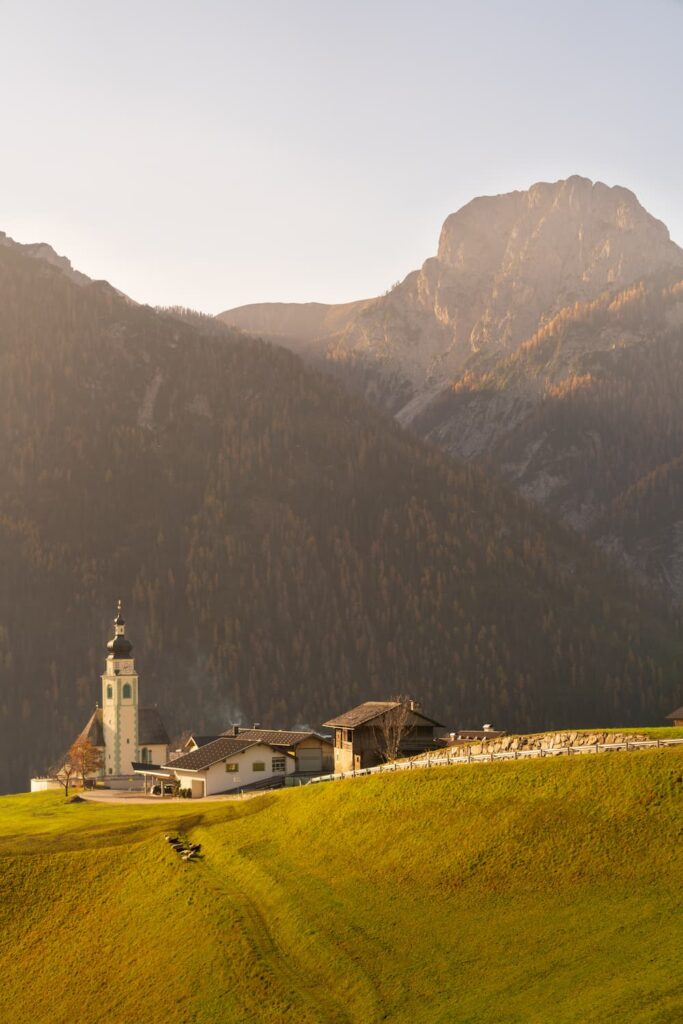
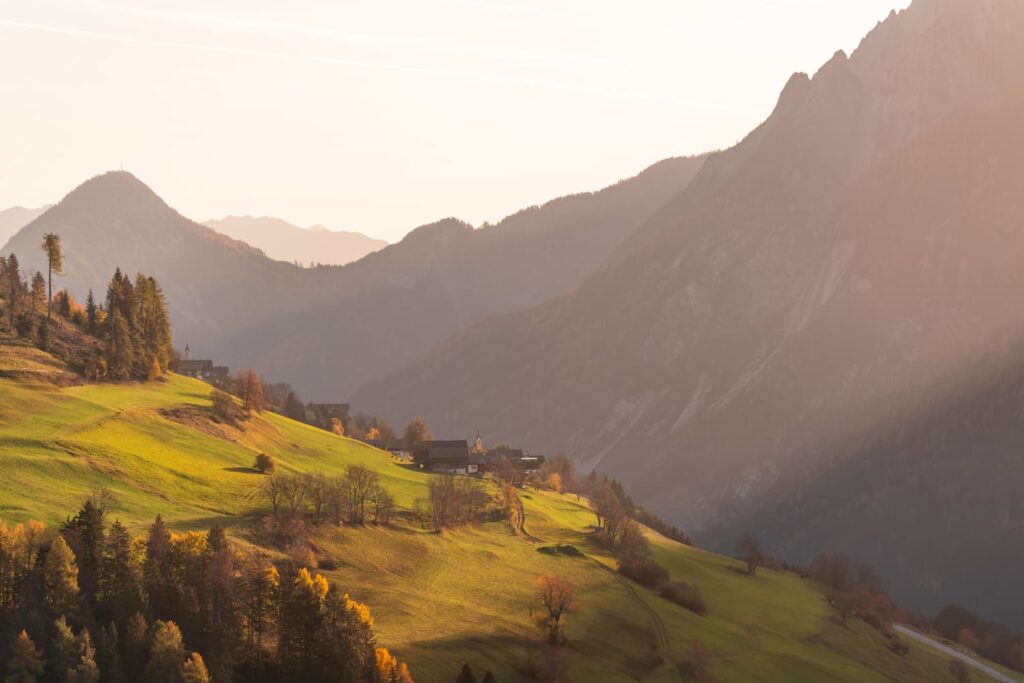
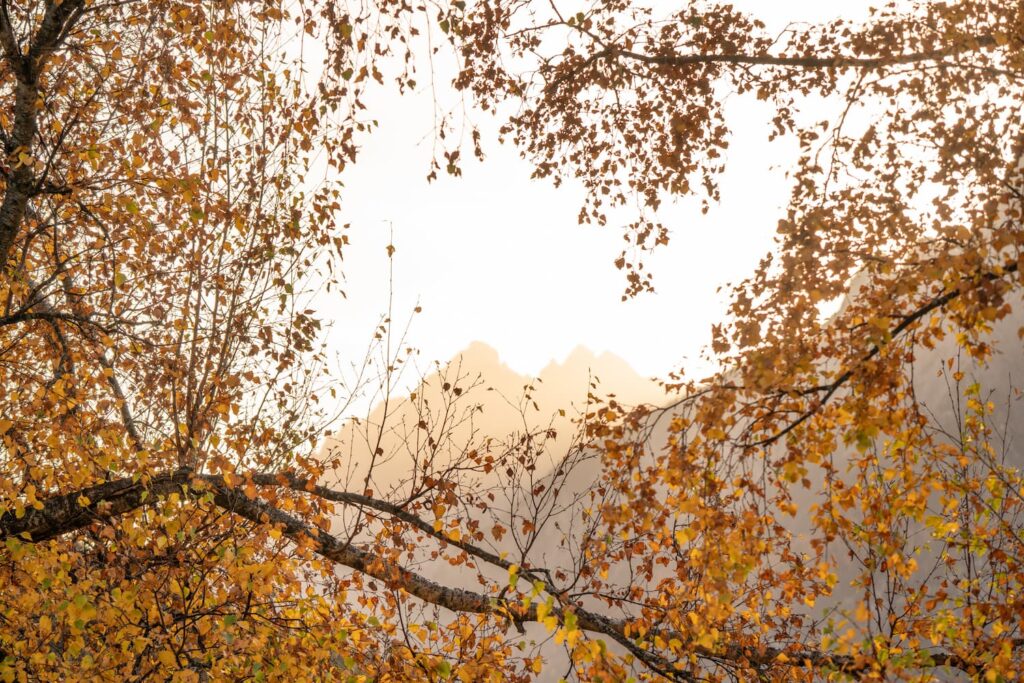
Semmering – Historic mountain resort
A mere hour away on the train from Vienna, you will find Semmering: a historic mountain resort in the county of Lower Austria. It’s best know because of the Semmering Railway, a UNESCO World Heritage Site and one of the first true mountain railways in the world, completed in 1854, designed and directed by Karl Ritter von Ghega. It features a staggering 14 tunnels, 16 viaducts and over 100 stone bridges, many of them almost works of art, seamlessly integrating in to the mountain landscape. The line is one of the main arteries to the south of Austria and Northern Italy as it directly connects Vienna to Venice. It’s a fantastic journey in any season, but of course autumn is one of the best, a good winter not far behind!
While the village existed before the railway, it was transformed by the ease of access from Vienna and thus attracted many of the citiy elites, artists and royalty. Villas and grand hotels were constructed and for a while it existed as glamorous mountain retreat, famed for its air. After the wars and the demise of the Habsburg empire, Semmering fell out of fashion. Travel trends shifted and for the most part the hotels lay empty. In recent years there’s been a bit of an uptick in visits, especially since there is a ski slope (Zauberberg) and many hiking opportunities. Semmering is worth a visit, if not only to admire the fantastical architecture and admire the sweeping views. We’ve visited many times and never get bored – it’s a perfect day trip from Vienna.
What to do in Semmering
- Admire the magnificent grand hotels: Südbahnhotel Semmering, Grand Semmering & Grandhotel Panhans – most are closed but there are some occasional cultural events. For example there are various tours in the Südbahn hotel, check the website for more details. We attended a tour and also visited during an indoor Christmas market. It was a lot of fun!
- Semmering train station museum – The small museum in the train station has some nice information about the railway and the area with a cute working model of the Semmering train and mountains. You can also buy some really nice old school art nouveau advert posters.
- Kaffeehalle Semmering – A cool modern coffee house with great coffee, lots of books and nice views.
- Walk to one of the many nice view points – There are many great view points around Semmering with magnificent views over forests, mountains, villas and castles. A few of the best: The lookout tower, 20 Schilling View, Südbahnhotel viewpoint & Semmering Viewpoint.
- Hike the Semmering Railway – Hike along the various sections of the railway at over 70KM from Semmering to Payerbach. In our opinion the first few stages to Klamm are the best, but all of it is really nice and the towns of Gloggnitz & Payerbach are really beautiful.
- Hike to Maria Schutz, a small pilgrim village with a beautiful church and monastery.
- Visit Burg Klamm in Breitenstein – Unfortunately you cannot go inside the castle, but there are many great views of the castle around the area.
- Go skiing in winter, along with other winter sports.
- Lots of other hiking trails. Some that we enjoyed:
- Semmering Railway – As mentioned above, a long hike along the bridges and viaducts of the Semmering railway.
- Sonnwendstein – A peak above Semmering with a viewing tower and majestic views.
- Around Semmering – Just over 10KM hike around the main viewing points of Semmering.
- Kampalmtour – A nice hike along the ridge behind Semmering, ending in Spital am Semmering where you can catch the train back.
- Großer Otter – A trail and peak with great views of Raxalpe and Schneeberg.
- Polleroswand Panorama trail – A trail with lots of great views of Burg Klamm, Semmering and the surrounding villages.
